

Ultimate Guide to Train Travel in Switzerland (2024 Update)
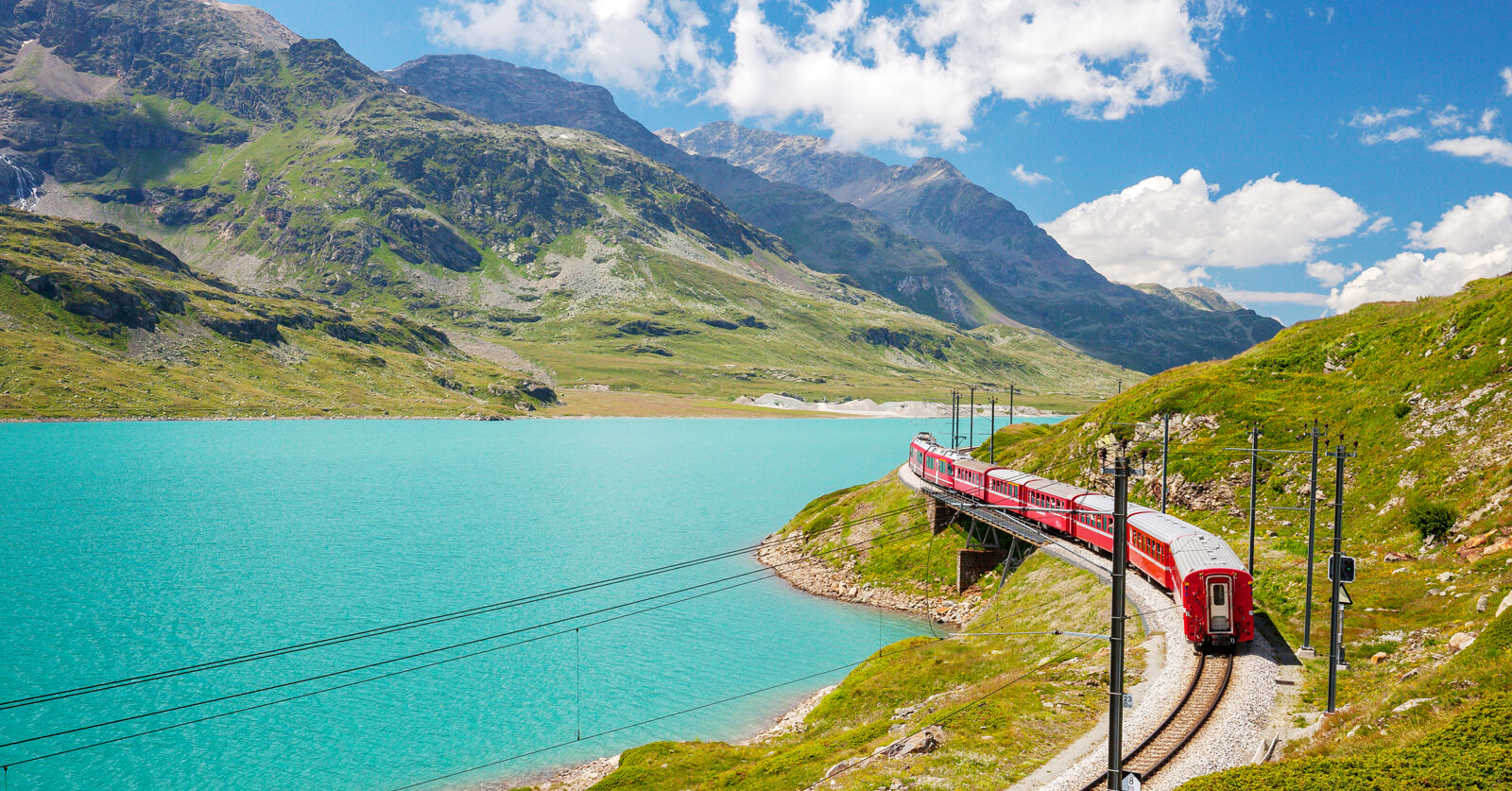
In Switzerland, train travel is more than a simple mode of transportation. Granted, thanks to the world’s most dense public transportation network, the Swiss travel more kilometers by train than any other country.
The Swiss trains, trams, buses, and boats are meticulously scheduled so that transfers are smooth and efficient. Almost all railway lines run at least once an hour, and the busiest routes run every half hour or even every 15 minutes. And for the so-called last mile from the station to the door, a bus, tram, or cable car awaits the arriving passengers.
Regardless of the operating company, all modes of transport are integrated into a single master timetable across the country. It truly is a Swiss travel system .
But in this country boasting nearly 5000 km of railway tracks, train travel is also a major leisure activity. Numerous scenic railway journeys are part of the Grand Train Tour of Switzerland, a network of routes that connect the major sights. It allows tourists to see the best of Switzerland while traveling by train from one destination to another.
This ultimate guide to train travel in Switzerland showcases how the Swiss Travel System works: from types of trains to popular itineraries and ticket options.
All About Train Travel in Switzerland
Grand train tour of switzerland, train itineraries in switzerland, how to travel by train in switzerland, faqs about train travel in switzerland, train types in switzerland, panoramic trains.
In a country known for its scenic mountains, glaciers, and lakes, it only makes sense to run trains that offer the best views out the window. There are several noteworthy panoramic train lines in Switzerland, each offering oversized window panes to reveal every mountain peak to those seated in their cushy coaches.
Here are the top panoramic trains in Switzerland:
- Bernina Express : This train takes you through the Swiss Alps from Chur to Tirano, Italy. It crosses the Landwasser Viaduct, one of the world's most famous and picturesque railway bridges. And it passes the Bernina Pass, the highest rail crossing in Europe, before presenting views of the Lago Bianco reservoir.
- Glacier Express : This train is considered one of the most scenic train rides in the world. It travels between Zermatt and St. Moritz across southeastern Switzerland, passing 91 tunnels and 291 bridges. Highlights of the route include alpine meadows, typical Swiss villages, the 2033-meter Oberalp Pass, and the Vorderrhein valley. And since it takes about 7.5 hours to complete, it is often touted as the slowest express train in the world. Lunch is served in first class, seat reservations are mandatory, and the trip runs year-round in both directions.
- GoldenPass Express : The latest panoramic train service runs up to four times daily between Interlaken and Montreux. Thanks to unique technology, the GPX can change the gauge of its wheels and the height of its coach bodies, making a transfer in Zweisimmen a thing of the past. The Prestige and first-class seats offer sweeping views of the diverse landscape between Switzerland's German and French-speaking parts.
- Gotthard Panorama Express : This journey starts with a serene steamboat ride across Lake Lucerne to Flüelen. From there, a panoramic train coach with Switzerland’s largest windowpanes picks up the course, then passes cliffs and cascading waterfalls en route to Lugano.
- Luzern–Interlaken Express: This train takes passengers on a journey through the heart of Switzerland. The route connects Lucerne and Interlaken, two popular tourist destinations in less than two hours. From the shores of Lake Lucerne, it passes Lake Lungern, crosses the Brünig Pass, and finally arrives at Lake Brienz in the Bernese Alps.
- Treno Gottardo : This fairly new line runs hourly and connects Basel, Zurich, and Lucerne to Locarno. As the name suggests, the train line runs along the 120-year-old Gotthard route and stops at the historically significant village of Göschenen. After passing through the Leventina valley, it runs along Lake Maggiore before arriving in the southern town of Locarno.
Jaw-Dropping Swiss Train Journeys (2024)
Memorable train lines in switzerland in 2024, intercity and regional trains.
A network of high-speed trains connects Switzerland’s cities. The ICN InterCity train lines run non-stop between major hubs such as Basel, Bern, Geneva, Lausanne, Lucerne, and Zurich.
Meanwhile, the regional lines of the Swiss rail network play a crucial role in connecting the smaller towns and villages. These lines often run through more rural and remote areas, providing access to lesser-known but equally beautiful destinations. Since the locals use these lines to commute, they are an authentic place for tourists to learn about Swiss culture.
Specialty Trains for Foodies
Switzerland has a variety of special train services catering to foodies, such as the Chocolate Train, Cheese Train, and Cookie Train. These trains offer a one-of-a-kind and memorable experience for any food lover.
The Chocolate Train is an absolute must-see for chocolate lovers the world over. The journey aboard the historic Belle-Epoque coaches lasts from Montreux to Montbovon. The chocolate bus connects to the Gruyère region, where you will visit the Maison Cailler chocolate factory in Broc and stroll through the charming Gruyère old town. Admission to the show dairy, as well as coffee and chocolate bread, are included.
The Cheese Train provides a one-of-a-kind experience for cheese lovers. The journey also begins in Montreux and continues to Château-d'Oex, where you can enjoy a delicious cheese fondue. Two museum visits are included: "Espace Ballon," about the history of hot-air ballooning, and the new Swiss Museum of Papercuts.
And finally, the Kambly Cookie Train is a must-try for any sweet tooth. The train line connects Bern and Lucerne through the Emmental valley. The idea is that you can take an entire day to enjoy the scenery along the way. A definitive highlight is a visit to the "Kambly Experience," a cookie bakery in Trubschachen. And there’s an optional boat cruise from Brienz to Interlaken Ost.
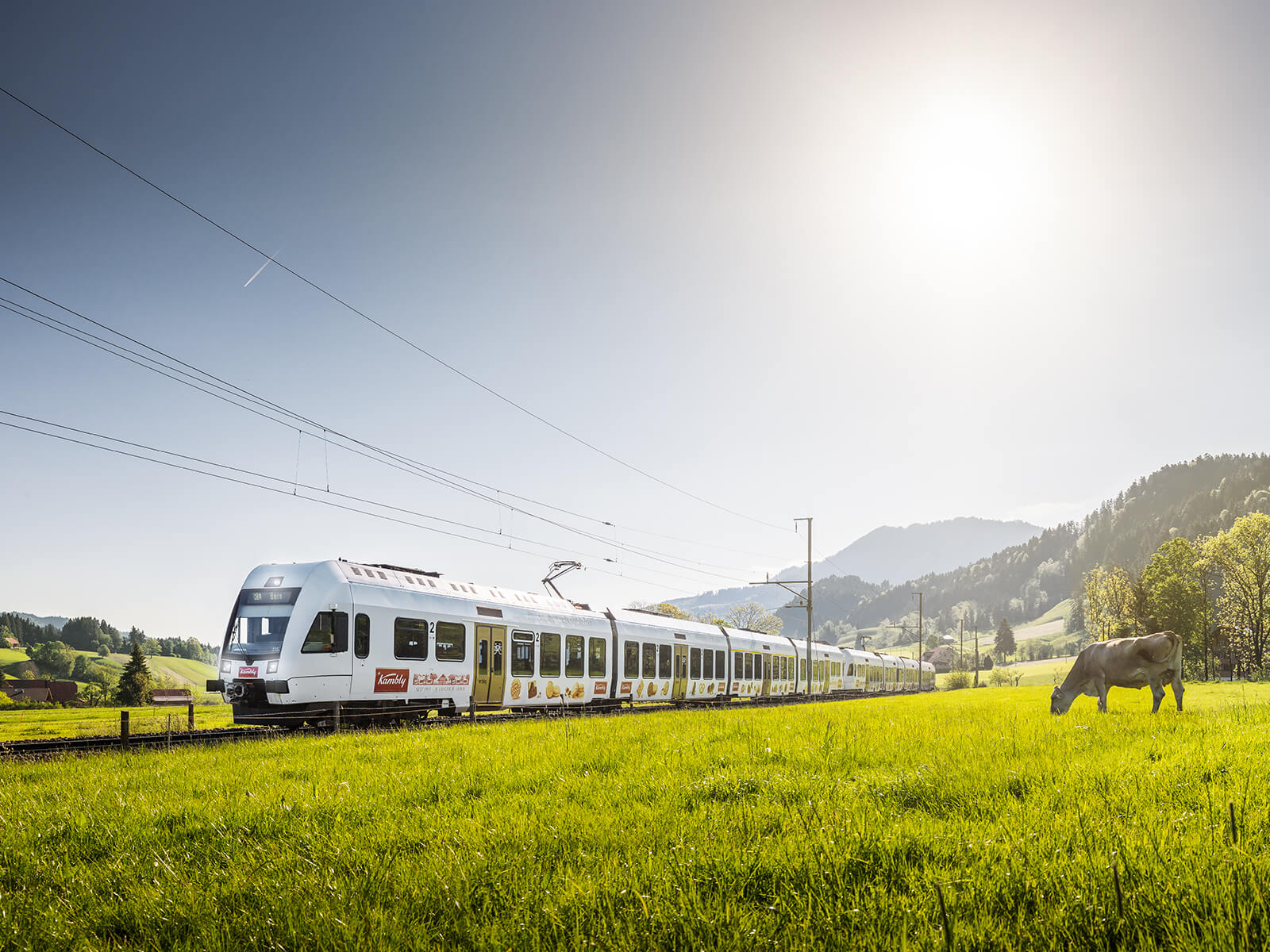
International High-Speed Trains
Thanks to a dense network of international trains, Switzerland is conveniently connected to European destinations. Cutting-edge high-speed trains provide amenities to ensure a comfortable and convenient journey. Business travelers will appreciate the on-board business centers equipped with power outlets and Wi-Fi. Those looking to unwind will appreciate the bistro coaches and restaurant cars - some of which even serve local specialties from the carrier’s country.
International high-speed trains from Switzerland:
- EuroCity: Bologna, Genova, Milan, Venice
- ICE : Berlin, Dortmund, Frankfurt, Hamburg, Hannover, Mannheim, Munich, Stuttgart
- RailJet : Bregenz, Graz, Innsbruck, Salzburg, Vienna
- TGV Lyria: Paris, Marseille
Interactive map of international train connections to Switzerland
Overnight Trains in Switzerland
Thanks to a growing network of overnight trains across Europe, you can see a musical and put on your PJ in Amsterdam, then sip your morning coffee in Zurich.
The increasing demand for climate-friendly travel alternatives has launched a rebirth of overnight train connections. They provide a comfortable way to travel to and from Switzerland - with significantly fewer emissions than airplanes.
Overnight train compositions come in different setups. There are sleeper cars with private compartments featuring beds, sinks, and breakfast service. Sleeper car compartments have space for one to three persons. Deluxe rooms include a shower and toilet.
So-called couchette cars have compartments with four to six bunk beds and shared facilities.
Women-only sections, plus family-friendly and accessible compartments, are available. And finally, overnight trains have regular coaches with seating.
Overnight trains and destinations from Switzerland:
- ÖBB EuroNight: Budapest, Dresden, Leipzig, Ljubljana, Prague, Vienna, Zagreb
- ÖBB Nightjet: Amsterdam, Berlin, Cologne, Hamburg
- From 2024: Barcelona, Rome
Interactive map of overnight trains in Switzerland
The Grand Train Tour of Switzerland is the ultimate train journey through the heart of Switzerland. This round trip offers a complete and comfortable experience, taking visitors to the country's most popular sights and landmarks.
Along a staggering journey of 1280 km, train lovers can check the top experiences of Switzerland off their bucket lists. Consider it “two birds with one stone”: an epic train journey to highlights such as Lucerne, impressive natural spectacles like the Rhine Falls, and majestic peaks like the Matterhorn.
The Grand Train Tour of Switzerland passes no less than 11 lakes and includes five panoramic train lines, making it a unique and unforgettable Swiss train journey. This experience is available year-round, and you can start and finish your journey wherever it is most convenient.
The Grand Train Tour of Switzerland is divided into eight sections:
- Zurich – Lucerne – Interlaken (131 km, 2:45 h)
- Interlaken – Montreux (120 km, 3:15 h)
- Montreux – Visp – Zermatt (148 km, 2:30 h)
- Zermatt – Chur – St. Moritz (291 km, 7:45 h)
- St. Moritz – Tirano – Lugano (183 km, 6:30 h)
- Lugano – Flüelen – Lucerne (182 km, 5:30 h)
- Lucerne – St. Gallen (125 km, 2:15 h)
- St. Gallen – Schaffhausen – Zurich (133 km, 2:30 h)
Download the Grand Train Tour of Switzerland map
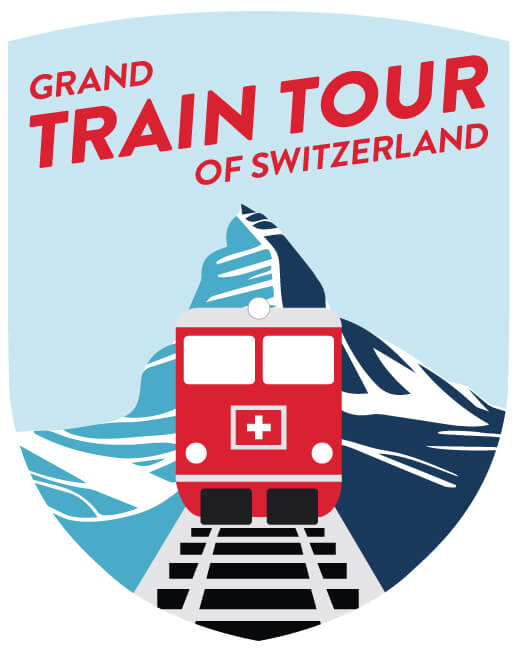
Switzerland's train system is like a journey through a storybook, with popular routes like the Glacier Express as the main chapters. Each route offers a different tale, taking passengers across historic viaducts and past mighty glaciers. Whether you're a railway enthusiast or simply looking for a scenic way to travel, Switzerland's trains provide an immersive soundtrack for your journey.
Most Popular Train Lines in Switzerland
The Glacier Express , often heralded as the world’s slowest express train, wins our nomination for the most popular train line in Switzerland. It is regularly booked down to the last seat, treating the lucky passengers to a visual extravaganza through the large panoramic windows.
Here are other popular train lines in Switzerland that we have covered in detail:
Switzerland Train Itinerary for Rail Lovers (2024)
How to travel switzerland by train in 5 days, lesser-known train lines in switzerland.
Switzerland is a dream destination for railway enthusiasts. Apart from the usual suspects, there are numerous lesser-known train lines in Switzerland.
Alpine Cruise: We had the pleasure of experiencing the Alpine Cruise train experience that winds through the canton of Graubünden. The idea is that your luggage is shipped from one hotel to the next - just like on a cruise ship. Meanwhile, you get to travel on the iconic red trains of Rhaetian Railway to places like Bergün, Chur, Davos, or St. Moritz. At the end of each day, simply check into the hotel at the destination.
Centovalli Line: For those looking to explore the Italian-speaking region, the Centovalli Line is a must-do. This route runs between Locarno and Domodossola and offers breathtaking views of the Centovalli region, including the famous Centovalli viaduct.
Chemins de Fer du Jura: This hidden gem of a train line passes through the sparsely populated Jura plateau. Between Glovelier and La-Chaux-de-Fonds, the narrow-gauge train stops in many small towns, each presenting a new chance to enter one of the many hiking trails.
Léman Express: This relatively recent train connects Geneva to the cities of Lausanne, Nyon, and Gland. It’s unique in that the Léman Express passes the vineyards of Lavaux and even crosses the border into France.
Planning a Train Trip in Switzerland
When planning a trip by public transportation, it's important to consider that the Swiss rail network is extensive. Planning the itinerary in advance helps ensure the most effective use of your time (and money.)
Some random hints for planning a train trip:
- The Swiss Travel Pass is synonymous with unlimited travel on the Swiss public transportation network. Activate it and forget about it while you transfer from trains to buses, and from boats to mountain railways.
- Make seat reservations in advance if you plan to travel during peak travel season, generally from April to September.
- Unlike most of the world’s train stations, Switzerland’s train platforms are freely accessible by anyone - even without a valid ticket. There are no turnstiles or ticket gates whatsoever.
- Ticketing on Swiss trains is based on an honor system where it is assumed that each traveler has a valid ticket when boarding a train. During random checks, travelers have to be able to produce a fare card or travel pass, or else they will be fined.
- Conveniently ship your luggage from one hotel to the next. This service is not very expensive and gives you flexibility during the day.
Switzerland Train Map
The official Switzerland train map is updated annually by Swiss Federal Railways. Available in print or digitally, the Switzerland train map is the most comprehensive overview of Switzerland's train network. A single Swiss map contains all train stations, major and minor train lines, mountain railways, and even boat lines.
Access the Switzerland Train Map
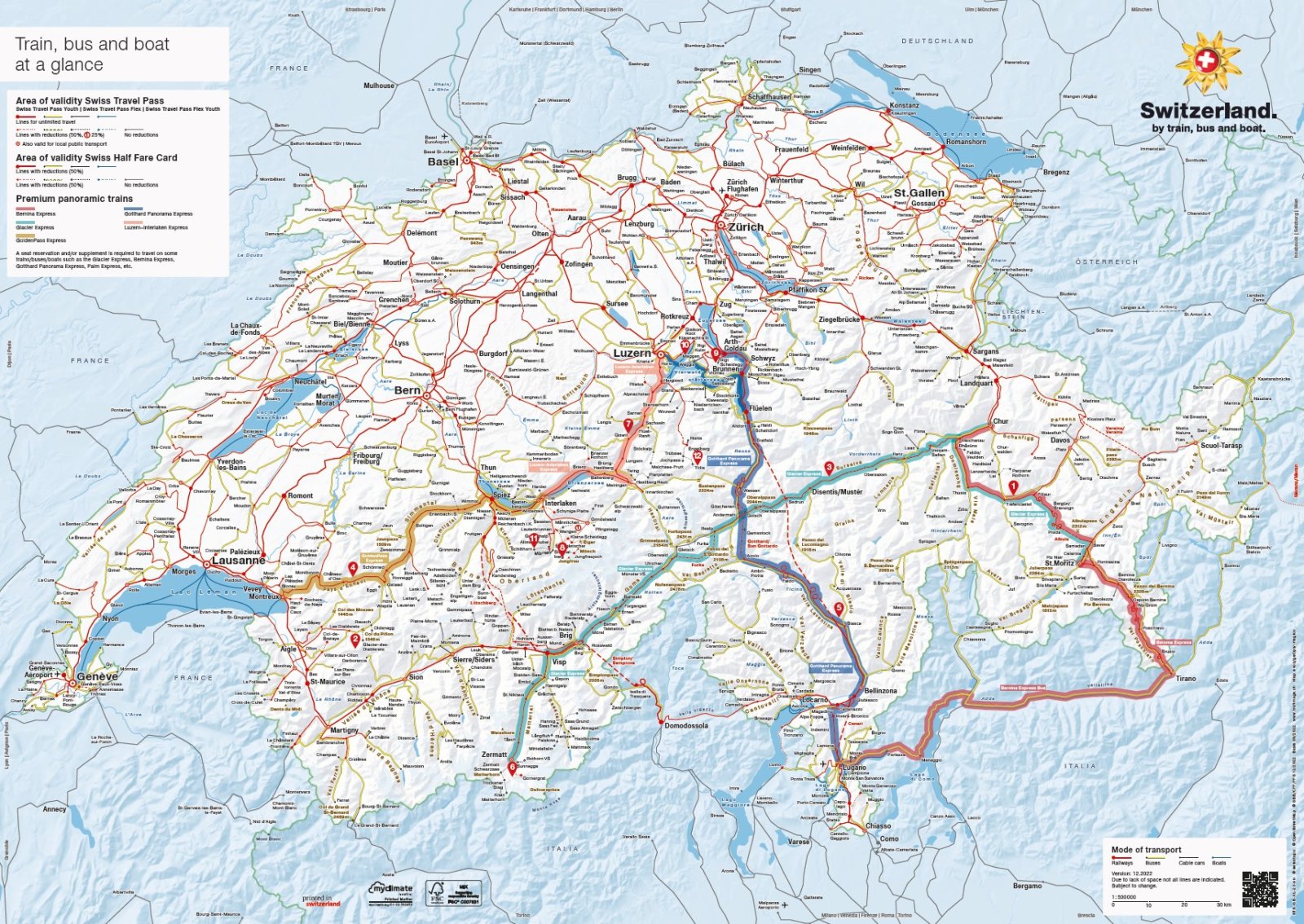
Train Companies in Switzerland
Their trains and coaches can be recognized by the abbreviation “SBB CFF FFS.” These abbreviations cover three of the four languages of Switzerland, but they all stand for Swiss Federal Railways:
- SBB: Schweizerische Bundesbahnen
- CFF: Chemins de Fer Fédéraux Suisses
- FFS: Ferrovie Federali Svizzere
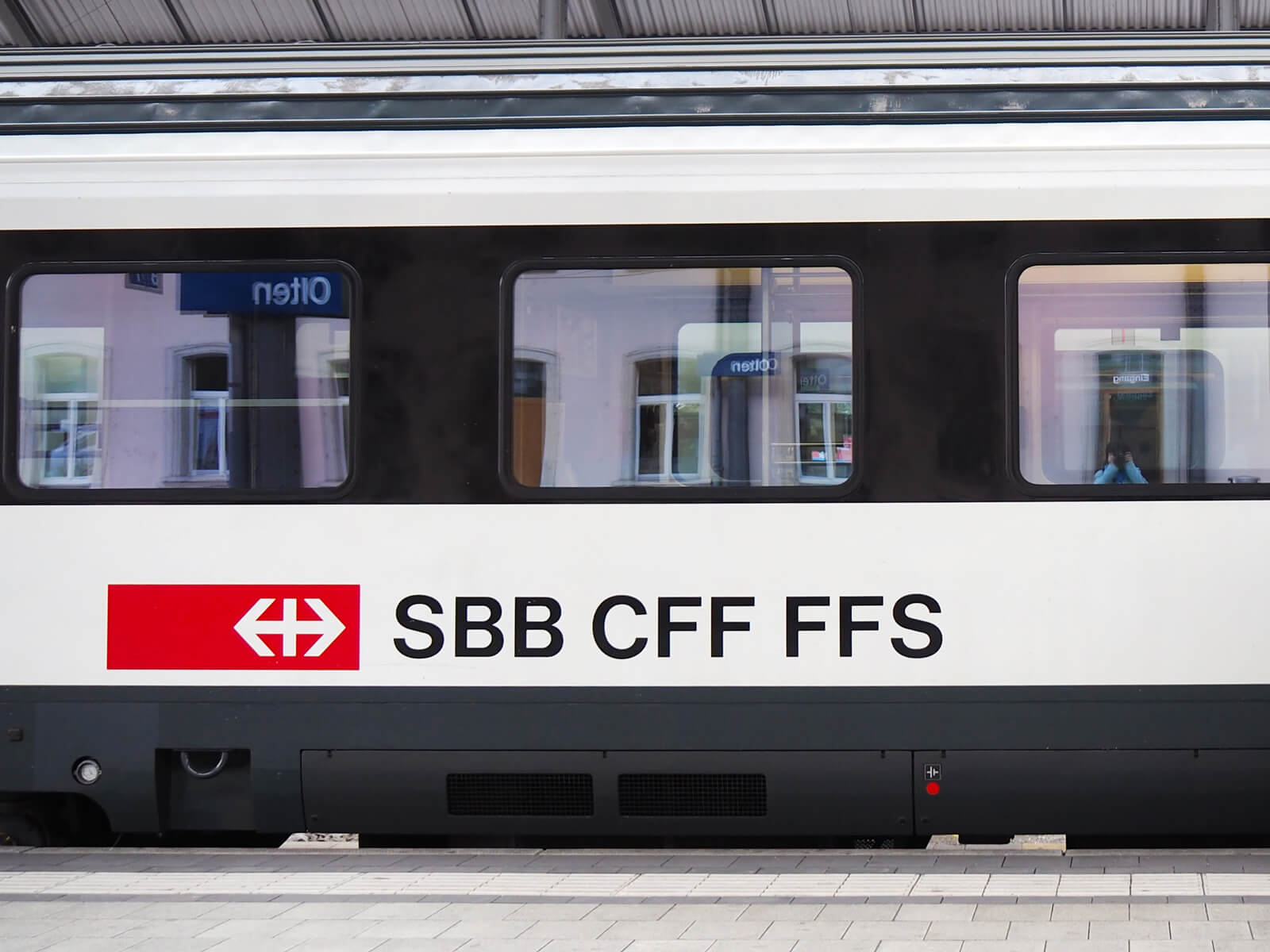
In addition, a few other companies cover large areas of Switzerland, such as BLS and SOB. Finally, several regional lines provide connections from hubs to smaller train stations.
Notable train companies in Switzerland:
- Appenzeller Bahnen
- Berner Oberland-Bahn
- Bern-Lötschberg-Simplon (BLS)
- Chemins de fer du Jura
- Montreux-Oberland-Bernois (MOB)
- Matterhorn Gotthard Bahn (MGB)
- Rhätische Bahn (RhB)
- Schweizerische Südostbahn (SOB)
- Zentralbahn
Travel Classes on Swiss Trains
Swiss trains offer two main travel classes: first class and second class. The primary distinction between the two classes is the level of comfort and available onboard amenities.
Second-class coaches are rather nice, with cushioned seating arranged in sets of four. Most seats do not have dividing armrests, which removes some privacy. Especially during peak travel times, such as during weekday commuting or on Fridays and Sundays, second-class coaches can get quite crowded. As a result, seats are not always available.
First-class coaches on Swiss trains offer more comfort and privacy. For one, they are roomier with fewer seats per carriage, but each seat features more space and ample legroom. Armrests between seats provide more privacy. Other amenities include power outlets for every seat and business sectors for working in a quiet environment.
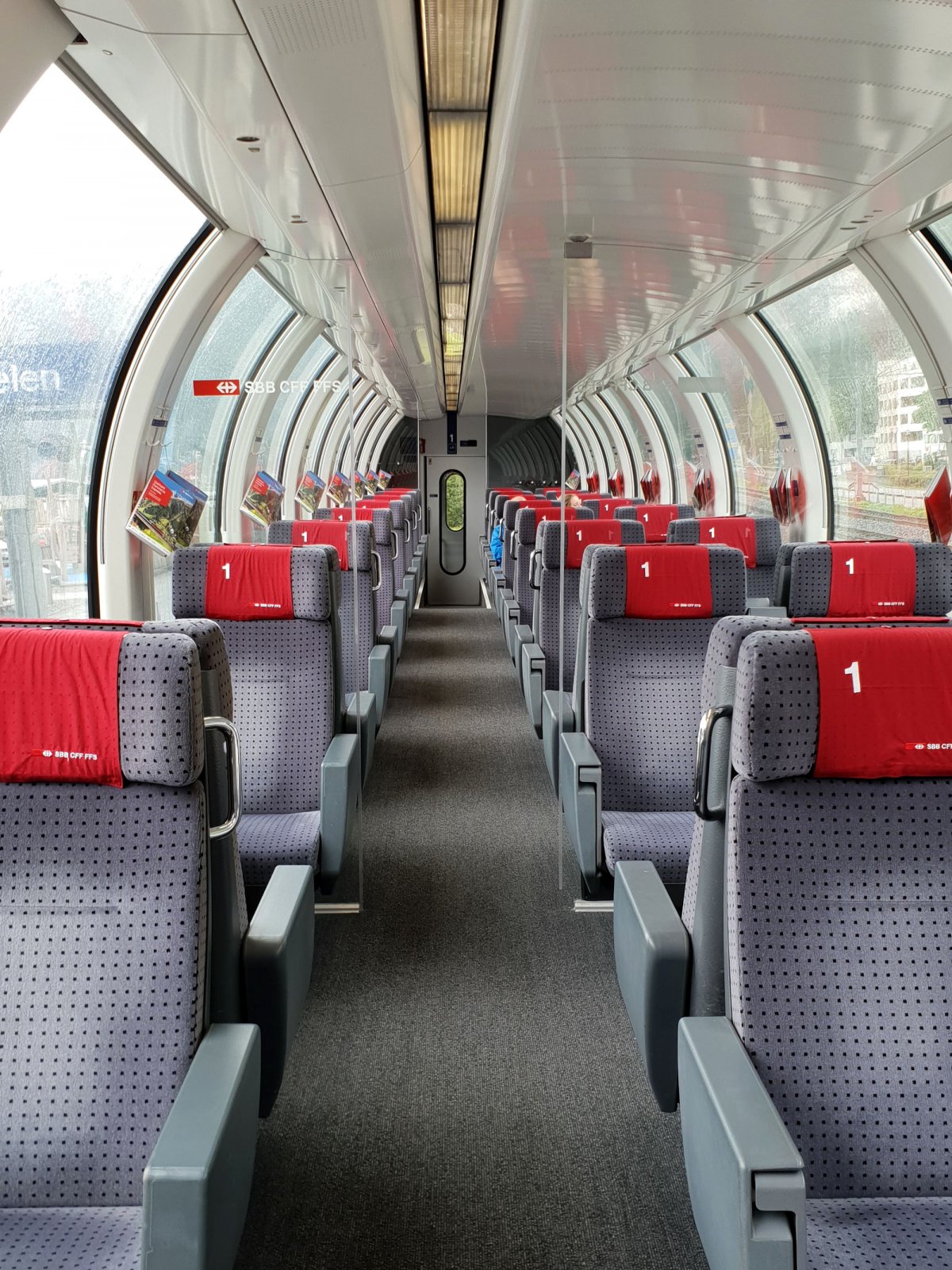
Information about the sectors where first and second-class coaches are located on a given train is shared on overhead boards or over the loudspeaker. First-class coaches might not be available on some private train lines, and amenities vary by type of train.
Tickets and Train Passes
There are a range of options for planning train travel logistics in Switzerland. Some visitors may prefer to look up all the destinations on a map and buy individual point-to-point tickets for each leg. Others prefer the blanket coverage of a travel pass. Here is an overview of Switzerland's various tickets and train passes.
Point-to-Point Tickets
Point-to-point tickets can be purchased at the train station ticket booths and vending machines, on the train company's website, or in the official SBB mobile app.
While this approach may be the ultimate money-saving option in Switzerland, it is unlikely to be the most efficient. It is also not the most flexible way because the regular point-to-point tickets require you to follow a schedule.
Regional Passes
Regional passes are an ideal alternative for those travelers who plan on spending most of their time in a particular region, such as Central Switzerland or the Bernese Alps.
Some regional passes offer free transportation coverage for the entire pass duration, while others restrict free travel days but offer discounts on the remaining days. They are available to both residents of Switzerland and visiting tourists.
Swiss Travel Pass
The Swiss Travel Pass presents the ultimate option. Unlike single tickets or regional passes, it provides unlimited blanket coverage for most Swiss public transportation for a pre-determined number of travel days. The “hop on/hop off” nature of the pass is perfect for those who want to stay flexible.
The Swiss Travel Pass includes most trains, buses, and boats in Switzerland. Five top-tier panoramic train lines and any trains operated by Switzerland’s major carriers are covered entirely.
Buy a Swiss Travel Pass at GetYourGuide
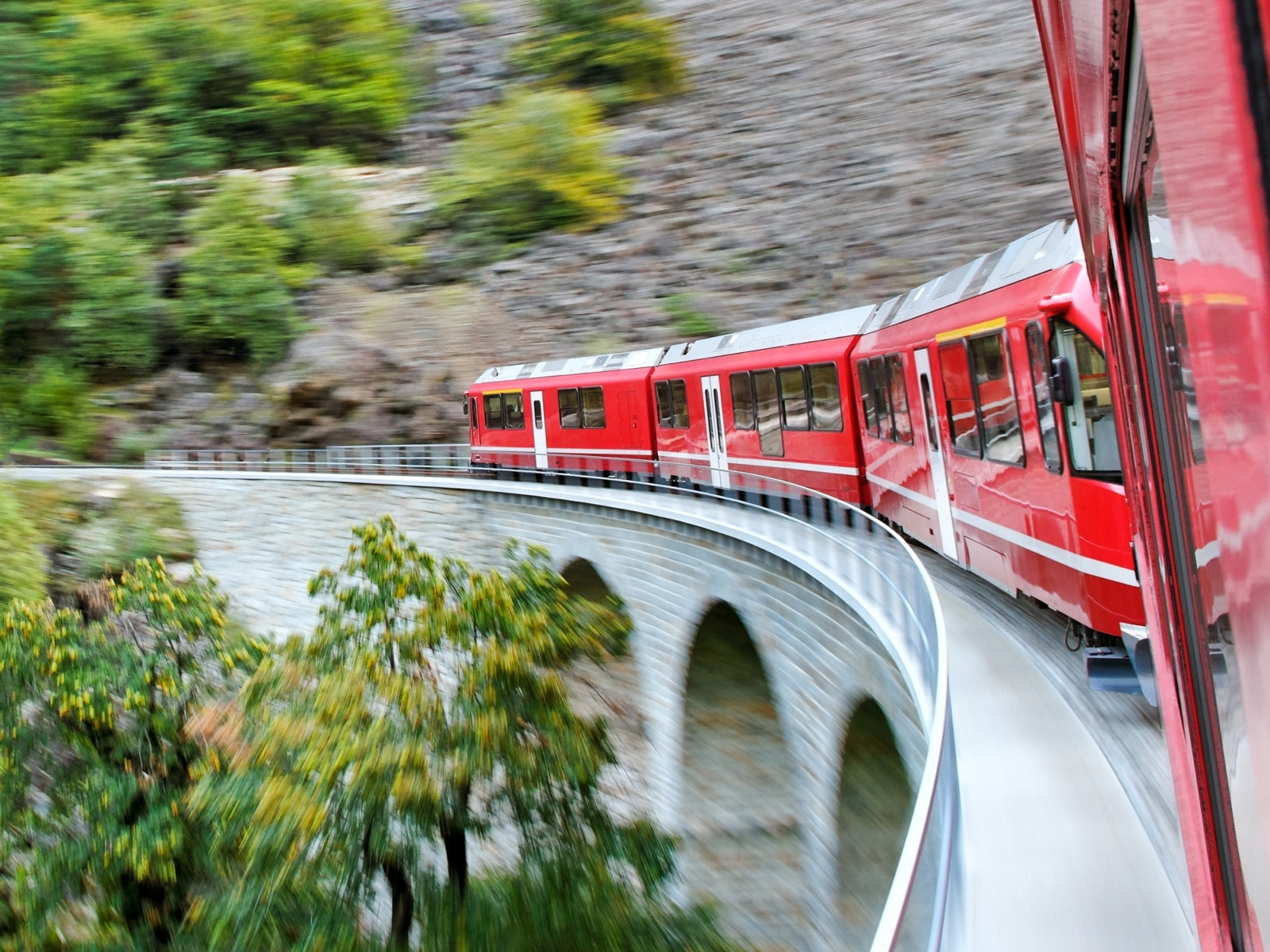
Benefits of the Swiss Travel Pass in 2024
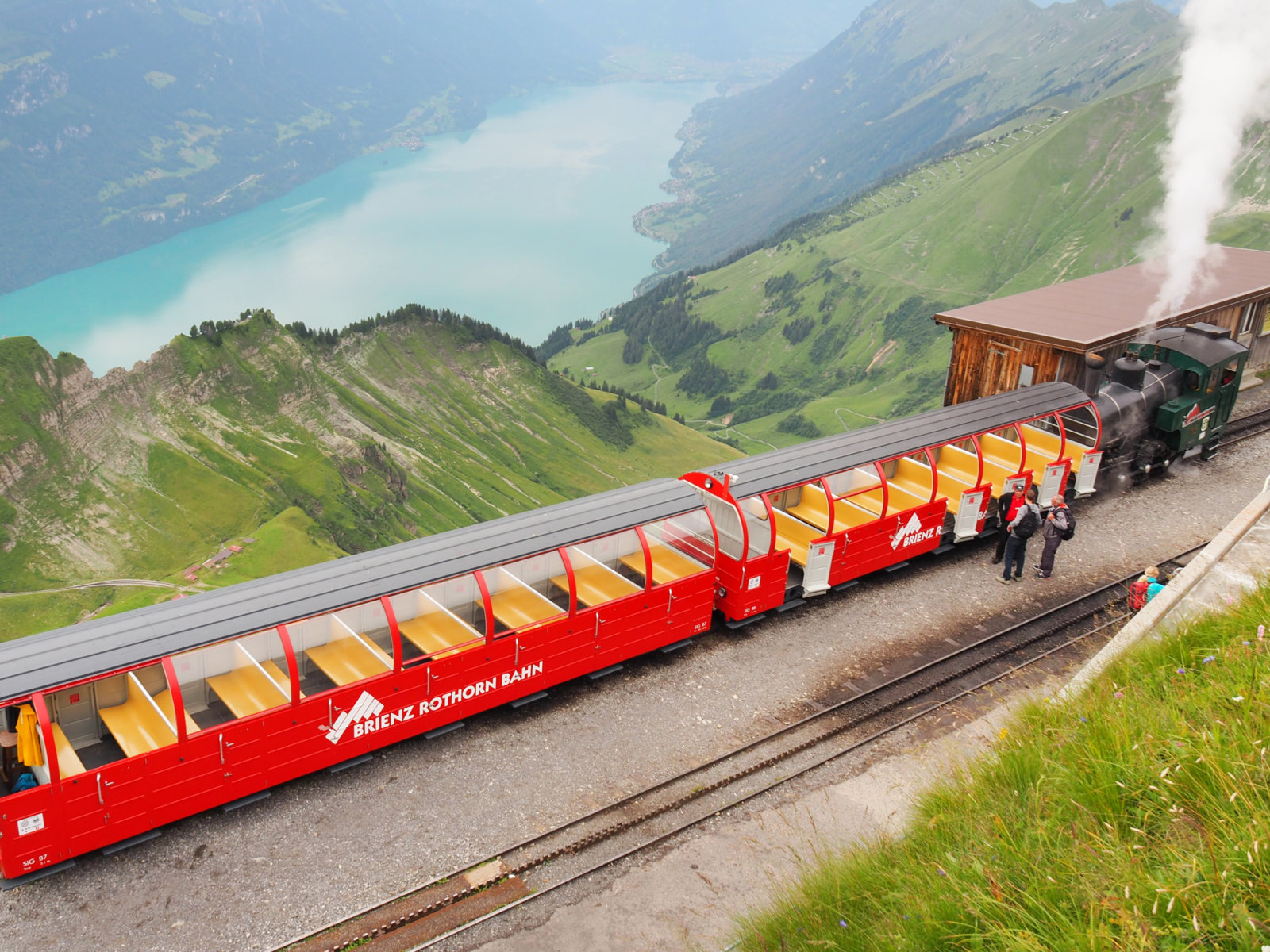
Swiss Travel Pass Overview and Insights for 2024
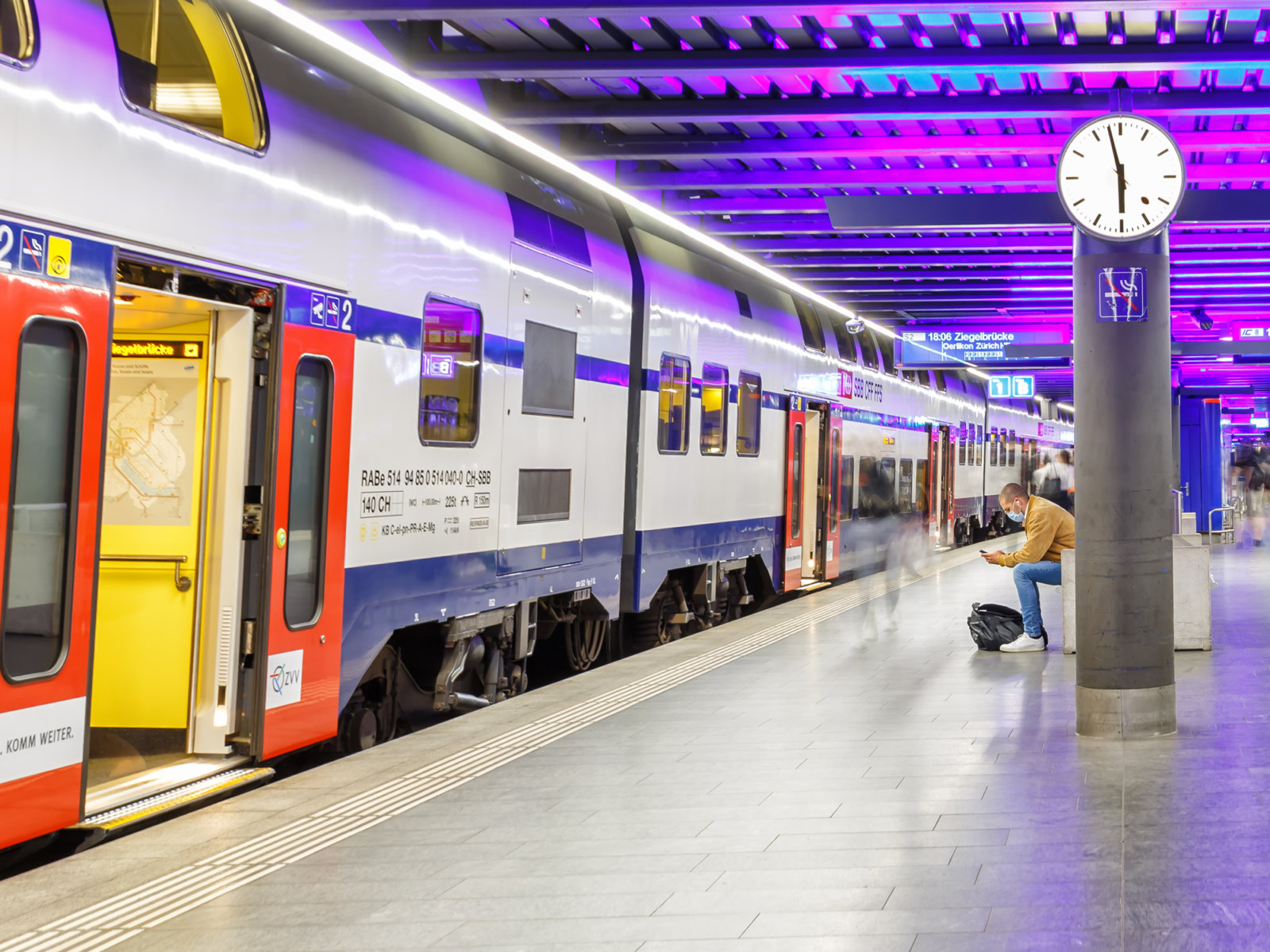
Swiss Travel Pass FAQs: Helpful Answers for 2024
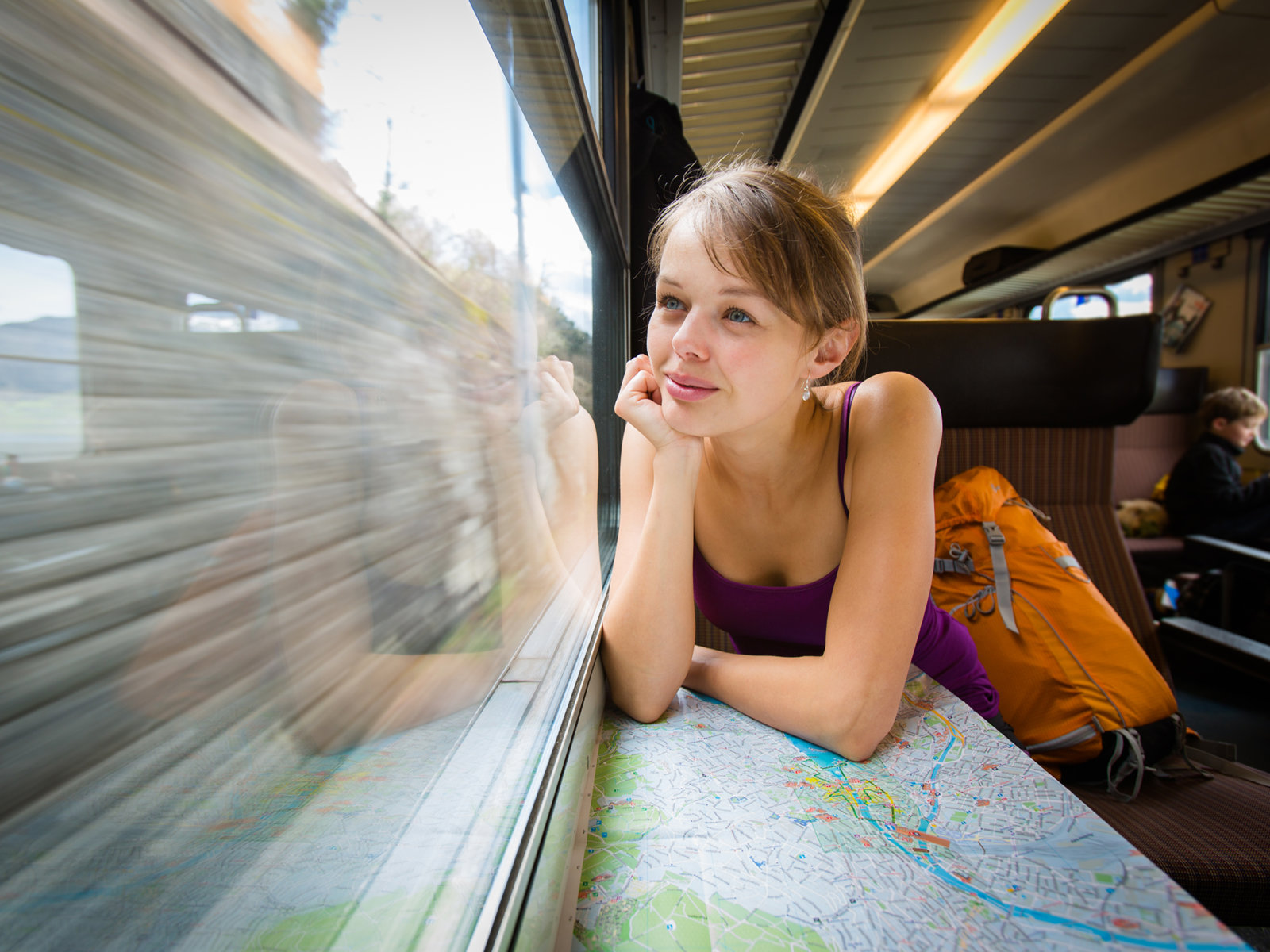
Is the Swiss Travel Pass worth it in 2024?
Get our ultimate free guide swiss travel pass: how to make it work in 2024.
The free guide includes a round-trip itinerary starting in Zurich for budget travelers. It “hacks” a three-day Swiss Travel Pass to make it last for a five-day stay…
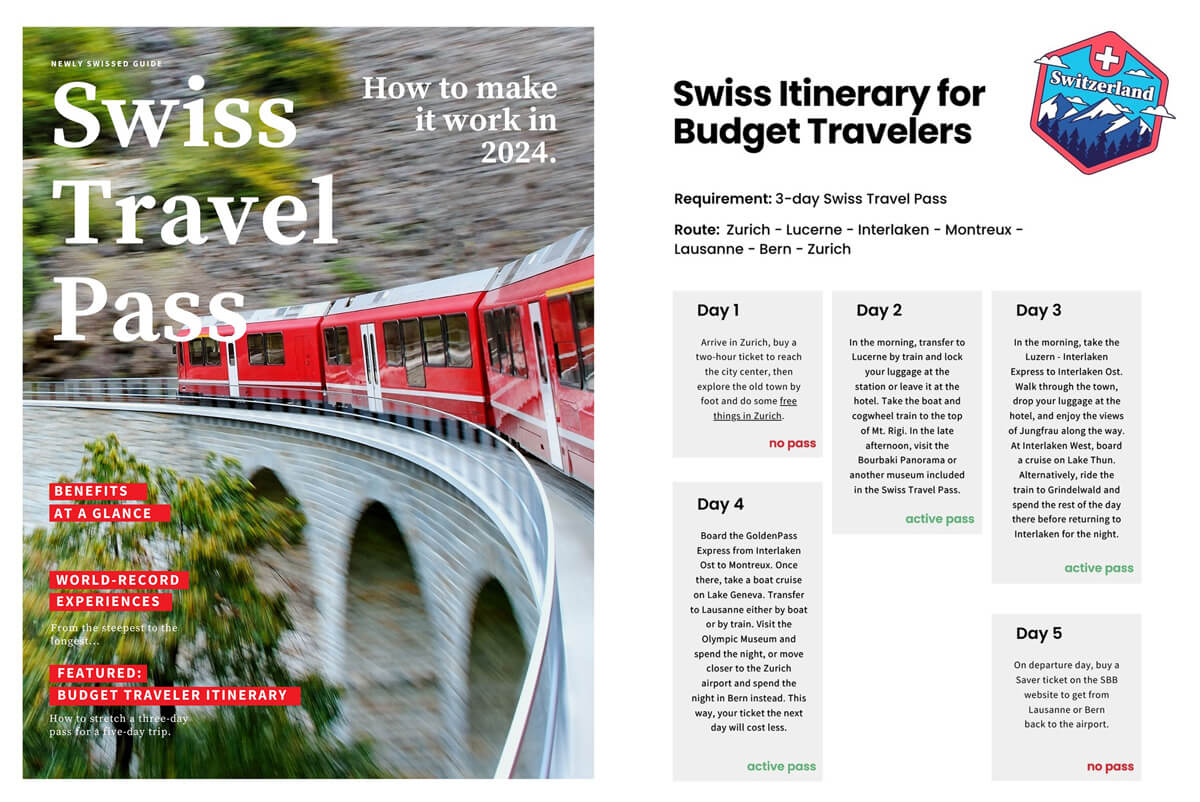
Digitally savvy and flexible travelers can uncover saver fares in the SBB Mobile app. These individual tickets are contingent on a particular date and train connection, but they offer the cheapest way to travel by train. Travelers who wish to remain flexible regarding train connections may prefer the Swiss Travel Pass. Using included mountain railways, boat cruises, and museums, they could maximize the upfront cost and come out cheaper than with individual tickets.
The cost of train tickets in Switzerland can vary depending on the type of train and the route. Regional trains tend to be the most affordable, while scenic trains like Glacier Express can be more expensive. Many Swiss subscribe to the Swiss Half Fare Card, which reduces the price of individual train tickets by 50 percent.
Yes, discounts are available for train travel in Switzerland. On the one hand, discounts may be available for children, students, and senior citizens. It is also possible to purchase a Swiss Half Fare Card, which allows for a 50% discount on most train tickets. And finally, the SBB Mobile app and website offer limited saver fares for particular connections - usually during midday.
Yes, train tickets can be purchased in advance in the SBB Mobile app, on the Swiss Federal Railways website, or through a travel agency. Advance purchases can often result in lower fares. Look out for discounted tickets labeled with a percentage sign on the SBB website; they can result in significant savings.
Seat reservations are not required for most intercity and regional trains in Switzerland. However, reservations are recommended for scenic trains such as the Bernina Express and are mandatory on the Glacier Express.
Yes, it is possible to travel by train with a bike. Bicycles can be taken on most trains by paying an extra fee . On some trains, it is mandatory to make a prior reservation for bicycles as space is limited during peak seasons.
Except on mountain railways, first-class seating is available on all trains in Switzerland. First-class compartments usually provide more comfortable seating and more space. Some trains, such as the GoldenPass Express , offer a VIP section with oversized panoramic windows and private-jet quality seating.
Switzerland is considered safe for rail travel, but CCTV cameras are generally on most trains. In the case of an emergency, the onboard emergency button will alert the train driver and the nearest police station. As anywhere in the world, savvy travelers will always watch their luggage. Here are additional precautions and resources for safe traveling in Switzerland .
Purchase the Swiss Travel Pass online at the most reputable vendor starting at CHF 244. You will receive an immediate email confirmation with a PDF ticket.
PLEASE Pin OUR EXPERT GUIDE!
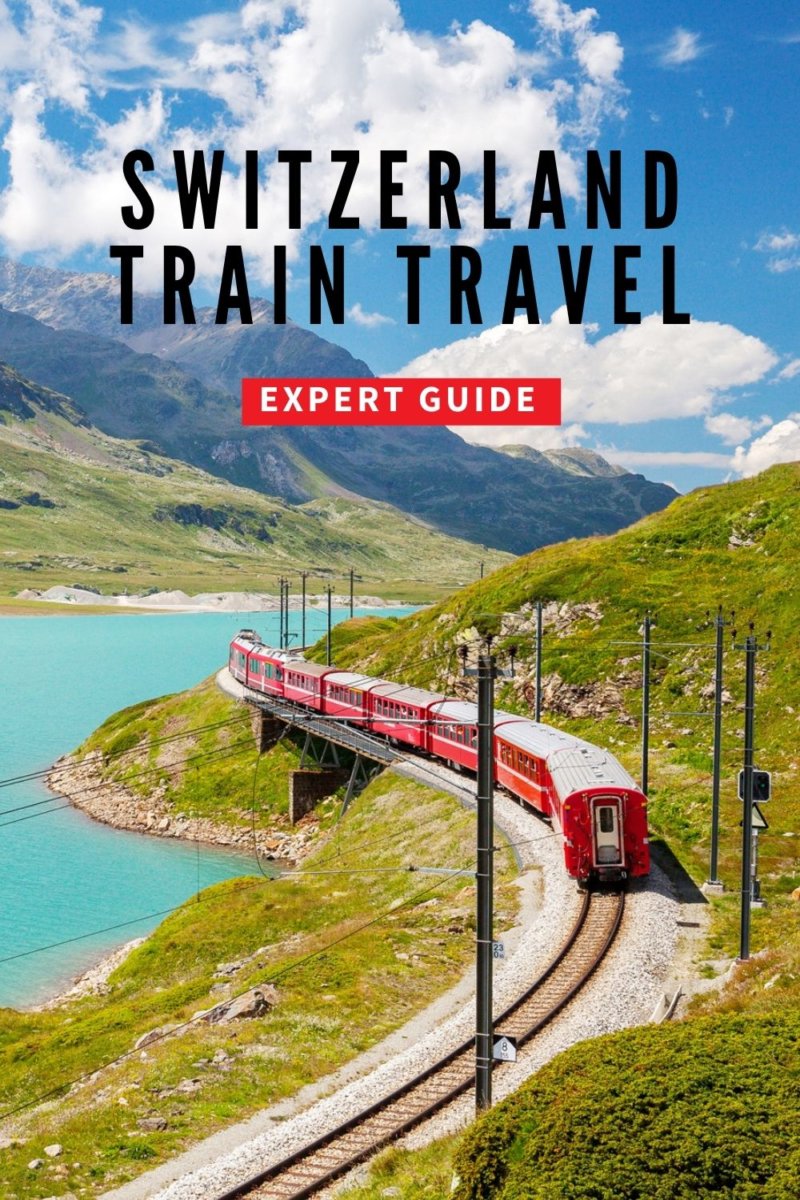
Newly Swissed GmbH Langrütistrasse 1A, 8635 Dürnten Switzerland +41 78 949 03 53
Copyright © 2024 - Newly Swissed GmbH. All rights reserved.
- Everyday Life
- Food & Wine
- Travel & Tourism
- Book Reading
- Concert/Dance/Musical
- Food/Gourmet
- Stand-up/Theater/Movies
- Workshop/Seminar/Tour
- Add an Event
- What We Like
- Meet the Team
- Press Coverage
- Advertising
- Contact us or book us
Download our e-book: 77 Facts about Switzerland

The Man in Seat 61
A beginner's guide to
Train travel in switzerland.
- Buy train tickets
- Buy ferry tickets
- Book a hotel
- Privacy & cookies
- Home
Train travel UK & Ireland...
Train travel in europe..., train travel in asia..., train travel in africa..., train travel in america..., train travel in australasia, swiss tickets & passes explained.
Swiss trains run like clockwork, so they say. And they pretty much do. The whole of Switzerland is covered by a frequent, punctual and efficient integrated train network that's really easy to use. In most cases you can just turn up, buy a ticket and hop on. Swiss Federal Railways (= SBB in German, CFF in French or FFS in Italian) runs most mainline trains, but there are many smaller private operators running local & regional routes.
Train travel within Switzerland
Swiss scenic trains
International trains to/from switzerland, station guides, other train travel information, useful country information, how to check times & buy tickets, do you need to book in advance, which website to use.
The following websites all link to the Swiss Federal Railways (SBB) ticketing system and can all sell regular tickets , Saver Day Passes & advance-purchase Supersaver fares . The price is the same whichever website you use.
Booking opens 6 months in advance. You print your ticket or can show it on your phone.
Option 1, Swiss Federal Railways, www.sbb.ch
You can check train times & fares and buy tickets for any journey in Switzerland at the Swiss Federal Railways (SBB) website www.sbb.ch .
Prices are in CHF. Be warned, the first price that www.sbb.ch shows you is usually only half the true price, because Sbb.ch assumes you have a Swiss Half Fare card as the majority of Swiss citizens do. When you change Select discount to No discount the price doubles, so be aware of this when costing your journeys. There's no booking fee.
Option 2 , Thetrainline.com
You may find it easier to check times & buy tickets at www.thetrainline.com , in CHF, €, £ or $. It too can sell all tickets types, regular tickets , Saver Day Passes and advance-purchase Supersaver fares . There's a small booking fee. Who are Thetrainline.com?
Option 3 , Omio.com
Omio.com is also really easy to use, in CHF, €, £ or $. There's a small booking fee.
The SBB system not only covers SBB's own trains, it covers all Swiss public transport including private train operators and connecting ferries, buses and funicular railways. Trains run every hour or every 30 minutes, even more frequently on core routes. Trains, buses & ferries connect efficiently, and connections of even just a few minutes are reliable and easy to make.
Standard fares
There is one regular flexible fare between any two Swiss stations via a given route, good for any departure that day. The price is fixed and availability is unlimited, you can buy at this price at the station on the day if you like. You sit anywhere you like.
If you buy one of these full-price full-flex tickets at www.sbb.ch , www.thetrainline.com or www.omio.com , it is valid on any train between those stations by the route stated on the date you bought it for, even if you selected a specific train.
A round trip ticket costs the same as two one-ways. The return journey must be made the same day if the journey is less than 116 km. If the journey is more than 116 km the return journey may be made any day up to 10 days after the outward leg. But you may as well stay flexible and just buy two one-ways.
With a regular Swiss ticket, you can break your journey (in other words, stop off) on the way as long as you complete the whole journey that same day.
Supersaver fares
For longer-distance journeys you may be offered a Supersaver advance-purchase ticket.
Supersaver fares are up to 70% cheaper than the regular flexible price. You can buy Supersavers a minimum of 1 day in advance. There is limited availability at each price point, the further ahead you book and the less popular the train you choose, the cheaper it's likely to be.
Supersaver fares are only good for the specific train you book, no refunds, no changes to travel plans.
However, if you miss your train, the Swiss Railways let you use the ticket as credit towards a full-fare ticket for a later train - just go to the ticket office and pay the difference between the Supersaver price and the regular full-price fare.
Obviously, be careful when using a train-specific Supersaver fare for an onward journey in connection with a train arriving from Paris or Milan or when arriving on a flight, unless you leave a long time buffer to absorb delay.
Using www.thetrainline.com or www.o mio.com , Supersaver or Saver Day Passes will appear in the search results if they're available. Using www.sbb.ch , a black triangle with a % symbol will appear to the left of any departures in the search results which have a Supersaver fare available. Select that departure and the Supersaver price will appear during the buying process when you click Options for the outward journey . Supersaver fares can only be bought online, and only at www.sbb.ch , www.thetrainline.com or www.omio.com . They will not appear if you look further ahead than 60 days.
Saver Day Pass
For longer-distance journeys you might also be offered a Saver Day Pass if it's cheaper than a full-fare full-flex ticket.
A Saver Day Pass gives you a whole day of unlimited travel on the entire Swiss transport system, the rail equivalent of an 'all you can eat' buffet. It covers all SBB (Swiss Federal Railways) trains and most private railways, post-buses & ferries. Saver Day Passes come in 1st & 2nd class versions, with or without Half Fare Card discount. It covers the Bernina Express & Glacier Express routes, although you need a reservation for those trains.
The price of a Saver Day Pass varies, you'll see a different price on each date which increases like air fares as that date approaches.
A Saver Day Pass starts at CHF 52, cheaper than a full-price ticket from Zurich to Geneva (although a Supersaver fare might be cheaper still). If you wait until the day before travel, it could cost CHF 119.
You can buy a Saver Day pass by running an enquiry at www.thetrainline.com or www.omio.com for a random long-distance route (for example, Zurich to Tirano), then looking for Saver Day Pass as a fare option. You can also buy at www.sbb.ch or in person at Swiss stations.
Booking opens 6 months in advance. Saver Day Passes cannot be bought on the day. No refunds, no changes after buying it.
The routes covered by a Saver Day Pass are shown on the official Swiss train map as solid red, yellow or black lines.
Routes shown as dotted red, yellow or black lines are not covered, this includes a few smaller private railways and some well-known tourist mountain railways such as the Jungfrau Railway & Gornergrat Railway. Unlike the Swiss Travel Passes , the Saver Day Pass doesn't get you any reduction on these dotted-line routes, if you want to use them you pay full-price.
One thing confuses people about the map: Solid lines become dashed lines where the line is in a tunnel. Dashed isn't the same as dotted !
Another way to save...
Back to top
Swiss Passes & Half Fare Card
Switzerland is one of the few remaining European countries where expensive point-to-point fares and lack of compulsory reservations makes railpasses good value and convenient. You can buy passes online from the Switzerland Travel Centre , a Swiss Federal Railways subsidiary. But I'm often asked if a pass makes sense, or whether to go for a Half Fare card. Incidentally, the Swiss Transfer Ticket was discontinued in 2019.
A Saver Day Pass is a useful one-day all-Switzerland pass, easily bought online or at the station up to the day before see the section above .
Swiss Travel Pass
A Swiss Travel Pass gives unlimited travel across the Swiss travel system for a continuous period of 3 days, 4 days, 8 days or 15 days.
A Swiss Travel Pass Flex gives unlimited travel across the Swiss travel system for either 3, 4, 8 or 15 travel days with an overall period of a month. A Swiss Travel Pass Flex is more economical than a regular non-Flex Swiss Travel Pass if you plan to stay put between journeys. The overall one month starts on any date you like, then you can 'spend' each of your unlimited travel days on any dates you like within that period.
Check prices in CHF, USD, GBP or Euros at www.switzerlandtravelcentre.com , an international site run by a subsidiary of SBB (Swiss Railways).
Is a Swiss Travel Pass cheaper than point-to-point tickets?
Swiss rail fares are expensive, so a Swiss pass can save money, depending what you plan to do and whether you're adult or youth. First check the price of the pass that suits you, then divide the price by the number of days travelling you plan to do to get the pass cost per day. Are the journeys you plan to make each day cheaper than this? If so, don't buy a pass. Or do they cost more than this? Then buy a pass! You can check fares at www.sbb.ch . It's not rocket science!
What does the pass cover?
See this official map of the Swiss rail network . A Swiss Travel Pass (continuous or flex) gives you unlimited free travel on all the train, bus & ferry routes shown as solid red, yellow or black lines on the map. Swiss Travel Passes give you a 50% discount (not free travel) on the routes shown as dotted red, yellow or black lines.
One thing that confuses people: A solid line becomes a dashed line when it's in a tunnel, but it's not the same as a dotted line! Routes on which you only get a discount, not free travel, notably include the Jungfrau Railway & Gornergrat railway.
How to buy a pass
Buy at www.switzerlandtravelcentre.com . Anyone from any country can buy here, in CHF, £, $ or €. This is an official Swiss Railways shop, owned by SBB Swiss Railways.
Print your own pass or show it on your phone
You get an e-ticket/print-at-home option for Swiss Travel Passes and Swiss Travel Pass Flex, so you'll get your pass immediately with no delivery charges. You can print it out or show it on your phone via their pass activation page at www.activateyourpass.com .
Would an Interrail or Eurail pass be cheaper?
You should compare the cost of a Swiss Travel Pass with the cost of an Interrail One-Country Pass for Switzerland (if you're a European resident) or Eurail global pass (if you live outside Europe) as Interrail & Eurail passes can be significantly cheaper.
Like Swiss Travel Passes, Interrail & Eurail passes give unlimited travel on Swiss Federal Railways (SBB) and the major private train operators such as the Rhätische Bahn (RhB), Bern-Lötschberg-Simplon (BLS).
Before 2017 there were some significant private railway operators that a Swiss Pass covered but an Interrail or Eurail pass did not, but in 2017 Interrail/Eurail coverage was extended to include many more private operators, notably the Matterhorn Gotthard Bahn (MGB) which operates the line to Zermatt and half of the Glacier Express route. From 10 December 2023, the Berner Oberland Bahn joins the scheme, so Interlaken to Grindelwald, Lauterbrunnen, Wengen are now covered too.
That leaves only the post-buses, lake boats and a few minor private railways which the Swiss Travel Pass covers but an Interrail or Eurail pass doesn't. The line up the Jungfrau is not covered, but Interrail or Eurail passes give a 25% discount on normal fares.
Compare the lines covered by Interrail & Eurail on this map with the lines covered by a Swiss Travel Pass on this map . On both maps, solid lines mean covered, dotted lines mean not covered (although there may be a discount). Dashed lines simply means line in tunnel.
Swiss Half Fare card
Most Swiss residents have an annual half-fare card giving 50% off normal fares. Visitors can buy one lasting a month.
The discount applies to Standard fares , Supersaver fares and Saver Day Passes .
The 1 month Half Fare Card costs CHF 120, so (obviously) only pays for itself if you plan to clock up more than CHF 240-worth of train journeys. That's 3 full-price one-way trips between Lausanne and Zermatt, or 4 one-way trips between Basel and Interlaken, for example.
Again, it's not rocket science: Use www.sbb.ch , www.thetrainline.com or www.o mio.com to check fares the journeys you plan to make, and halve this cost. Does this exceed CHF 120? Then buy the Half Fare Card.
Children 6-15 travel free with a family Half Fare card if accompanied by a parent. This is a worthwhile benefit!
Buy online at www.switzerlandtravelcentre.com with prices in CHF, €, £ or $.
What are Swiss trains like ?
Classic intercity (ic) & interregional (ir) trains, double-deck intercity (ic) & interregional (ir) trains, icn tilting intercity (ic) trains.
These ICN Pendolino trains can tilt, enabling them to go round curves faster than normal trains. They have cut journey times on several curvaceous Swiss InterCity routes. Designed by Pininfarina, they feature a restaurant car and can reach 200km/h (125mph) although they don't often reach that speed in service. You'll find these trains operating IC trains on these routes Geneva-Basel, Geneva-Zurich, Lausanne-Basel, Lausanne-Zurich, Basel-Lucerne-Lugano-Chiasso and Zurich-Lugano-Chiasso. When using the journey planner at www.sbb.ch these trains are shown with a TT symbol in the facilities section, for Tilting Train.
Giruno Intercity (IC) & EuroCity (EC) trains
On the Basel/Zurich to Lugano route you'll find the latest Giruno trains, the international ones going through to Milan being classified EuroCity. Giruno trains have low-floor accessible entrance doors, hence the rather strange seating arrangement inside.
Swiss private operators
Swiss local trains are run by SBB or a plethora of local private operators. The trains come in all shapes & sizes, some old, some new. Below left, a local train run by Matterhorn-Gotthard Bahn (MGB) on the Brig-Zermatt line. Below right, a train from St Moritz to Chur run by the Rhätische Bahn (RhB).
Seat maps : Click here
Travel tips.
Maps of the European rail network: See the section on the Train travel in Europe page about rail maps .
Language problems
First-time visitors often think this will be a problem, but it hardly ever is. At stations, signs are usually in English as well as German, French & Italian, or they use easy-to-understand pictograms. On-train announcements on long-distance trains are often made in English.
First or second class?
Swiss fares are expensive, even in 2nd class. And a 1st class ticket costs 75% more than a 2nd class one. You don't get anything extra in 1st class on Swiss domestic trains - no free food or drink, no limo transfers, spa treatments or executive lounges. Just wider seats, plusher seats, more elbow room as seats are usually 2+1 across the car width instead of 2+2 as in 2nd class, fewer people per car, fewer families and loud kids, more business travellers - see the photos above . So unless it's a special occasion, or your company is paying, or you are rich, stick with 2nd class whilst within Switzerland as most travellers do.
Tip: A yellow stripe above the windows or door indicates a 1st class car on Swiss trains.
Luggage on trains
There are no baggage fees or weight limits, and you don't check your bags in, you simply take them with you onto the train, placing them on the racks at the end of each car, or above your head. More about luggage on European trains .
Left luggage at stations
Many larger Swiss stations have left-luggage lockers in various sizes, up to suitcase-sized. More information on left luggage lockers & prices .
Food & drink on Swiss trains
Many Swiss long-distance trains have a waiter-service restaurant car, not cheap but a real treat! A few regional trains now have vending machines selling hot drinks, cold drinks and snacks, operated with contactless bank cards.
Or feel free to bring your own food and drink (even a bottle of wine, if you like) onto the train, there's no rules against that on the rails!
First class lounges at stations
The lounges for first class passengers at Zurich & Geneva have been closed. More about station lounges .
You can take a bike in the luggage van on most Swiss trains if you buy a Swiss Bike Card , for more details, see the bicycles by train page .
Dogs & pets
In Switzerland, dogs of any size can travel for half the 2nd class fare - although for longer journeys there's a Dog Day card which can be cheaper. Small dogs up to 30cm high at the shoulder can travel free if they are in a carrier. You'll find information on the Swiss Railways website www.sbb.ch . You can easily buy Swiss tickets at the station when you get there.
For more about dogs & pets on trains in Europe, see the dogs & pets page .
Bernina Express: More information
Glacier express: more information, jungfrau bahn : more information, golden pass line : montreux - interlaken - lucerne.
This is a mainly narrow-gauge route from Montreux to Interlaken & Lucerne via the well-known ski resort of Gstaad. It's slower than using mainline trains, but very scenic and marketed to tourists as the Golden Pass route. Until December 2022 it involved 3 trains, but it can now be done with just two: Montreux to Interlaken and Interlaken to Lucerne. The first train is a new gauge-changing service, it runs from Montreux to Zweisimmen on the standard-gauge tracks of the Bern-Lötschberg-Simplon (BLS) Railway then from Interlaken to Lucerne on the metre-gauge Brunig Railway operated by the Zentralbahn. The new trains adjust their wheelsets at Zweisimmen. They have 1st & 2nd class panorama cars and a new luxurious Prestige class.
As with other tourist trains, reservation is necessary if you want to travel in the panoramic tourists cars, but regular trains run frequently over the same route and these need no prior reservation.
The website for the joint service is www.goldenpass.ch . But I find it easier to find Montreux-Lucerne Golden Pass times using the journey planner at www.sbb.ch - just make sure you put Zweisimmen in the via box, click advanced options and put Interlaken Ost in the second via box before running the enquiry. Then it will find journeys with 1 or 2 changes via this slower scenic Golden Pass route, rather than the faster mainline route.
Gornergrat, Matterhorn, Mt. Pilatus, Mt. Titlis, Schilthorn
If you live in the UK, you can buy excursion tickets up these mountains here: www.switzerlandtravelcentre.com
Invest in a good guidebook, even in the age of the internet. For the independent traveller, I think this means either the Lonely Planet or the Rough Guide. Both guidebooks provide the same excellent level of practical information and historical background. You won't regret buying one!
Click the images to buy at Amazon.co.uk
Or buy in the usa from amazon.com.
Alternatively, you can download just the chapters or areas you need in .PDF format from the Lonely Planet Website , from around £2.99 or US$4.95 a chapter.
Holidays, vacations & tours of Switzerland
Railbookers, railbookers.co.uk.
Railbookers are a train travel specialist who can put together a tour or short break for you as a package, including rail travel, hotels & transfers. On their website you'll find a range of suggested tours & holidays which can be varied or customised to your own requirements. And as you're booking a package, they'll take care of you if anything happens to one part of the itinerary such as a strike or delay. They have offices in the UK, USA & Australia.
Check out their 8-day Switzerland's Lakes & Mountains tour (link to their UK site) or Swiss Lakes & Mountains tour (link to their US & Canada site) which includes both the famously scenic Glacier Express and Bernina Express trains. Also see their 5-day Classic Bernina Express & Glacier Express tour (link to their UK site) or Classic Bernina Express & Glacier Express tour (link to their US & Canada site) which also combine these two classic Alpine routes.
Tailor Made Rail, tailormaderail.com
Tailor Made Rail can arrange tours of Switzerland by train including the Glacier and/or Bernina Expresses based on your own requirements, they welcome complex itineraries. As it's a package, they'll take care of you if anything happens on one part of the trip, for example, a national strike. They're TTA-protected - like ATOL, but not only for agencies that sell air travel.
Call their dedicated seat61 phone line 020 3778 1461 and quote seat 61 when booking. From outside the UK call +44 20 3778 1461 . Lines open 09:00-17:30 Monday-Friday. Their website is www.tailormaderail.com/destinations/switzerland .
Hotels & accommodation in Switzerland
Personal recommendations.
In Zurich , for something special, look no further than the superb Hotel Schweizerhof , located right next to Zurich station. One of my favourite hotels, they'll even send a uniformed commissionaire to meet you at the station and carry your bags across the road.
In the St Moritz-Pontresina area , the Romantik Hotel Muottas Muragl is an amazing place to stay perched on the top of a mountain, with clean simple and (for Switzerland) inexpensive rooms. It's reached via the Muottas Muragl funicular railway from Punt Muragl station, between Pontresina & St Moritz.
Backpacker hostels: www.hostelworld.com
www.hostelworld.com : If you're on a tight budget, don't forget about backpacker hostels. Hostelworld offers online booking of cheap private rooms or dorm beds in backpacker hostels in Paris and most other European cities at rock-bottom prices.
Travel insurance & other tips
Always take out travel insurance.
You should take out travel insurance with at least £1m or preferably £5m medical cover from a reliable insurer. It should cover trip cancellation and loss of cash & belongings up to a reasonable limit. These days, check you're covered for covid-19-related issues, and use an insurer whose cover isn't invalidated by well-meant but excessive Foreign Office travel advice against non-essential travel. An annual policy is usually cheapest even for just 2 or 3 trips a year, I have an annual policy with Staysure.co.uk myself. Don't expect travel insurance to bail you out of every missed connection, see the advice on missed connections here . Here are some suggested insurers, I get a little commission if you buy through these links, feedback always welcome.
Get an eSIM with mobile data package
Don't rely on WiFi, download an eSIM with a European mobile data package and stay connected. Most newer mobile phones can download a virtual SIM including iPhone 11 & later, see device compatibility list . There's no need to buy a physical SIM card! Maya.net is a reliable eSIM data retailer with a 4.5 out of 5 Trustpilot rating and a range of packages including unlimited data .
Get a Curve card for foreign travel
Most banks give you a poor exchange rate then add a foreign transaction fee on top. A Curve MasterCard means no foreign transaction fees and gives you the mid-market exchange rate, at least up to a certain limit, £500 per month as I write this. The money you spend on your Curve card goes straight onto one of your existing debit or credit cards. And you can get a Curve card for free.
How it works: 1. Download the Curve app for iPhone or Android . 2. Enter your details & they'll send you a Curve MasterCard - they send to the UK and most European addresses. 3. Link your existing credit & debit cards to the app, you can link up to two cards with the free version of Curve, I link my normal debit card and my normal credit card. 4. Now use the Curve MasterCard to buy things online or in person or take cash from ATMs, exactly like a normal MasterCard. Curve does the currency conversion and puts the balance in your own currency onto whichever debit or credit card is currently selected in the Curve app. You can even change your mind about which card it goes onto, within 14 days of the transaction.
I have a Curve Blue card myself, it means I can buy a coffee on a foreign station on a card without being stung by fees and lousy exchange rates, just by tapping the Curve card on their card reader. The money goes through Curve to my normal debit card and is taken directly from my account (in fact I have the Curve card set up as payment card on Apple Pay on my iPhone, so can double-click my phone, let it do Face ID then tap the reader with the phone - even easier than getting a card out). I get a little commission if you sign up to Curve, but I recommend it here because I think it's great. See details, download the app and get a Curve card , they'll give you £5 cashback through that link.
Get a VPN for safe browsing. Why you need a VPN
When travelling you may use free public WiFi which is often insecure. A VPN encrypts your connection so it's always secure, even on unsecured WiFi. It also means you can select the geographic location of the IP address you browse with, to get around geoblocking which a surprising number of websites apply. See VPNs & why you need one explained . ExpressVPN is a best buy with a 4.7 out of 5 Trustpilot ranking which I use myself - I've signed up as an ExpressVPN affiliate, and if you go with expressvpn.com using this link you should see a special deal, 3 months free with an annual subscription. I also get some commission to help support this site.
Carry an Anker powerbank
Tickets, reservations, hotel bookings and Interrail or Eurail passes are often now held on your mobile phone. You daren't let it run out of power, and you can't always rely on the phone's internal battery or on being near a power outlet. I always carry an Anker powerbank which can recharge my phone several times over. Buy from Amazon.co.uk or Buy from Amazon.com .
Touring cities? Use hill walking shoes!
One of the best things I've done is swap my normal shoes for hill-walking shoes, in my case from Scarpa. They're intended for hiking across the Pennines not wandering around Florence, but the support and cushioning for hiking works equally well when you're on your feet all day exploring foreign cities. My feet used to give out first and limit my day, now the rest of me gives up before they do!
Back to home page

Everything To Know About Train Travel in Switzerland
By: Author Charles
Posted on July 26, 2023
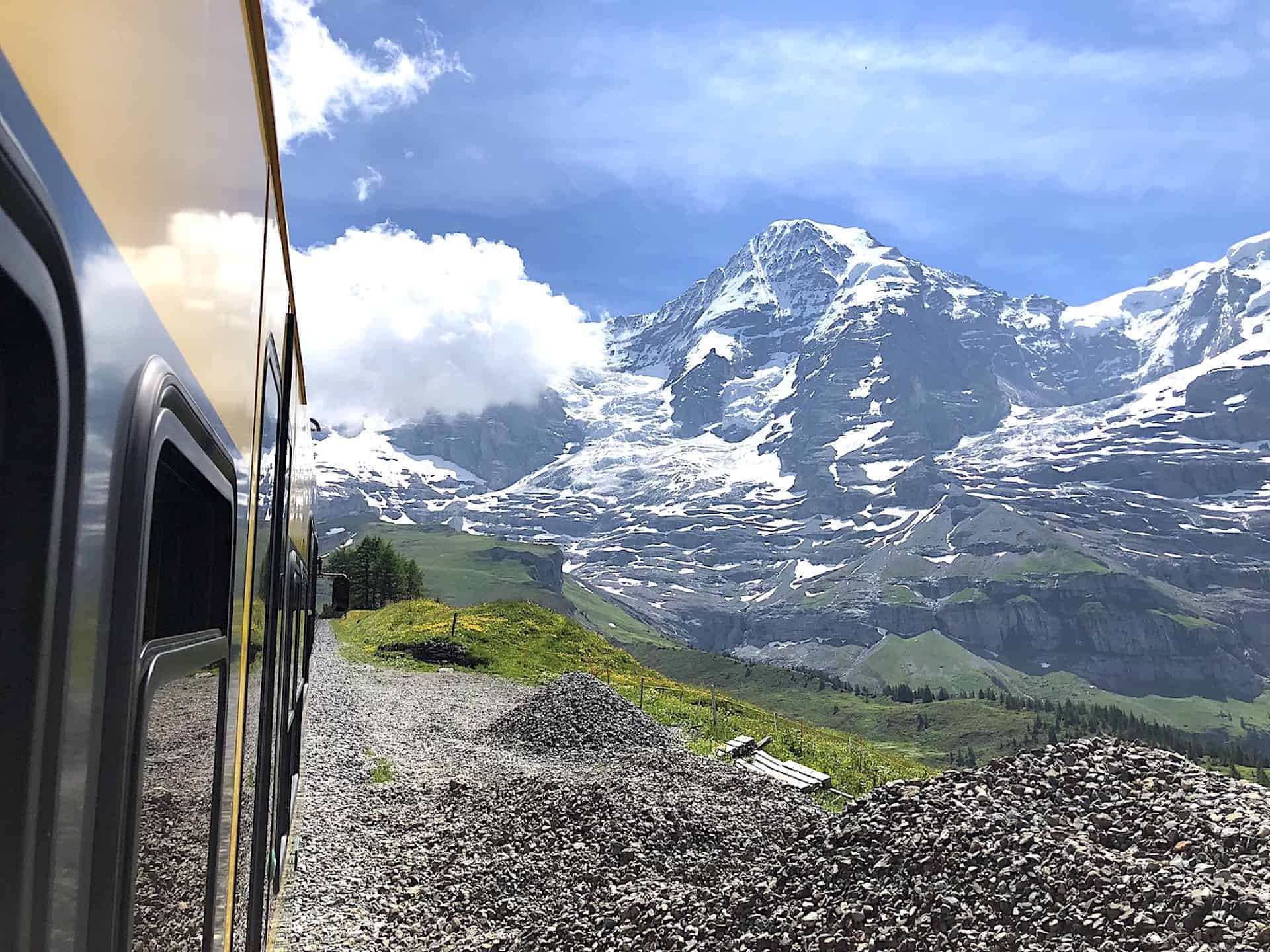
When it comes to transport around Switzerland, it does not get much better than the country’s train network. The Swiss trains are known to be some of the most convenient and dependable trains in the world. During a trip to the country, you will get to experience exactly that for yourself.
There are many important things to understand about the Swiss trains to better prepare yourself for your time there. From travel passes and discounts, to scenic trains and mountain railways, the Switzerland train network has a lot to take into consideration.
Read on to learn everything there is to know about train travel in Switzerland for your trip to this beautiful country.
* Affiliate Disclosure : This post may contain affiliate links, which means I may receive a commission if you make a purchase through the links provided, at no additional cost to you. Thanks for supporting the work I put into TripTins!
1) Introduction to Train Travel in Switzerland
Without a doubt the most convenient, cost effective and easy way to travel around Switzerland is by train. From east to west and north to south, trains run anywhere and everywhere.
Not only are trains prevalent throughout the country, they are also extremely timely and rarely run off schedule. Switzerland has logistics figured out to a tee, so even if there are only a few minutes between train connections, no worries at all.
Now while trains are the main way to get from one city to the next in Switzerland, they are intertwined with other modes of transportation within cities.
Busses, trams, mountain rails, boats and cable cars, among others are also vastly used. All these examples are just as efficient as the train system and are an integral part of getting around a certain city or mountain range.
As a tourist visiting Switzerland, odds are you will be utilizing the transportation system quite often. Instead of paying for full priced tickets for each and every route, Switzerland has different train passes to offer its visitors. I will go over the options in the next section of the guide to explain the pros and cons of each offering.
On top of train passes, the guide will cover many more topics regarding train travel such as understanding different train classes, buying individual tickets, learning more about the Swiss train app, among plenty other topics. So, read on for everything you need to know about train travel in Switzerland!
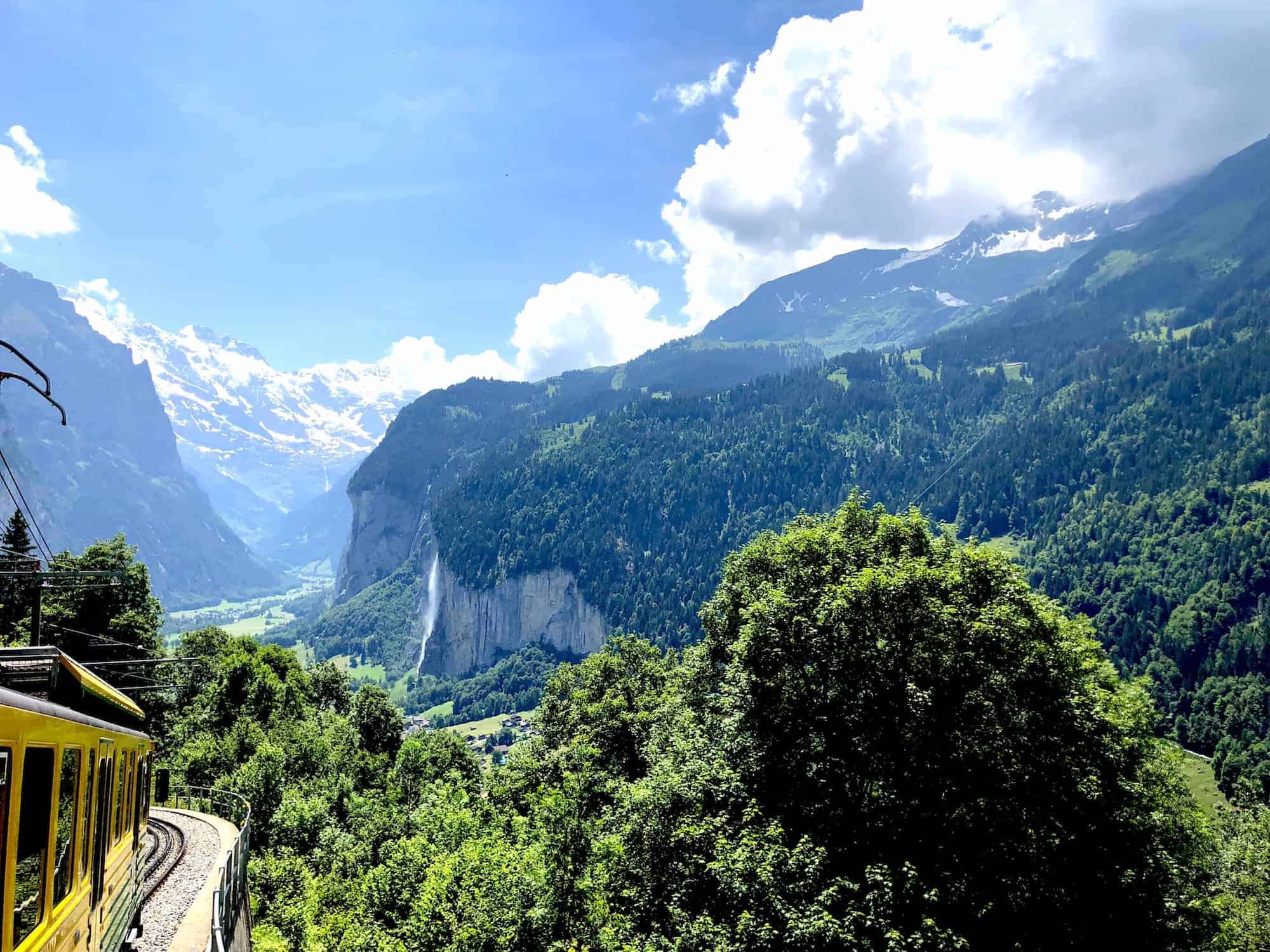
2) Switzerland Travel Pass Options
Probably the most talked about topic regarding Switzerland trains is travel passes. There are a few different options to go over to figure out which one will be best for your trip.
Now, if you only plan on taking a train or two during your stay, then travel passes will most likely not be for you.
However, if you plan on hitting numerous cities and traveling frequently within cities, then travel passes are sure to save you some cash. The following are the main options to choose from:
A) Swiss Travel Pass
The Swiss Travel Pass will get you unlimited travel on nearly every form of transportation throughout the country for one flat rate. You can choose from a 3, 4, 6, 8, or 15 day pass.
The great thing about the Travel Pass is that besides for some mountain transport (25% – 50% off), you will not have to pre-purchase tickets from the ticket machines, rather you will just be able to walk onto a train or bus and show your travel pass when asked by the conductor.
Another positive is that the Travel Pass includes some free/discounted excursions such as the cable cars up to the Schilthorn from Murren (50% off), the route up to Jungfraujoch (25% off) and the Mount Rigi excursion outside of Lucerne (100% off), among many others.
You will also be able to get into hundreds of museums for free. Below is a price table of how much it costs for the two different classes.
A few notes about the prices in general:
- Adults between the ages of 16-25 get a 30% discount on the below prices
- Children between the ages of 6-16 travel free if accompanied by a parent (with a Swiss Family Card – more on that soon)
- Children under 6 are always free
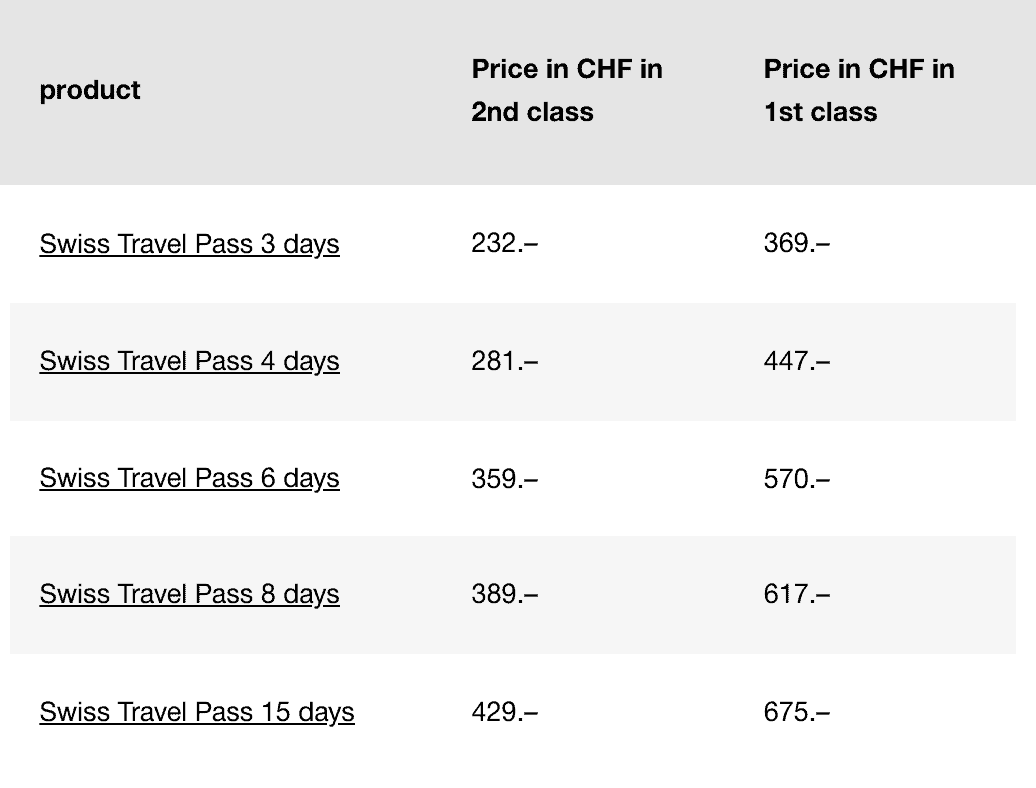
So to quickly recap, the Swiss Travel Pass offers:
- One flat all included price for all transportation (extra cost for some mountain railways and Panorama train reservations)
- Certain excursions 100% included (i.e. Mount Rigi, Lake Boat Tours), while others discounted (i.e. Jungfraujoch 25% off, Pilatus & Schilthorn 50% off)
- No need to buy separate tickets each time (besides some mountain transport) – just get right onto the train and show the conductor your pass
- Hundreds of museums throughout the country included in the pass
B) Swiss Travel Pass Flex
Very similar to the prior mentioned Travel Pass, the Swiss Travel Pass Flex offers the same type of benefits, however instead of it being active for 3, 4, 6, 8, or 15 days in a row, it can be used on non consecutive days and is valid for a month .
So, if you will be in Switzerland for 8 days but will only be using public transportation on days 1, 5 and 7, you can purchase the 3 day Travel Pass Flex instead of a 8 day Travel Pass as an example.
The downside though, compared to the regular Travel Pass it will cost more due to the flexibility aspect of it. All other benefits from the Swiss Travel Pass apply (including the age discounts).
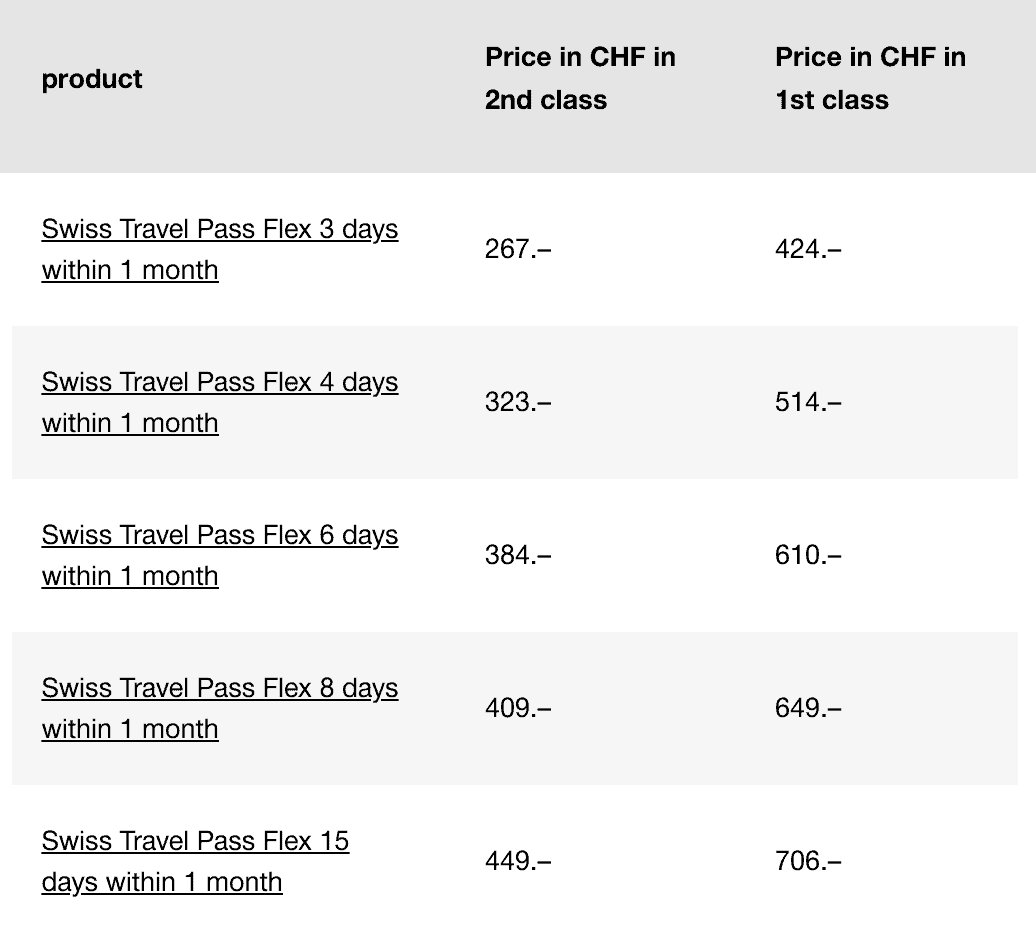
C) Swiss Half Fare Card
The Half Fare Card is also a very popular choice for train travel in Switzerland. There are some important things to note regarding the Half Fare Card. For one it is a flat rate at 120 CHF and lasts 30 days.
So more likely than not, the card will last you your full trip rather than worrying about when to start/end your full travel pass.
As you might imagine by purchasing the Half Fare Card, everything you purchase will be half off – trains, busses, boats, & mountain transport – all 50% off (with some mountain transport at 25% off).
With the Half Fare Card you are also required to actually purchase tickets before you get onto the train (be sure to select half fare when making the purchase). When the conductor comes by you will have to show both your ticket and the card.
» Check out this map of the Switzerland rail network that goes into detail on what is included with the three passes mentioned above.
D) Saver Day Pass & 1 Day Travelpass
There are two options for those that are looking for unlimited one day travel in Switzerland – the Saver Day Pass and 1 Day Travelpass.
The Saver Day Pass gives you free unlimited travel on trains and busses but just for one single day. However, there is no discount on mountain transport or free museums like the Swiss Travel Pass would give you (beyond a few exceptions).
Similarly, the 1 Day Travelpass can be purchased but only if you already have a Swiss Half Fare Card.
The thought here is if you have one big day of travel with some expensive routes, purchasing one of these passes will end up being more economical for you if you have a Half Fare Card or no type of travel pass at all.
E) Swiss Family Pass
One of the great things about train travel in Switzerland is that the prices for children are much more reasonable and, in some cases, even free!
If a parent has any of the aforementioned Swiss passes (Swiss Travel Pass, Swiss Travel Pass Flex, Swiss Half Fare Card, etc) then any child under the age of 16 can travel for free.
The Family Pass is completely free of charge as along as the children are traveling with someone who has one of the passes.
You can add the Family Pass as part of your purchase if buying beforehand or just pick one up at a station ticket counter.
Purchasing Travel Passes
If you would like to have everything set prior to your trip (which I would recommend), you can purchase your Swiss Travel Pass or Swiss Travel Pass Flex online ahead of time.
- Swiss Travel Pass -> buy online
- Swiss Travel Pass Flex -> buy online
You will have the option of choosing 3, 4, 6, 8, & 15 day options in either Second Class or First Class.
Alternatively, you can check out the SBB website for the other options. Click the link, scroll down to “Guests from abroad”, and choose the travel pass that is right for you. You can also buy these tickets at train station ticket offices throughout Switzerland (besides for the Saver Day Pass which must be purchased online beforehand).
Learn More: Are you deciding which travel pass is best for you? Be sure to read through this overview that dives deeper into the differences of the Swiss Travel Pass and the Half Fare Card .
3) Tickets Without A Travel Pass
I am sure there are also travelers who are only taking a couple quick train rides within the country and therefore will have no need for a travel pass. In this case you will have to buy individual full fare tickets.
On the SBB website you can take a look at different at different routes. After inputting your route and date, you can then click on a certain route time and you will then see the price come up.
Here is the important part to note – the price shown will reflect half of the actual cost of the train!
Since many Swiss citizens have passes that give them half off transportation, the default setting on the website will show the half fare.
This is a very important detail to note as you do not want to arrive in Switzerland and expect one price when purchasing tickets and then a price double what you thought pops up.
So if buying individual tickets and want to know how much tickets will cost always take a look if the half fare price is showing.
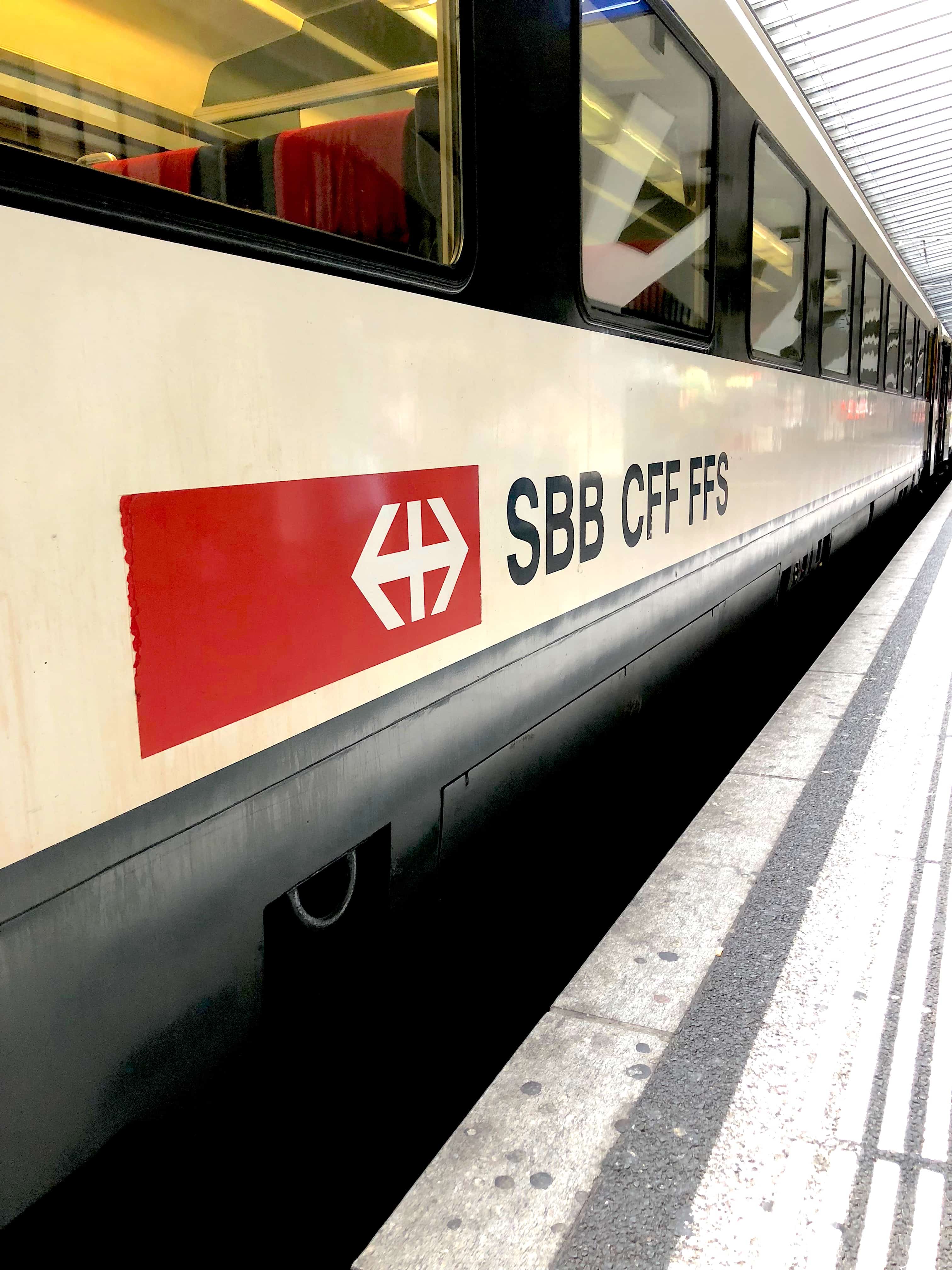
A second thing to note here is that some prices you see online may have a small “%” symbol.
This means that particular train has a discounted price and you can go ahead and purchase cheaper tickets than regular fare if you know you want to travel that exact route/time.

You may now ask, how am I supposed to understand the logistics between all of these different modes of transportation.
Well for that, Switzerland offers what is one of the most convenient phone apps there is – SBB Mobile .
SBB or Swiss Federal Railways is the national railway of Switzerland. You will see on many of the trains the letters “SBB CFF FFS” (Schweizerische Bundesbahnen – Chemins de fer Federaux Suisses – Ferrovie Federali Svizzere) – German – French – Italian – the three main languages that can be found throughout Switzerland.
Similar to the website, on the app, you can either select your destination and where you will be coming from, as well as the time and date, and you will be able to see a complete logistical schedule of how to get from point A to point B.
It will list out different options, length of travel, platform numbers and show exactly what types of transportation you will have to take along your journey. Here are a few screenshot from the app to get from Zurich to Geneva .
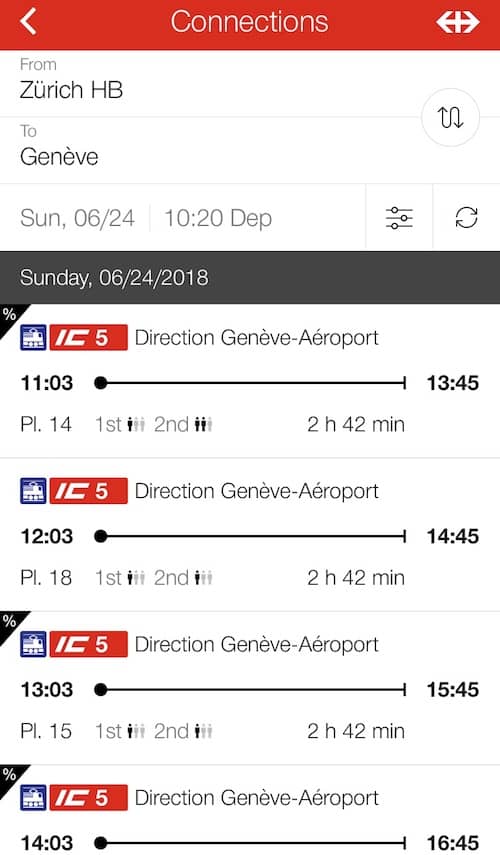
5) Buying tickets
If you do not purchase a Swiss Travel Pass (or flex), then you will have to go to the ticket machines or counter prior to each train ride and buy a ticket for that particular ride.
Below are a set of screenshots that walk you through the process of buying a ticket from these machines (note: I did not include every single step but for the most part it is pretty simple to operate).
Also, if you are a holder of the Half Fare Card make sure you purchase a half fare ticket!
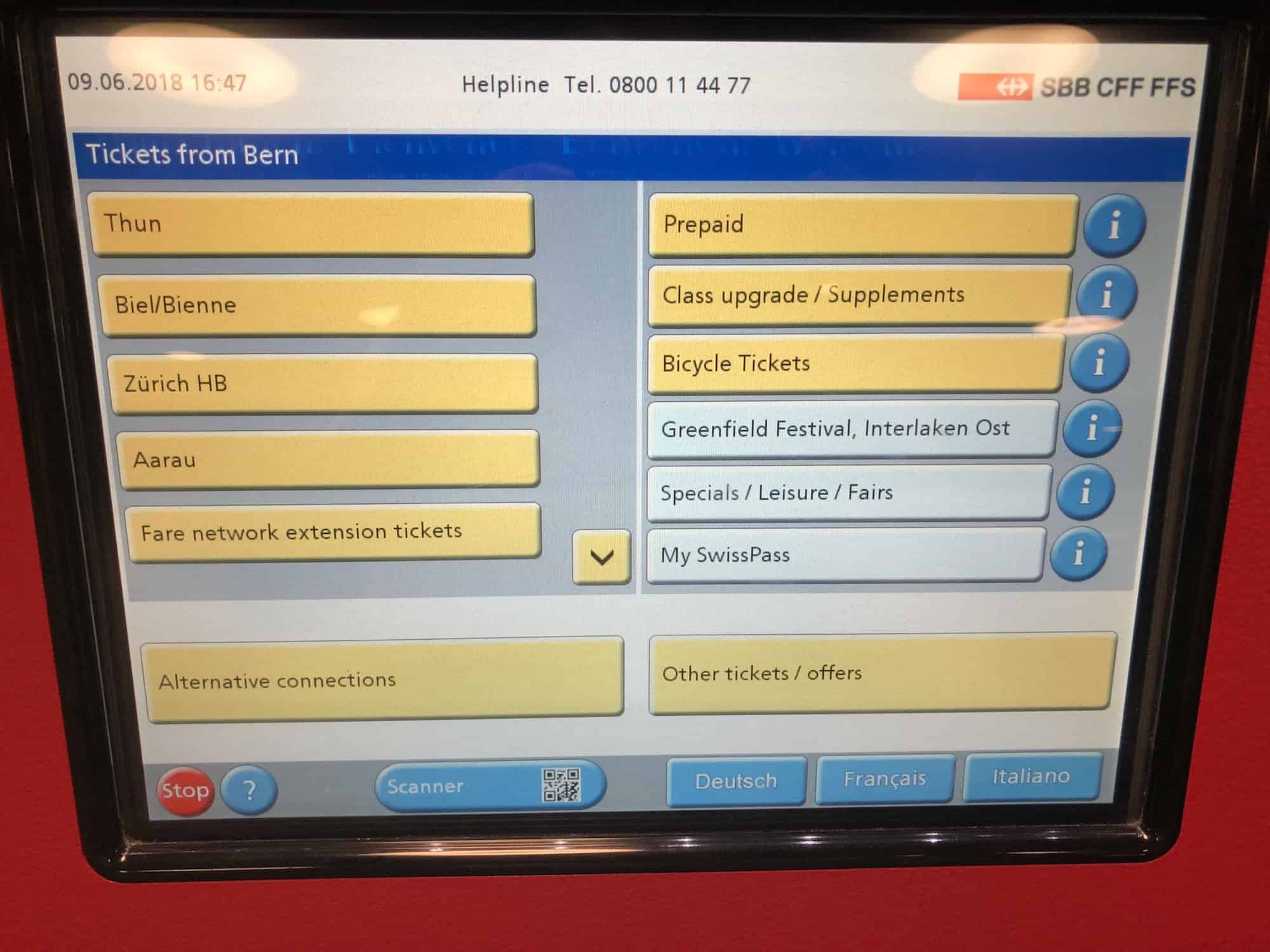
Swiss Travel Pass : Are you planning on traveling frequently throughout Switzerland during your trip? Consider purchasing a Swiss Travel Pass to save some money!
6) First vs. Second Class
One of the decisions you will have to make regarding train travel in Switzerland is whether to get a first or second class train ticket. First class tickets cost quite a bit more money than second class and depending on what type of traveler you are, it may be worth it.
The main two differences between 1 st and 2 nd would be comfort and quiet.
First class seats are wider and more comfortable than second class seats. You can definitely tell the difference but that is not to say that second class seats are uncomfortable.
I also want to point out that every train can be different, with some first classes being very high class and others not as much.
The second difference to point out is that first class is noticeably quieter and at times less hectic than second class. Especially when you get to some of the more touristy areas (around Interlaken for example) there are a large number of tourists getting onto these trains.
So many at times that people are standing and sitting on the stairs. It also can get very loud in these situations.
In first class, it is much more relaxed and quiet. There are not as many people in the cabin and you (probably) won’t have to worry about seating arrangements throughout your trip.
Below are some pictures showing the difference between 1st and 2nd class. The first two pictures are 1st class and you can see they have some wider seats, an armrest and are generally more comfortable.
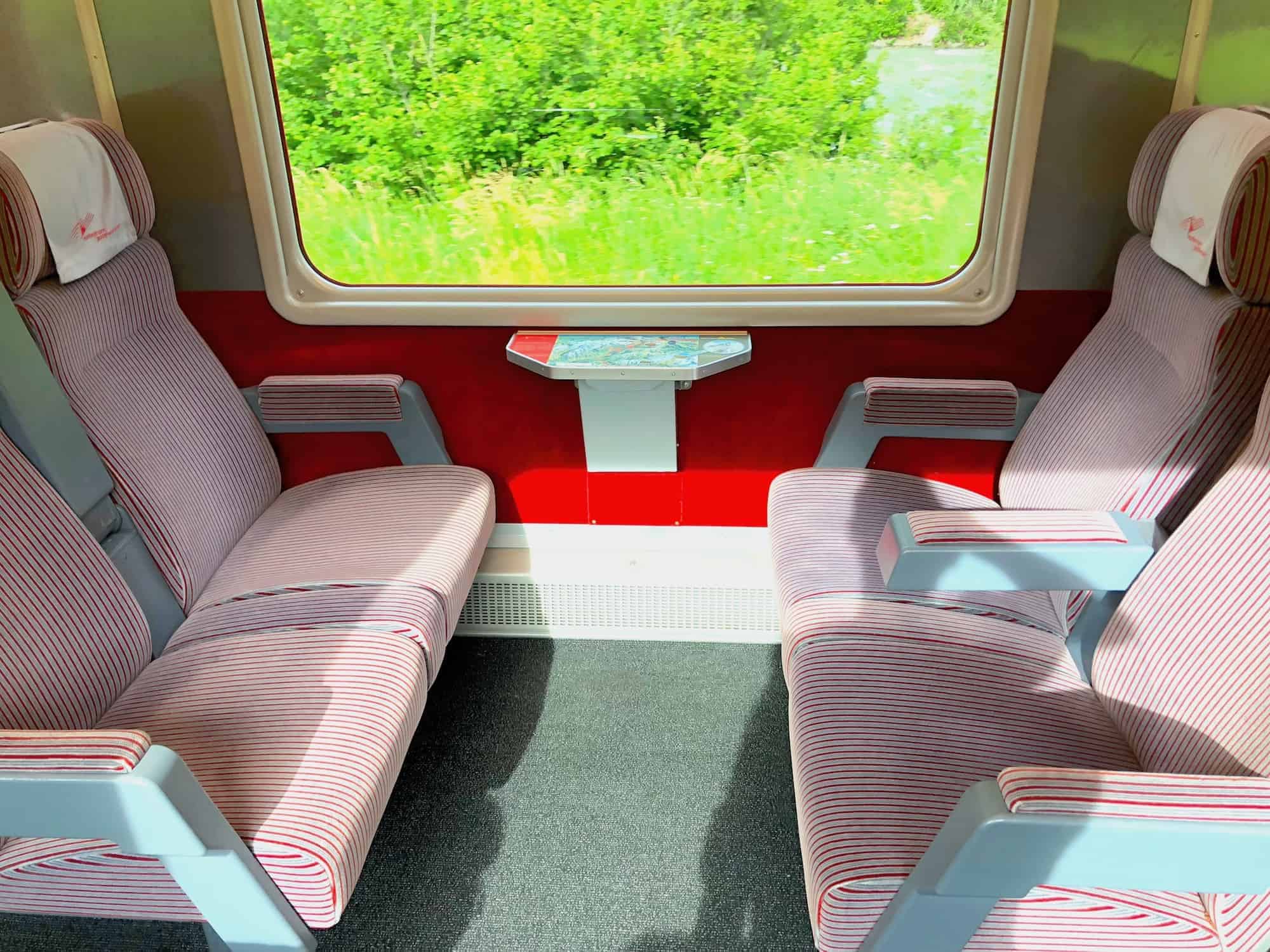
Note in this last picture, the train car is actually split into two (1st class one section and 2nd class another). In the background you can see those 1st class seats and how they compare to those in the forefront of the picture.
Another last thing to note about 1st and 2nd class is that before you actually get on the train, most platforms have sections (A, B, C, D, etc) and on the electronic screens it will show you which section you should stand next to for each class.
If you do end up getting onto a first class section with a second class ticket, you will just have to walk forward/backward depending on where the second class train cars are.
7) Mountain Transport
Throughout the article I had mentioned a few times that some mountain transport options are not fully included in the travel passes.
To give you a better sense of what that means I have listed out a few of the main mountain transport routes that you may take while visiting the Jungfrau region .
Of course there are more mountain transport options beyond this area, but the below can give you a sense of what is and is not fully covered under the travel passes.
- Interlaken to Wengen (via Lauterbrunnen) – 100% covered by Swiss Pass
- Wengen to Mannlichen (via cable car) – 50% covered by Swiss Pass
- Wengen to Kleine Scheidegg (mountain train) – 25% covered by Swiss Pass
- Interlaken to Murren (either via Lauterbrunnen valley bus or Grutschalp cable car) – 100% covered by Swiss Pass
- Interlaken to Grindelwald (train) – 100% covered by Swiss Pass
- Grindelwald to First (cable car) – 50% covered by Swiss Pass
As a general way to think about it, once you start taking cable cars, cogwheels, and some higher up trains, you will pay 25% – 50% of the cost with the travel pass (or course the half fare card will give you the 50% off of everything).
For the Jungfrau region you can take a look at the ticket prices for different routes to get a better idea on how much certain trains cost.
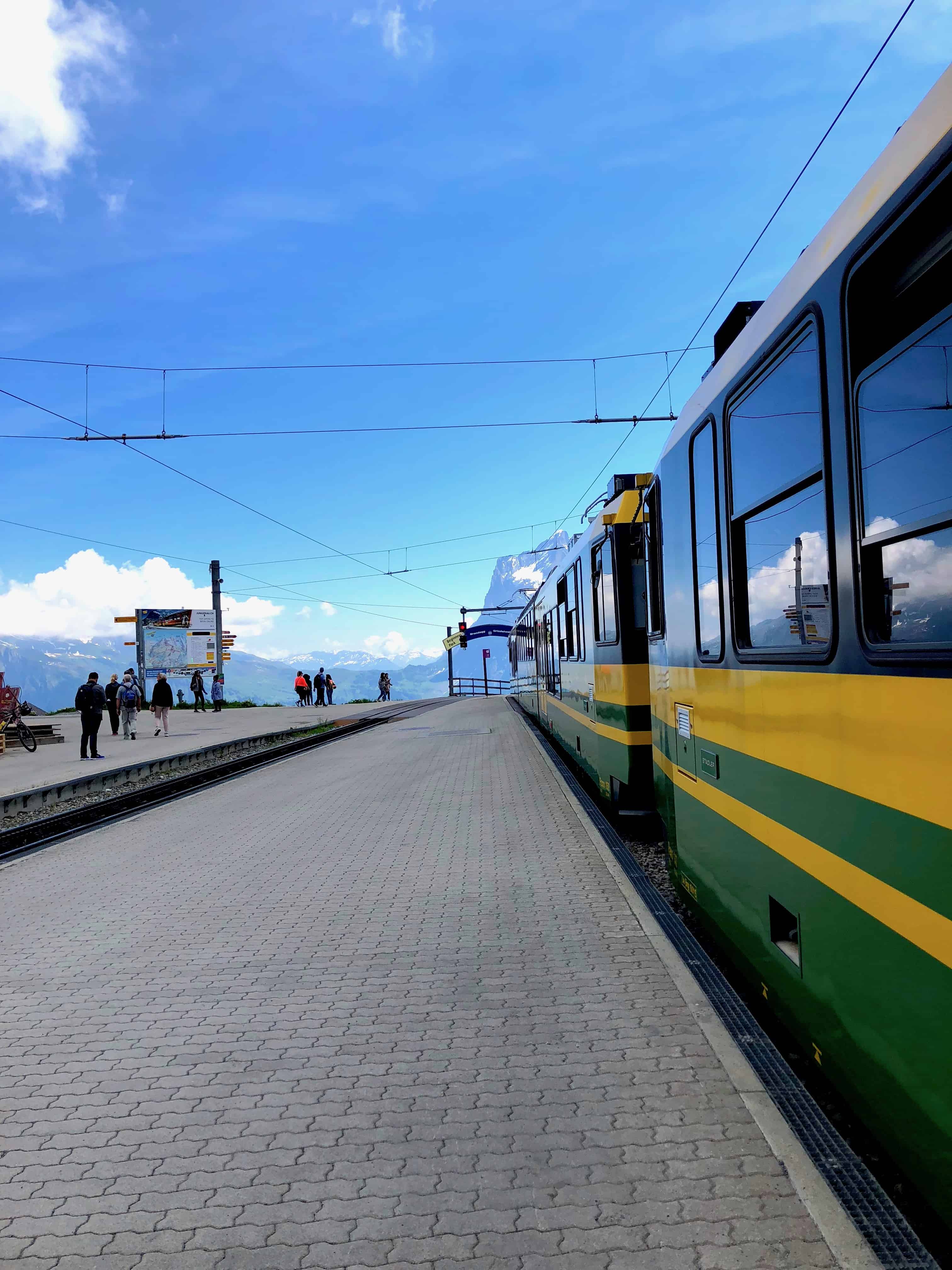
8) Panoramic / Scenic Trains
In Switzerland there are certain routes that are considered Panoramic or Scenic Train Rides.
While there are a variety of routes, four of the main ones include the Glacier Express, Bernina Express, GoldenPass, and Gotthard Panorama Express .
These trains are known to have some of the most spectacular of views throughout a journey. It is not uncommon for a full day’s activity to just be taking a train from one city to the next.
It is important to note that on some of these routes you may be able to book special trains or seats that are far more unique than a normal train ride.
Whether that be more luxurious options, full panoramic windows, or even seats that face the front window of the train.
While these may be options to consider, there are normal trains on the routes as well if you don’t need the full experience (i.e. you don’t need to book the actual Glacier Express trains).
Below is just a quick overview of the scenic trains mentioned above:
Glacier Express
Route : Zermatt to St Moritz Duration : 8 hours Highlights : Panoramic Windows & Optional “Excellence Class” Reservation : Required Normal Train Option : Yes, but not direct (4 different trains)
Bernina Express
Route : Chur to Tirano Duration : 4 hours Highlights : Panoramic Windows Reservation : Required Normal Train Option : Yes, but not direct
Route : Lucerne to Montreux Duration : 5.5 hours Highlights : Three different train rides connecting the route Reservation : Not required for first two legs; recommended for third leg Normal Train Option : Yes
Gotthard Panorama Express
Route : Lucerne to Lugano Duration : 5.5 hours Highlights : Boat Ride & Train Ride Reservation : Required Normal Train Option : Yes
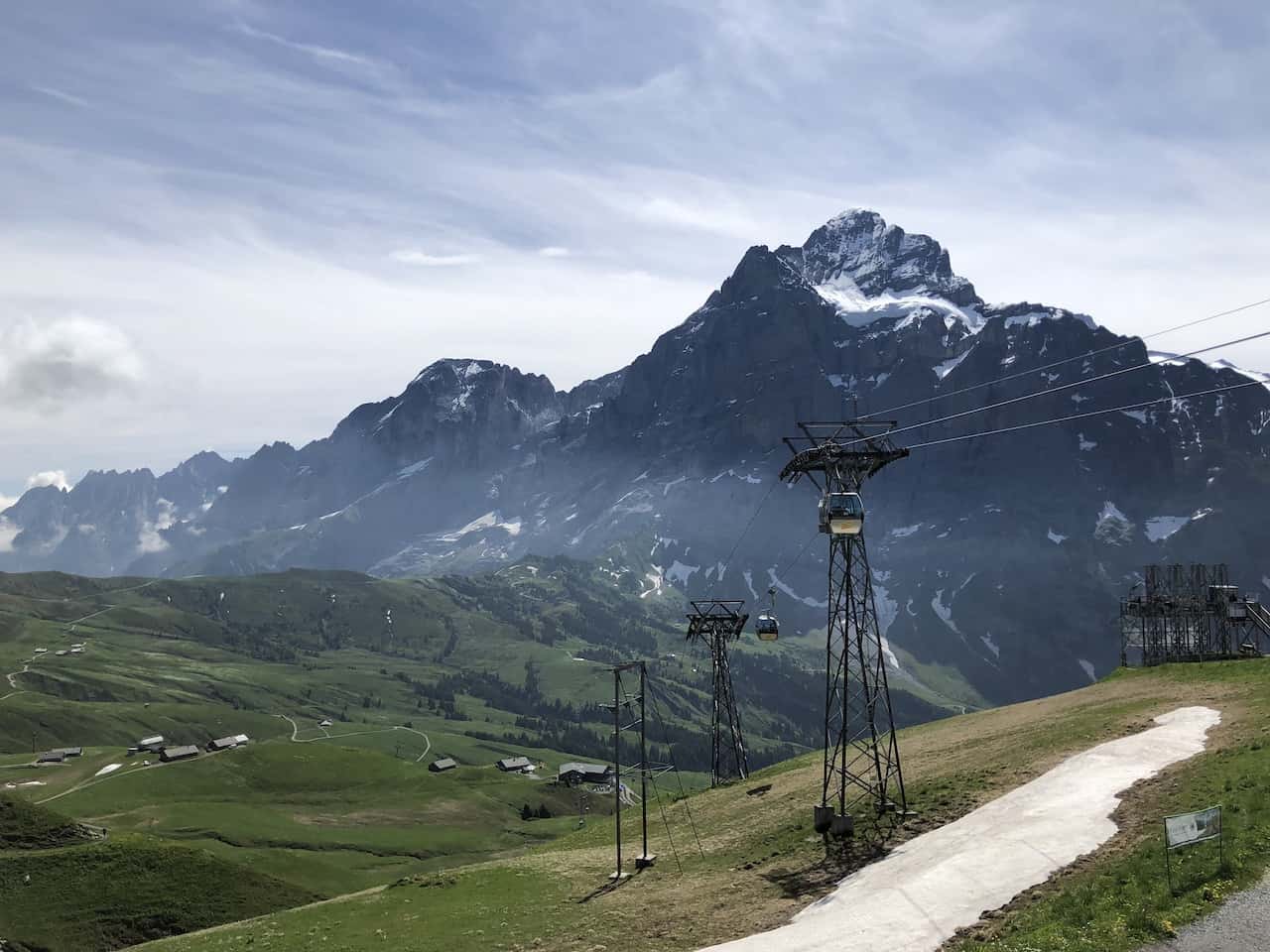
9) Quick Tidbits
1. While you can reserve seats on certain normal trains (non scenic/panorama trains) for a small fee (5 CHF), it is not necessary and tickets do not run out . If it is a very popular time and the train is crowded, worse comes to worse you might have to stand (or catch the next train).
2. The one time you do have to purchase a reservation and book a seat would be on some of the Panorama train rides (i.e. Glacier Express).
3. There are lockers at nearly every main station . If you are making a pitstop in a city for a day when going from one place to the next, you can leave your luggage in lockers at the station. Large lockers are usually in the 7 CHF range.
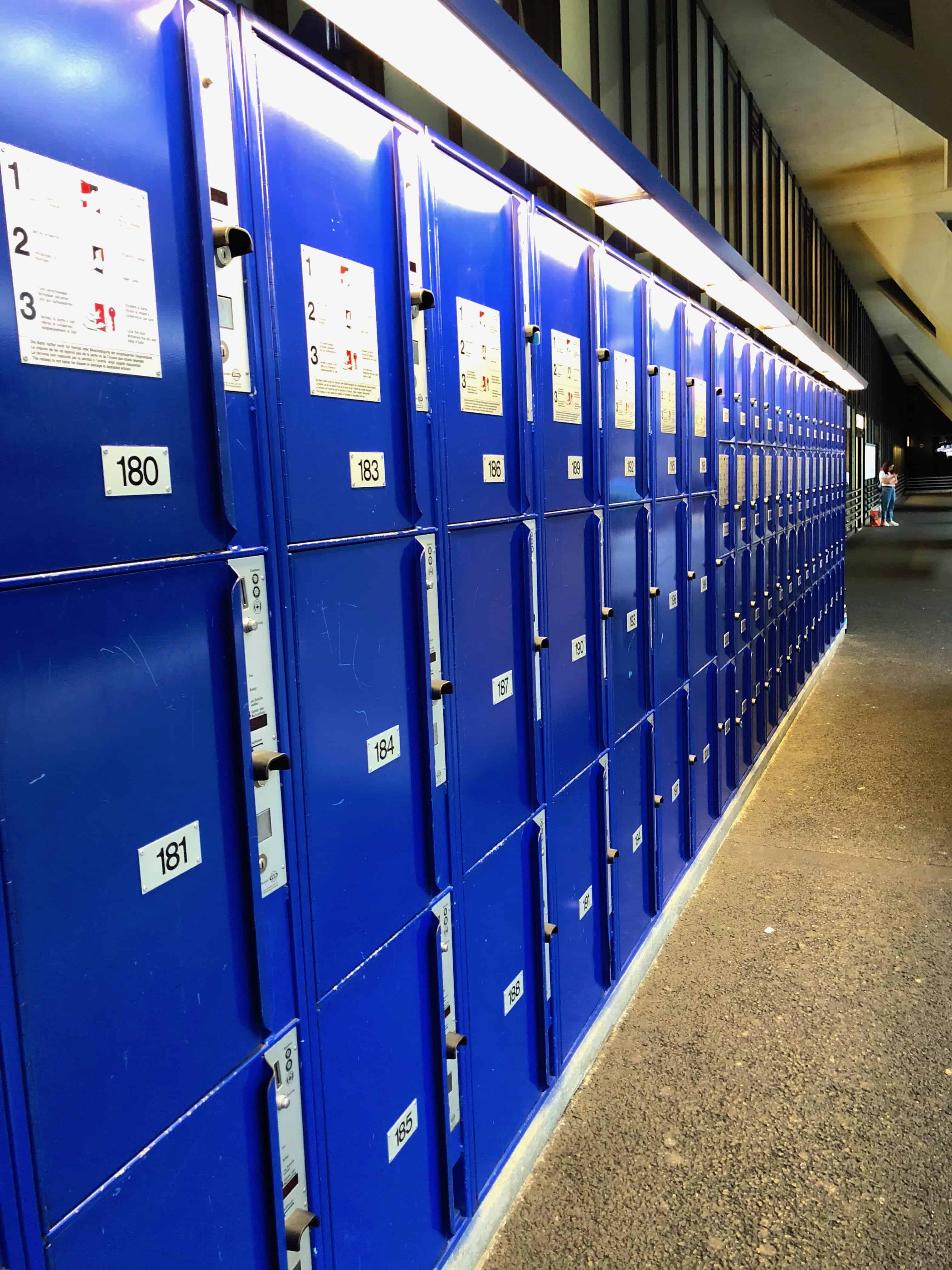
4. Do not forget to keep your tickets if you are on a multi leg route . If you are switching trains you will have to show your tickets on each leg of the trip.
5. Not all doors open by themselves on a train . You will see buttons on both the outside and inside of trains (and busses) that will open the doors. It can get confusing at times when you are stopped at a station and the doors do not open so you might have to be a bit proactive here and open them yourself.
6. As mentioned earlier, before you get on a train the board will tell you which sections of the platform are for first vs second class. However it is also important to note that at certain stations, different sections of the platform will take you to different stations ! So be careful in these instances – on the SBB app it tells you pretty clearly what section to stand at if the train does split up at some point.
7. I will mention this again – trains run on time ! When a train says it will depart at 9:52 it will nearly always depart at 9:52. So give yourself time beforehand to get to the station, buy tickets (if needed) and make your way to the platform.
8. Last but not least – look outside! The scenery on some of these train rides are just incredible . From lakes to valleys to mountains, the trains travel through all types of landscapes. So instead of opting for that nap, take a look through the window and enjoy the surroundings.
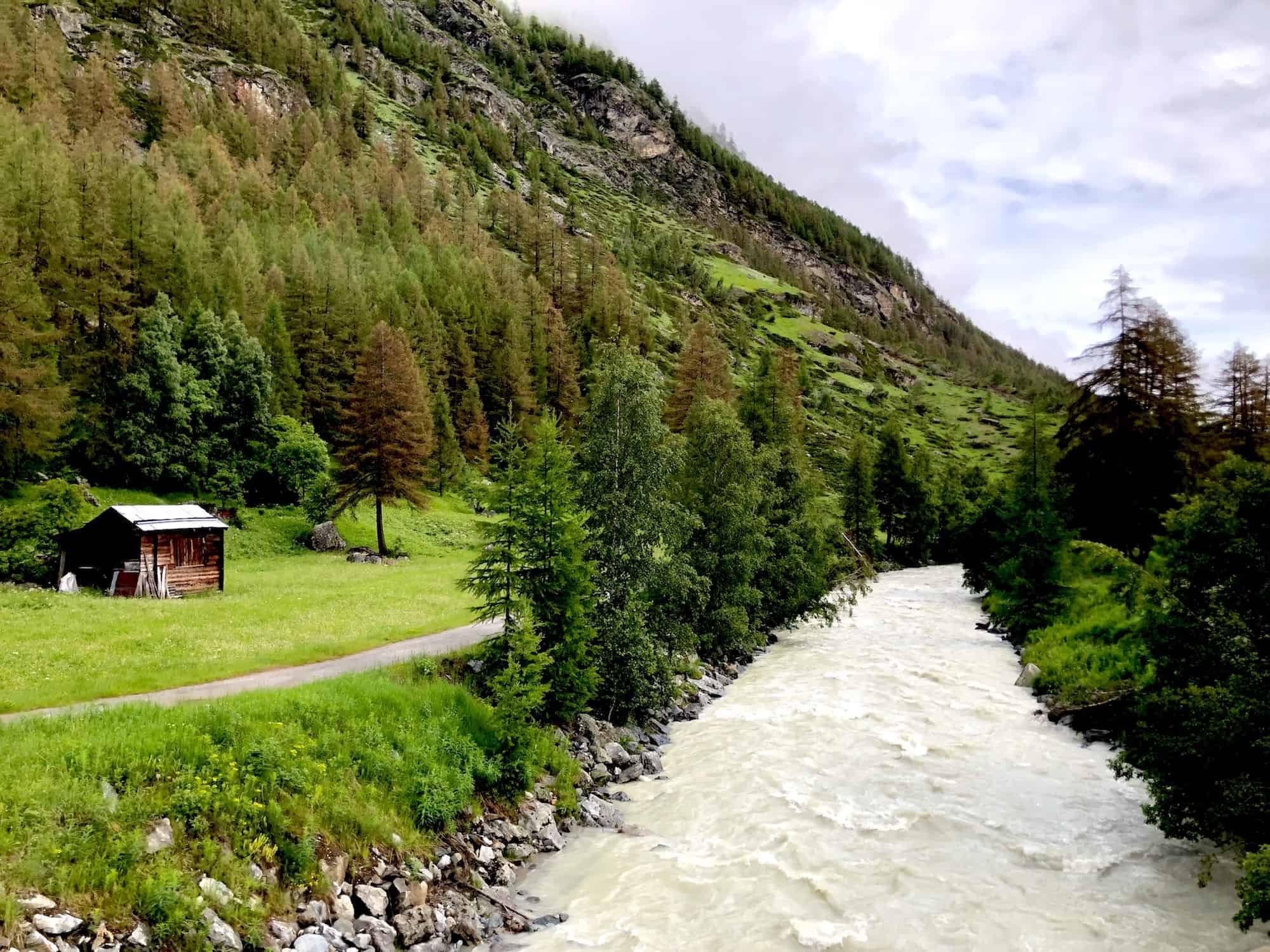
That is your full recap for train travel in Switzerland. I know it if a lot of info and I don’t think I even covered all of it but the guide should be a great starting point for you to better understand how to prepare yourself for the train aspect of your trip.
As always if you have any questions or comments please feel free to write them in below and I will get back to you as soon as possible.
Check out the other Switzerland itineraries and guides up on the site like the guide to hiking in Switzerland . Thanks for reading and safe travels out there!
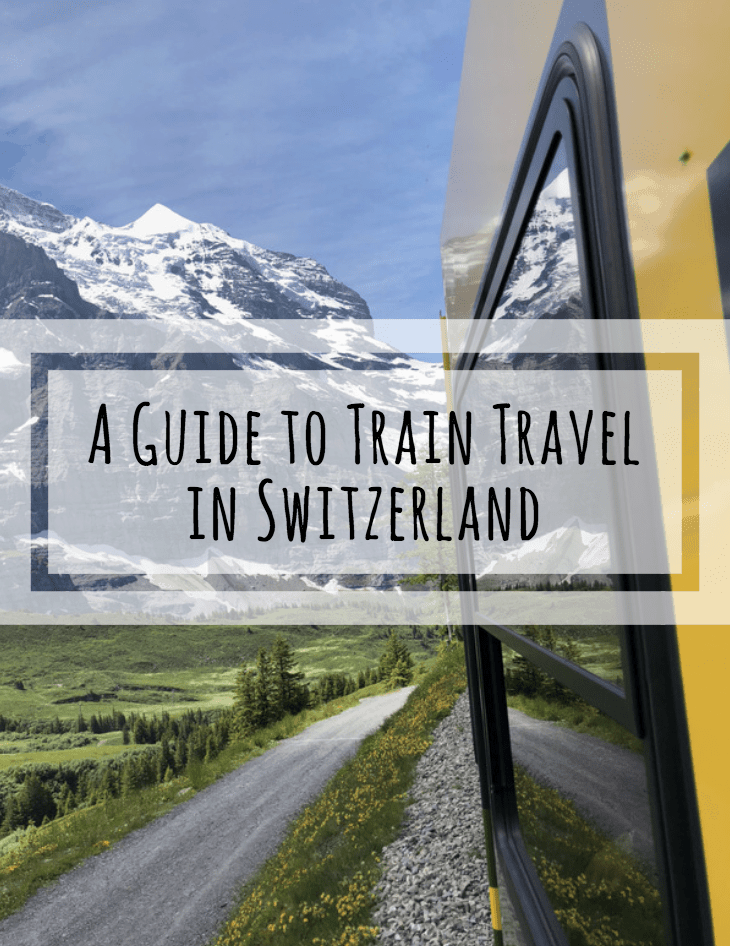
Related posts:
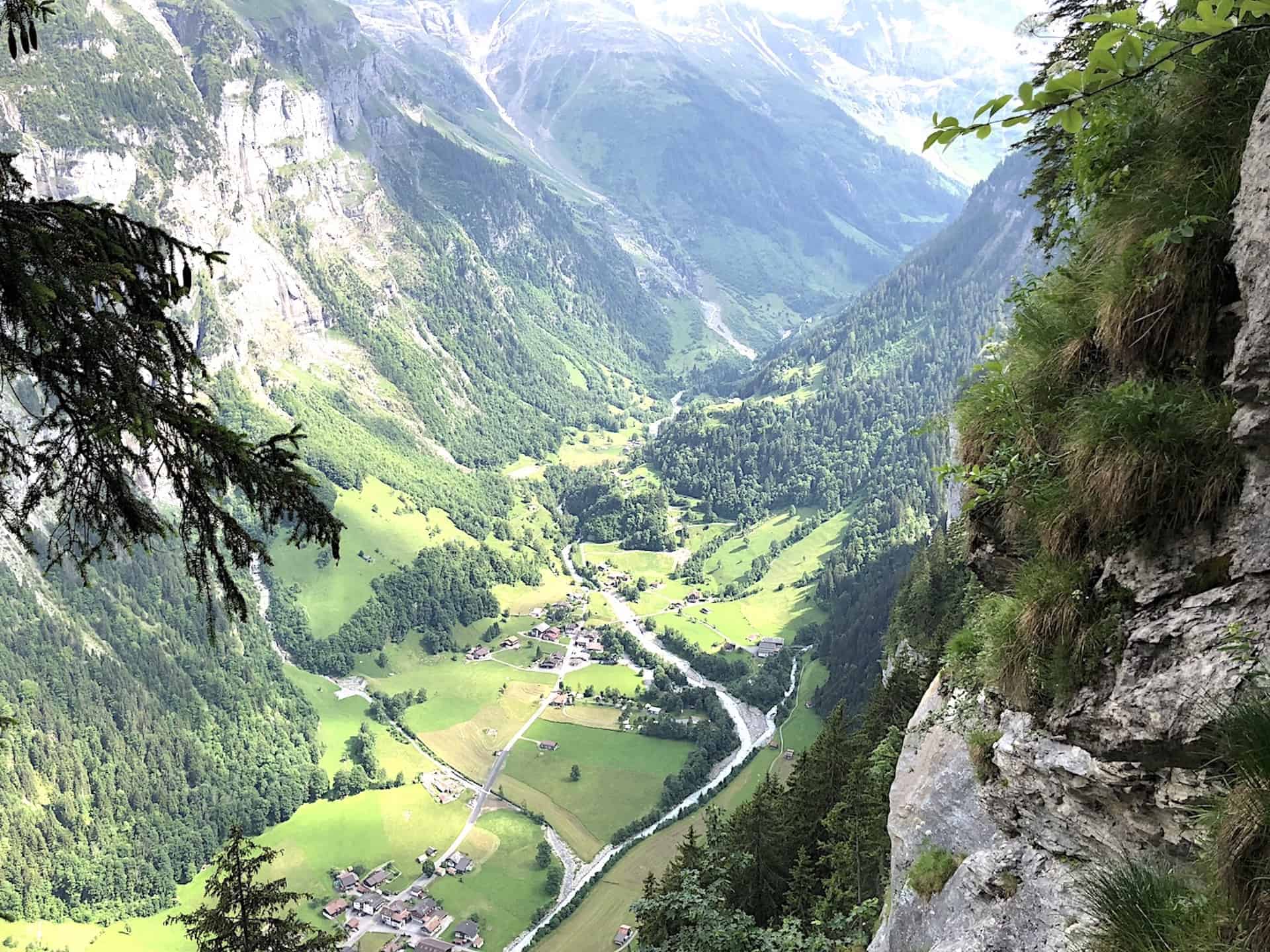
Sharing is caring!
Wednesday 3rd of January 2024
Hi Charles - Great blog and very very helpful.
I wanted to reach out and ask the following:
I am planning a train trip from Verbier-TV to St. Anton on February. I have a couple of options but wanted to ask you what would be the best time during the day.
The options are:
1. Verbier (10:30 AM) - St. Anton (5:00PM) 2. Verbier (11:30 AM) - St. Anton (7:00PM) 3. Verbier (2:30 PM) - St. Anton (9:00PM)
The cheapest option is the third option (2:30PM) but wanted to ask you if it's better to go on the earlier trains(10:30 AM and 11:30 AM) because of the views, landscapes and light? Or not worth the extra money?
Also, could you please give us your thoughts on no exchange/flexibility tickets?
Thursday 28th of December 2023
Hi. I wonder if people over the age of 65 are not welcome in Switzerland? I don't see information on how much do Swiss Travel Passes cost for people over 65s? Do you have information on that topic? Thank you.
Thursday 21st of December 2023
I have never read a travel blog so detailed and easy to understand!. Kudos to you Charles..I am planning 6 days in Switzerland in the end of May. I am planning to use your 5 days itinerary and to add to it one more day in Zurich to cover Rhine falls. Is it ok?.. and can I add three days to cover northern Italy? Milan, Lake Como, and Venice. Is it possible and how much extra is it going to cost me for Italy part? And I want to use Swiss travel pass. Thanks in advance.
Rocky Lewis
Tuesday 10th of October 2023
Is English widely spoken and do stations and machines take credit cards? Please and thank you?
Friday 13th of October 2023
Hi Rocky - English is spoken to an extent. I do not think you will have too much trouble for the most part. The machines do take credit card.
Saturday 30th of September 2023
hello Charles .
i have been breaking my head for past few days and luckily came across your blog here..what a life saver .
please advise (will try to keep it short)
we are planning from 14 Dec to 2 Jan 2024 , a couple & a 1.5 yrs baby.
1 how to go about , i want to cover zurich,lucerne (day trip probably) Jungfrau region stay at wengen or Lautter for 4 nights
then what? i want to go to zermatt but want to cover another place between Interlaken and zermatt(maybe stay there 2 nitghts)where can we go which is nice and scenic .. from zermatt galcier ex to st moritz ...back to zurich (train)
should i go for half fare or 15 day swiss pass
how to get the zermatt from interlaken
considering a baby , what weather can we expect mid to end dec is it super crowded in streets , stations etc
also are the walking roads stroller friendly ..
what can i do in Jungfrau valley for 4 nights
what about phone cards and should ne carry cash or cards are accepted evrey where ?
are euros also acceppted or only CHF
of with i could call you :)
thanks manu
Sunday 1st of October 2023
Hi Manu - glad the articles have helped. You have quite a few questions here so I will try my best to answer!
1) Between Interlaken and Zermatt, you can choose from a few options. I like the idea to detour to Bern, which is one of my favorite cities in Switzerland. It can give you a break from the mountains as you enjoy some city life for a day or so. Another option is Crans Montana, which is just off the route too - that will be more mountain focused.
2) It is hard to say Swiss Pass vs Half Fare Card without knowing every last train you are taking. However, I have usually found that the Swiss Pass is worth it, even if it is a bit more expensive. Having the flexibility to take trains when you want and not purchase tickets can be very helpful. Plus you do get tons of free museums if that is of interest.
3) Zermatt to Interlaken can just be done by train. Usually there may be some train switches in Visp and/or Spiez
4) The weather will begin to be on the colder side with snow up in the mountain towns. If you are going to be there during holidays, you can expect a larger amount of crowds around. But overall, it will still be an enjoyable experience.
5) Some streets will be stroller friendly, others maybe not as much depending on cobblestones, etc. I think for the most part it should be ok
6) I have many travel guides for the Jungfrau - feel free to browse the Switzerland page for more
7) You can purchase a SIM card at the airport. I used little cash in Switzerland as credit card were accepted in most places. Always bring some local currency just in case. Euros may be accepted in some places, but not all.
How to Use Swiss Trains and the Swiss Travel Pass
:max_bytes(150000):strip_icc():format(webp)/ElizabethHeath-Headshot-horiz-e7525e97616245958bf3d94e8db7f119.png)
Mark Williamson/GettyImages
Switzerland's rail system is among the most modern and efficient in Europe. It includes commuter trains, long-distance routes connecting Swiss cities and connecting Switzerland to the rest of Europe, and smaller trains that stop at quaint towns and villages. It also includes scenic trains that pass through stunning landscapes and mountain ranges, as well as cogwheel trains and funiculars that connect to high-altitude mountain towns. The broader Swiss public transport system is also comprised of buses, boats, and even some ski gondolas and cable cars.
Visitors to Switzerland who don't wish to rent a car will find that the Swiss travel system can take them just about anywhere in the country they want to go. We'll allow, however, that the system for planning and booking travel is not the most intuitive for first-time users—there's an extensive range of choices for tickets and travel passes, plus more than one site for purchasing. We'll help you make sense of it below.
Read on for a guide to using Swiss trains and other forms of transportation, plus information on whether the Swiss Travel Pass is the right deal for your journey to Switzerland.
Taking the Train in Switzerland
If you are only taking a few train trips in Switzerland, you can most likely get by with point-to-point tickets, as opposed to a travel pass. To buy these, you'll use the Swiss Federal Railways (abbreviated SBB) website. SBB runs regional (R, RE, and IR) trains throughout the country, as well as S-Bahn commuter trains and IC and ICN intercity trains. Regional trains are slower but stop at all or most stations, regardless of size. S-Bahn commuter trains offer frequent service between cities and their suburbs and may connect cities that are in relative proximity. Fast intercity trains stop at major towns but do not serve smaller municipalities.
Purchasing Tickets
The SBB website sells one-way or round-trip tickets between Swiss cities, as well as the City Ticket, which includes travel to a city—Bern, for example—plus a one-day travel pass for public transportation in that city. To use the site for a single trip, follow these steps:
- Select a point-to-point ticket. Insert your point-to-point destinations, and select a date of travel up to two months in advance.
- Select your preferred train time/route and enter passenger information. Options will appear, including the City Ticket and upgrades to First Class. On shorter train rides, you probably don't need to spend the extra money—30 percent or more—for the First Class coach, as Second Class on Swiss trains is comfortable and clean. First Class seats are larger and farther apart from one another, and the coaches are usually less crowded, which may be preferable on a longer trip. Note that when SBB initially calculates a fare, it does so with the assumption that you have the half-fare Travelcard, a discount card that must be purchased. Since you probably won't be traveling with this card (see more below), you have to select "No discount" in the discount cards field—and your ticket price will double as a result.
- Complete your purchase with a credit card. You will be issued a voucher, which you can either print out or keep on your handheld device.
- Persons with disabilities can, when searching for tickets, select "Barrier-free travel" from the pull-down menu labeled "Standard view" to see only trains that have wheelchair accessible carriages.
- Supersaver tickets are available on select routes and times and can offer discounts of up to 70 percent.
- Kids travel free. Children up to 16 years of age travel free with a parent, so long as that parent has a valid ticket. But you must pick up a Swiss Family Card before traveling—it's available at every station or point of sale.
If you've purchased your tickets online, you will not have a seat reservation, which is generally not required on domestic Swiss trains. Simply climb aboard a first- or second-class carriage, depending on your ticket class, and find a seat. Once the train is underway, a conductor will come by and scan your ticket. A digital sign inside each coach shows the next station, so you should have plenty of time to gather luggage and exit the train when it stops.
Each train seat or group of seats is fitted with an electrical outlet and may have a USB charger. Intercity trains may have restaurants with tableside service, or bars offering drinks and light snacks, including hot items. Long-distance intercity trains have a family coach as the first or last car—it's a kid-friendly coach with games and a soft play area.
If you prefer to purchase tickets in-person or on the same day of travel, you can do so at the SBB counter or office in any Swiss train station. For a surcharge, you can also reserve seats when you purchase, which is not possible online. Alternatively, if you can proceed without human assistance, you can buy tickets from SBB machines in all stations.
Other Forms of Transportation
Small towns and mountain locations not served by trains are connected with a series of cogwheel trains, funiculars, and cablecars, as well as buses run by PostBus, a subsidiary of Swiss Post. Across Switzerland's many lakes, tour boats and ferries carry leisure and commuter passengers. There are also a handful of famous scenic train rides in Switzerland which require special tickets and reserved seats.
- Boat service on Swiss lakes is usually administered locally or regionally around the lake. In Zurich, for example, boat travel can be purchased from ZVV, the Zurich Transportation Network , which runs the city's buses, trams, trains, and boat services.
- Cogwheel trains, funiculars, and cablecars are either run by the local/regional authority or by private entities—the latter, especially when they connect to ski resorts.
- The Bernina Express and Glacier Express scenic mountain trains are run by the Rhaetian Railway service, but can also be purchased through the SBB website. Tickets for the Golden Pass train between Montreux and Lucerne can be bought on the Golden Pass website .
- Bus tickets for buses run by PostBus can be purchased through the SBB site, which will automatically suggest bus travel when train travel is not available.
Swiss Travel Pass: What's Included & How Much It Costs
If you are planning to do a lot of traveling within Switzerland and want to try out its many forms of transportation, the Swiss Travel Pass may be worth the investment. The pass is available only to visitors from outside Switzerland and includes free travel on almost the entire network of trains, boats, cogwheels, funiculars, and more. Those not free with the pass are deeply discounted. The pass also includes free public transportation in more than 90 Swiss cities and towns and free admission to more than 500 museums across the country.
Swiss Travel Passes also allow for free travel for children, but as with regular rail passes, families need to pick up the Swiss Family Card before they initiate travel. The pass, while expensive, simplifies the travel process for visitors. If you prefer not to travel over three, four, eight, or 15 consecutive days, the Flex Pass allows for a set number of days of travel within 30 days and is well-suited to those planning a more extended stay in Switzerland.
Getting Around Switzerland: Guide to Public Transportation
Getting Around Frankfurt: Guide to Public Transportation
Your Trip to Switzerland: The Complete Guide
Getting Around Paris: Guide to Public Transportation
How to Travel Between Italy and Switzerland by Train
Getting Around Zürich: Guide to Public Transportation
How to Travel From Florence to Paris by Train, Bus, Plane, and Car
Your Trip to Zurich: The Complete Guide
The Best Rail Passes in Europe
Switzerland Travel Guide
Taking the Train in Italy
Getting Around Salt Lake City: Guide to Public Transportation
Getting Around Lisbon: Guide to Public Transportation
About Single Europe Train Tickets
Getting Around Los Angeles: Guide to Public Transportation
Getting Around Madrid: Guide to Public Transportation
Navigate to myswitzerland.com
Destinations
Your swiss holiday time.
Holiday destinations
- Summer holiday destinations
- Winter sports & ski resorts
- Family destinations
Attractions
- Top attractions
- UNESCO World Heritage sites / biospheres
- Travel by train, bus or boat
- Top museums
- Swiss Parks
- Scenic nature
Experiences
Additional content about subnavigation experiences.
- Family excursions
- Food & Wine
- Group excursions
- Guided tours
Summer & Autumn
- Bicycle & Mountain bike
- Adventure & Sports Summer
- Zoo & animal experiences
- Ski and snowboard
- Cross-country skiing
- Snowshoe and winter hiking
- Tobogganing
- Winter excursions
- Christmas in Switzerland
Cities & culture
- Parks, Gardens and Squares
- Architecture
Experience Tour
- Car, motorcycle - Grand Tour
- Train, bus, boat – Grand Train Tour
- Mountain excursions
Accommodation
- Typically Swiss Hotels
- Wellness & Spa
- Family Hotels
- Bike Hotels
- Boutique Hotels
- Inspiring Meeting Hotels
- Swiss Historic Hotels
- Luxury hotels
- Winter sports hotels
Other types of accommodation
- On the farm
- Bed and Breakfast
- Mountains huts
- Group accommodation
Transport & Stay
- Travel to Switzerland
- Barrier-free travel
- Tickets public transport
- Service & support
- Money and shopping
About Switzerland
- General facts
- Custom and tradition
- History of Switzerland
- The Swiss Art and Culture Scene
- Health Travel
- Sustainability
Weather & Climate
- Climate in Switzerland
- Snow Report
- Water and pool temperatures
- City offers
- Touring offers
- Wellness offers
- Nature and outdoor offers
- Offers for families
Where are you from?
- België (Nederlands)
- Belgique (Français)
- Deutschland
- Netherlands
- Russia (Россия)
- Schweiz (Deutsch)
- Suisse (Français)
- Svizzera (Italiano)
- Switzerland (English)
- United Kingdom
- Canada (English)
- Canada (Français)
- China 中文简体
- China 中文繁体
- Gulf countries العربية
- Japan 日本
- Korea 한국어
- United Arab Emirates
- New Zealand
- International
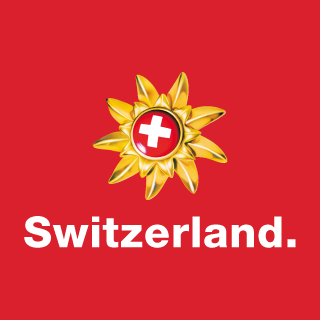
Language, region and important links
- Slovenština
Service Navigation
- Help & Contact
Swiss Travel Pass
Exploring Switzerland has never been easier! For foreign guests, the all-in-one ticket Swiss Travel Pass is the key to Switzerland’s public transport network.
This single ticket enables visitors to explore Switzerland from end to end by train, bus and boat on 3, 4, 6, 8 or 15 consecutive days. With the Swiss Travel Pass Youth, young people up to their 25th birthday travelling through Switzerland benefit from a 30% discount off the regular Swiss Travel Pass ticket fare.
- Unlimited travel by train, bus and boat. View area of validity
- Unlimited travel on premium panoramic trains (seat reservation fees and/or surcharges apply).
- Unlimited use of public transport in more than 90 towns and cities.
- Free admission to more than 500 museums .
- Mountain excursions included: Rigi , Stanserhorn and Stoos
- Up to 50% discount on many other mountain excursions.
- Up to 30% discount on SBB RailAway offers. Available at all ticket counters within Switzerland.
- Children from their 6th up to their 16th birthday accompanied by at least one parent (holding a Swiss Travel System ticket) travel free of charge with the complimentary Swiss Family Card .
- Children under 6 years of age who are accompanied by a holder of a valid Swiss Travel System ticket travel free of charge.
- The Swiss Travel Pass is available as e-ticket.
Information
- A seat reservation and/or supplement is required to travel on some trains/buses/boats such as Glacier Express, Bernina Express, Gotthard Panorama Express and Palm Express.
- Swiss Travel System tickets are available to persons with residence outside Switzerland and the Principality of Liechtenstein
- In Switzerland, fares apply in Swiss Francs as detailed in the chart (in case of cash payment in EUR, USD or GBP: current exchange rates apply)
General provisions and legal information
Price – adult.
Valid on consecutive travel days.
Validity: 01 Jan 2024 – 31 Dec 2024
Price – Youth
Valid on consecutive travel days, for young travellers up to their 25th birthday (30% discount).
Swiss Family Card
With the Swiss Family Card , children from their 6th up to their 16th birthday travel free of charge.
On request, a Swiss Family Card is provided free of charge, entitling children from their 6th up to their 16th birthday to travel free if accompanied by at least one paying parent.
Bonus Benefits with the Swiss Travel Pass
Regional passes, sales outlet swiss travel system.

Get our Rail Planner app
Plan your trip, get extra discounts, and show your Pass as you go.

Our favorite spring routes
Celebrate spring with these 7 off-the-beaten-path train routes

All about seat reservations
Everything you need to know about booking your seats

Alternatives to Busy Routes
Travel between popular European cities without seat reservations

Through our Chatbot in the bottom right corner.

Ask the Community
Browse questions from fellow Eurail travellers, or ask your own!
- Plan your trip
- Suggested Itineraries
Switzerland Itinerary
- Order overview
- Reservations overview
- My Trips & Travelers
- {{translatedTraveler}} {{#promotional}} {{currencySign}} {{standardPrice}} {{/promotional}} {{quantity}}x {{currencySign}} {{finalPrice}}
- Child {{childPasses}}x FREE
- {{translatedPassType}}
- {{translatedValidityPeriodDescription}}
- {{translatedClass}}
- Remove Pass(es)
- {{variant.localizedTravelPackDescription}} {{quantity}}x Free
- {{variant.localizedPassUpgradeDescription}} {{quantity}}x {{currency}} {{price}}
- Your order will arrive by {{expectedDeliveryDate}} 1 x {{currency}} {{price}}
Your cart is empty
Traveling Switzerland by rail gives you a front-row seat to one of the most beautiful countries in the world. Its mountain ranges are ideal for skiing or hiking and provide amazing backdrops to the cities. If the scenery isn't enough, try the country's world-class products. Just think: Swiss cheese, Swiss chocolate, Swiss watches - they sure know how to improve the quality of life! Experience it all with a Global Pass where you can include Switzerland in your choice of 33 different countries.
Itinerary in short
For this itinerary, we recommend:
- Eurail pass: Global Pass
- Travel days: 5 days within 1 month
1. 2. 3. 4. 5.
Click here or on the map to view this route in our Trip Planner
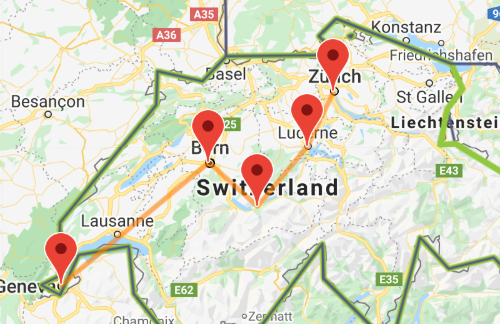
Zurich, Switzerland
Zurich, Switzerland’s largest city, is an international business capital. With several identities – historical and traditional, young and cool, wealthy and cosmopolitan – it’s a city that appeals to all tastes. This is your chance to explore one of the most livable cities in the world!
Stroll along the Bahnhofstrasse , a world-class shopping boulevard, then visit Grossmünster church, a symbol of the Swiss Reformation. The Old Town is a pedestrian zone with surprises all across its hidden alleyways. At night, enjoy the energetic nightlife.
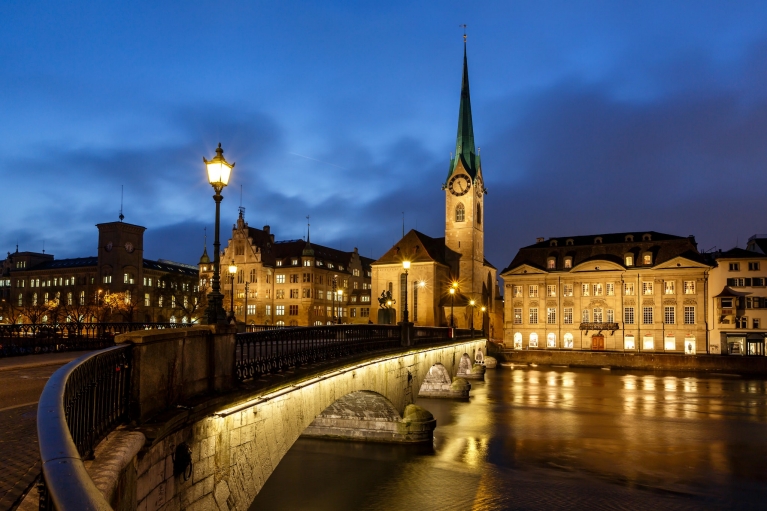
Travel time:
Lucerne, Switzerland
Luzern (Lucerne)
Lucerne (Luzern), Switzerland
A visit to Lucerne isn't complete without visiting the Chapel Bridge . Built in the 14 th century, it's known as the oldest wooden bridge in Europe. The bridge runs past the Water Tower , which was originally part of the medieval city wall. These two structures form a key attraction and a picturesque photo opportunity!
Another remnant of medieval times is the Musegg Wall . Three of its towers can be climbed for a panoramic view over Lucerne. Can’t get enough of the scenery? Then make your way up Mount Pilatus , a landmark steeped in legend. It was once thought that a dragon lived on the mountain.
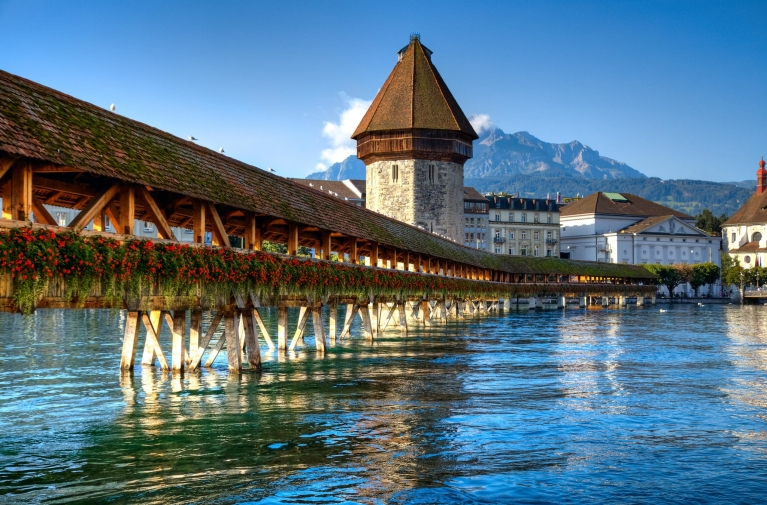
Interlaken, Switzerland
Interlaken Ost
Interlaken is Switzerland’s (and perhaps Europe’s) adventure-sport mecca, where anything goes - from world-class snowboarding and skiing pistes to paragliding and skydiving above the sparkling Brienz and Thun lakes or plunging through white rapids aboard a raft.
The Jungfrau Railway chugs its way to the Jungfrau mountain , which towers dramatically over the town. Once you get there, you'll be rewarded with mind-blowing views of the mountain giants Jungfrau, Eiger, and Mönch. You'll get a discount on this private railway attraction with your Eurail Pass.
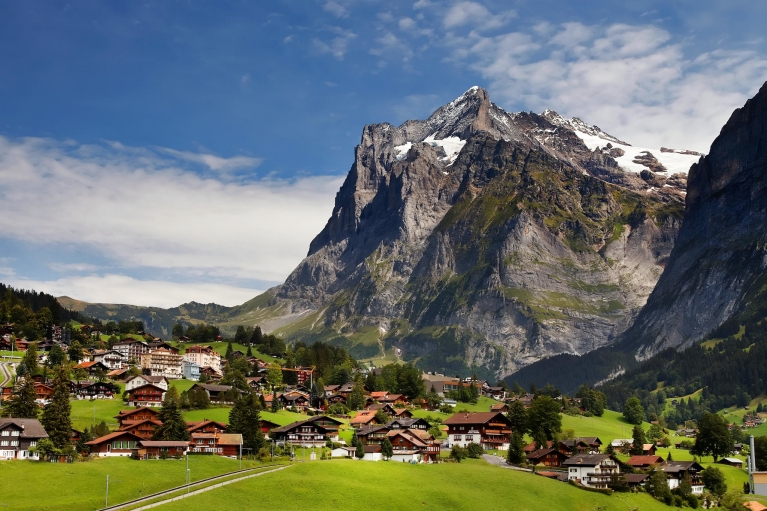
Bern, Switzerland
Bern (berne), switzerland.
Bern, the capital city of Switzerland, will have you marveling at its beauty. It’s idyllic, no matter the season. In summer, you can swim in the perfectly blue Aare River , and in winter, you can go sledding at Gurten Hill and enjoy views over Bern.
The layout of Bern’s medieval Old City has been preserved since its founding in 1191 and can easily be explored on foot. Check out the Zytglogge , the medieval astronomical clock tower. Also important is the Cathedral of Bern , which provides magnificent views over the city.
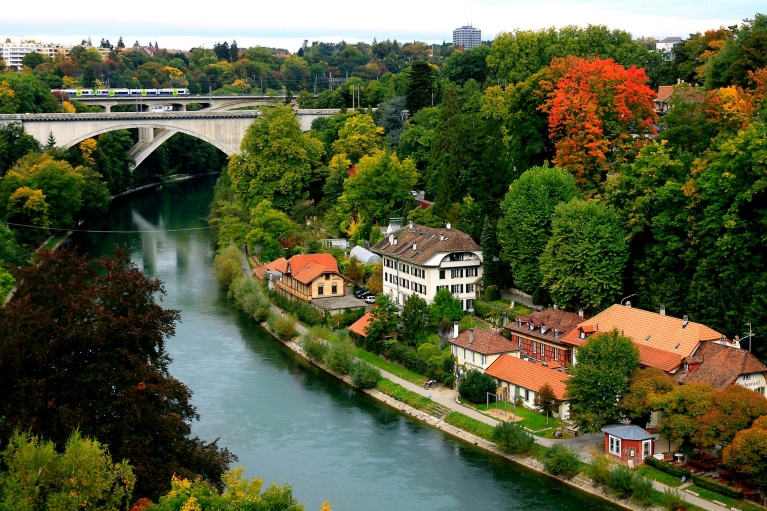
Geneva, Switzerland
Genève (Geneva)
Geneva (Genève), Switzerland
Geneva is a global city with both brains and beauty. It’s home to some of the brightest minds on earth, including those at the research organization CERN – the birthplace of the World Wide Web. The United Nations and International Red Cross are also stationed there. Guided tours are available at their offices and museums.
It’s hard to miss the Jet d’Eau , a large fountain that lies where Lake Geneva meets the Rhône River. Its stunning backdrop of the French and Swiss Alps is definitely photo-worthy. Nearby, the famous Flower Clock (L’horloge fleurie) is a living tribute to Switzerland’s watchmakers.
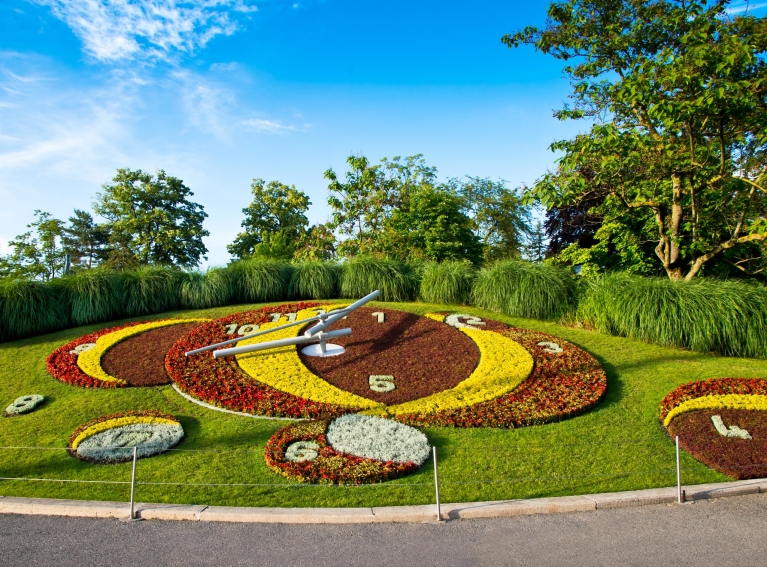
Experience this itinerary with the Eurail Global Pass!
Related pages, france itinerary.

Italy Itinerary

Western Europe Itinerary

Switzerland

Change of currency
You cannot change the currency once you have a Pass in your cart. Remove the Pass, and then change the currency on the website header.

Switzerland Train Travel: Understanding and using the Swiss Rail System
Switzerland is famous for its railways. The trains in Switzerland are known to be on time, clean and frequent and very often they also offer superb views. In fact, Switzerland’s rail, bus and boat network is widely regarded as the best public transport in the world.
The Swiss public transport network is operated by more than 250 public transport companies including train, bus, boat and mountain railways. We’ll cover all the essential information you need to know to travel by public transport in Switzerland in this article.
With the Switzerland railway and public transport network being so efficient, travelling by train is generally the best way to travel in Switzerland for both locals and visitors.
In this train travel in Switzerland guide, we explain the difference between a Swiss rail pass and regular Swiss train tickets, give you details about the major train routes in Switzerland, tell you where you can find a Swiss rail timetable, where to buy your Switzerland train tickets and how to make your Switzerland train reservations online.
[ This post may contain compensated links. Please see my disclosure policy for more information. ]

What's in this Article
Quick summary of the different Swiss rail tickets and Swiss rail passes available to tourists
Individual switzerland train tickets vs a swiss rail pass – swiss train tickets explained.
In most cases when it comes to Swiss train tickets for tourists, you are going to be better off purchasing at least some form of Switzerland train pass rather than if you buy Switzerland rail tickets individually.
When it comes to purchasing individual tickets for train journeys in Switzerland, there are many variables that determine the price. The main factor is when you book the tickets as well as the timing of the actual train travel.
Booking last minute tickets tends to be most expensive, which means you can’t be very flexible with your travel.
You’ll also want to consider if you plan on doing any mountain excursions during your Switzerland travel as these day trips alone can make it well worth your while to purchase a pass.
We outline the various ticket and rail pass options below.

Swiss Travel Pass
The most convenient ticket option for use on public transport in Switzerland for tourists is the Swiss Travel Pass . This is an all-in-one ticket for the entire public transport network and it acts just like a hop on hop off ticket.
The Swiss Travel Pass can be purchased for use on consecutive days or you can select a Swiss Travel Pass Flex which entitles you to a specific number of travel days within a one month period.
🇨🇭 Read our detailed guide to the Swiss Travel Pass .
Swiss Half Fare Card
Another popular option when it comes to Swiss rail tickets is the Half Fare Card. With the Half Fare Card, you can buy point-to-point train tickets with a 50% reduction.
The Swiss Half Fare Card is valid for one month and half price tickets can also be purchased for mountain top excursions, boats and buses.
🇨🇭 Read our detailed guide to the Swiss Half Fare Card .
Point-to-point tickets
Should you only plan to do one or two trips by public transport, and are only travelling a short distance, a normal point-to-point ticket can also be an alternative at a good price.
When purchasing your point to point tickets, keep in mind that you need to specify the exact travel days. Subsequent changes or exchanges are not possible.
If you’re after cheap train tickets, Switzerland Railways sometimes have Super Saver Tickets available. There are a limited number of Super Saver tickets available on selected routes, which offer savings of up to 70%.
Super Saver tickets also have the option of first or second class travel as well as the additional half fare discount for holders of the Half Fare Card. These tickets (subject to availability) can be purchased between 1 and 60 days prior to travel.
Again, the Super Saver ticket is only valid for the selected date of travel.

Child Fares
If you are travelling with children aged between 6 to 15 and not travelling with the Swiss Travel Pass, but instead with one of the other passes mentioned above or simply point to point tickets, it is recommended that you purchase a Junior Travel Card for CHF 30 for each child.
This card then allows children to travel free of charge alongside you. The card is valid wherever the Half Fare card is available and on many other transport services as well.
If you are travelling with a Swiss Travel Pass or Half Fare Card, you are better off obtaining the free Swiss Family Card as this entitles accompanied children to travel free of charge. We cover the Swiss Family Card in more detail in this article .

Where to buy Swiss train tickets and rail passes
We highly recommend you buy your Swiss Travel Pass online before you leave home. This means you avoid long queues at the ticket counter in Switzerland and you can also conveniently hop on the first train, tram or bus on arrival in Switzerland.
Whilst you can buy Swiss Passes at most railway stations in Switzerland, buying your Swiss Travel Pass in advance also means that you can get this significant expense out of the way long before your vacation begins.
The Swiss Travel Pass is sent as a PDF via email so you can save it to your mobile device and print it out at home, which makes purchasing the Pass online super easy and convenient.
Click here to purchase your Swiss Train Pass and then as soon you arrive in Switzerland you can start taking advantage of all the benefits that come with the pass.
Also just to note that the Swiss Travel Pass is only available to be purchased by people who permanently live outside of Switzerland.
CLICK HERE TO BUY YOUR SWISS TRAVEL PASS
Just like the Swiss Travel Pass, we also recommend you buy the Swiss Half Fare Card online before you leave home. It can be purchased from any train station in Switzerland but you’ll skip the queues by buying it online.
CLICK HERE TO BUY YOUR SWISS HALF FARE CARD
If you are only doing a few short journeys, buying train tickets in Switzerland is easy. Larger stations have manned ticket counters which are open at specific times throughout the day but all stations have ticket machines.
The ticket machines are easy to use – you can select to display the instructions in English – and payment can be made by credit card.
You can also purchase point-to-point tickets on the Swiss Federal Railways website or the SBB Mobile app.

Regional Passes
In addition to the Swiss rail passes and point to point tickets mentioned above, there are other regional train passes in Switzerland for some of the more popular tourist regions in Switzerland.
Passes available include the Jungfrau Travel Pass for the Jungfrau region, Berner Oberland Pass for the Bernese Oberland including Jungfrau region, and the Tell Pass for the Lake Lucerne region.
These passes can be purchased locally but we recommend you purchase them online before you leave home. This will save you having to queue to purchase your tickets on arrival in Switzerland. You can buy them via the following links:
Jungfrau Travel Pass
Berner Oberland Pass
🇨🇭 Read our guide to choosing the best Swiss rail pass for your trip.
Seat reservations on Swiss trains
For most trains in Switzerland you do not need any reservations. On some longer distance Swiss trains you can make a seat reservation if you prefer to but it’s not compulsory.
On Switzerland’s scenic trains it is mandatory to make a seat reservation. This applies to the Bernina Express, Glacier Express, GoldenPass Express and Gotthard Panorama Express trains.
Also keep in mind that if you are crossing into many of the neighbouring countries you will most likely require a seat reservation.
It is essential that seat reservations are purchased before travel.
How to make seat reservations on Swiss trains
Seat reservations on regular trains.
If you want to make a seat reservation for your train holidays to Switzerland you can do so via the SBB website, mobile app or at the ticket counter at a station.
If you’d like to guarantee a window seat on a specific train, for instance the Luzern-Interlaken Express, you may wish to make a seat reservation. It costs CHF 5 per seat to make a reservation on regular trains.
Seat reservations on panoramic trains
Seat reservations for the premium panoramic trains should be made directly on the official website of the train company. Seat reservations are compulsory for all passengers, including children (aged 6 and over) and holders of a Swiss Travel Pass.
Due to the popularity of the Swiss panoramic trains, it is highly recommended that you book your seat reservation as early as possible. Seat reservations are available to purchase from 90 days before travel.
You’ll find more information about the panoramic trains, and links to our detailed guides which include step-by-step instructions for purchasing seat reservations, below.

Travelling on public transport in Switzerland with a Swiss rail pass
After purchasing any of the Swiss rail passes that we’ve mentioned above, you will receive an email with your valid pass as a PDF attachment.
We recommend saving the PDF to the wallet on your mobile device or taking a screenshot of it which you can save to your device’s photos. You should also print a paper copy and upload a copy to the Cloud, just in case your battery goes flat or your phone gets lost or stolen.
If you have purchased a consecutive day Swiss Travel Pass (or a regional pass), you do not need to validate or activate your pass before travel.
However, if you have purchased a Swiss Travel Pass Flex, you must activate your pass prior to each day of travel. We cover the instructions to do this in detail in this article .
Travelling by train – Swiss Travel Pass instructions
On boarding the train, you can sit in any free seat in the correct class of travel. For example, if you have a 1st class rail pass you can sit anywhere in a 1st class carriage.
Seat reservations are not required on the majority of trains in Switzerland – exceptions are the premium panoramic trains, as we mentioned above.
Before boarding the train, look for the numbers 1 or 2 on the outside of each carriage so you know which carriage to get on.
When requested by the ticket inspector, you’ll be required to show your Swiss Travel Pass or your regional pass. No other tickets are required except in the case of panoramic trains when you will also be requested to show your seat reservation.
Travelling by bus – Swiss Travel Pass instructions
Most of the buses in Switzerland operate under the ‘self-control’ model. This means, if you are travelling with a Swiss Travel Pass, you do not need to show the pass to the driver upon entry.
You may board through any of the doors and sit wherever you wish.
Random ticket checks do occur so it’s your responsibility to ensure you carry your valid Swiss Travel Pass (or regional pass, if applicable) at all times.
There are still a few smaller bus lines where you need to show your pass to the bus driver, but you will notice when this is the case. In these instances there is only one door open (the front door) through which you can board.
NOTE: Most buses and some trains (particularly regional trains) do not automatically stop at each station en route. These stations are marked as ‘stop on request’ on timetables.
If you wish to stop at the next approaching station, you need to press the ‘stop’ button which you’ll find throughout the bus or train carriage.

Travelling by boat – Swiss rail pass instructions
Swiss Travel Pass holders do not need to purchase any additional tickets for most boat trips in Switzerland. You can simply board the boat and sit in the correct class – the upper deck is for 1st class passengers and the lower deck is for 2nd class passengers.
Show your Swiss Travel Pass (or regional pass, if applicable) to the ticket inspector when requested.
Travelling by mountain railway – Swiss rail pass instructions
In order to board a mountain railway (cable car, funicular or cogwheel train), in many instances you need to proceed past the ticket counter and through a turnstile.
As a ticket is often required to be inserted into the turnstile in order for the gate to open, we recommend you stop at the ticket counter to present your rail pass, even if the ride is fully covered by your pass.
The ticket counter representative will either wave you through (if no access ticket is needed), issue you with the necessary ticket (if the ride is fully covered by your pass), or request payment at the discounted rate applicable to your rail pass.
You can see which mountain excursions are free and discounted with the Swiss Travel Pass here .

Travelling on public transport in Switzerland with a regular Swiss train ticket
When travelling by train in Switzerland it is essential that you purchase your ticket before boarding. On most trains there is no ticket machine or conductor on board so you must have your ticket before entering the train.
When requested, show your ticket (and seat reservation if you are travelling on a panoramic train) to the ticket inspector.
Bus tickets can be purchased from the driver upon entry. You should enter through the front door of the bus.
Tickets for boats and mountain railways can be purchased at the ticket counter before boarding.
Random ticket checks do occur and heavy fines apply to passengers who do not have the correct ticket.
You may sit in any free seat (in the correct class of travel) on trains*, buses, boats and mountain railways.
*except panoramic trains
Taking luggage on Swiss trains
Although there is not a huge amount of space for storing luggage on Swiss trains, most trains do have a dedicated luggage storage area in the area close to where you board the train.
Some trains also have space under and between the seats where luggage can be stored.
There are also overhead racks above the seats where you can place small luggage.

How much luggage can I bring?
Whilst there is no restriction on the Swiss trains as to how much luggage you can bring, it is highly recommended that you limit yourself to a medium sized suitcase and one piece of hand luggage or a backpack.
There is no porter service in Switzerland so you have to take care of your luggage. You are required to bring your own luggage to the platform and to carry it onto the train.
However, there is always a ramp or an elevator or an escalator at the station and step-free access to the platform. For this reason, a suitcase with wheels works perfectly.
Luggage shipping services
If you would prefer not to have to travel with your luggage, SBB offers a luggage shipping service. This can be a good option if you’d like to ship some of your luggage ahead for the next part of your vacation, or you’d like to stop off en route to do some sightseeing.
There are a variety of luggage shipping options available, such as:
- Luggage from station* to station* (2 days later): Take your luggage to a station* and 2 days later collect it from your destination station*.
- Luggage from door to door (Same day or next day): They will collect your luggage from an address in Switzerland and deliver it to your address. This is great for hotel to hotel luggage transfers.
- Luggage from station* to door (2 days later): Take your luggage to a station* and they will deliver it to your address 2 days later.
*not all stations offer this service.
Useful information about the best public transport system in the world in Switzerland

Advantages of train travel in Switzerland
Traveling by train in Switzerland has many advantages. Not only is Switzerland train travel a wonderful way to see the beautiful countryside and stunning Swiss Alps, it is also the most efficient and often the cheapest way to travel in Switzerland.
Here is a brief overview of the advantages of traveling by train through Switzerland:
- Centre to centre – travel in Switzerland by train is super convenient with pretty much the entire country well serviced and stations are located right in the centre of town.
- Travel like the locals – when you take a Switzerland train ride, you will be getting around just as the Swiss do.
- Relaxing – Rather than driving a hired vehicle for your Switzerland trip, sit back and relax, while you are transported to wherever you need to go. A train ride through Switzerland is extremely comfortable and a great way to relax on your holiday.
- Frequent – The Swiss Federal Railways are extremely efficient and trains are very regular. You’ll rarely wait long for any connections for your train trips through Switzerland.
- Scenic – Switzerland would have to be one of the most beautiful places in the world to travel by train – the landscape is absolutely perfect for train travel. The Swiss rail network goes right past the most scenic landscapes including all the stunning lakes, snow capped mountains, flowing streams and quaint little villages. In Switzerland it’s certainly more about the journey rather than the destination.
The Swiss Rail Network
The Switzerland train system is just brilliant, with the entire country well-connected enabling you to pretty much travel anywhere you wish. The Swiss rail system is said to be the world’s densest railway network and the trains are well connected with other forms of public transport.
The entire public transport system operates with a fully integrated timetable which means there are seamless connections between Swiss rail, bus, boat, tram and mountain railway services.

Major train routes in Switzerland
Below we have listed the details of some of the major Swiss train routes.
- Zurich to Lucerne train: A direct journey time between 45 minutes to just over 1 hour depending upon the train. The fastest route is train 70 which has a journey time of 45 minutes and only two stops, or train 75 with a journey time of 50 minutes and four stops. Trains to Lucerne run regularly at around every 30 minutes.
- Zurich to Interlaken train: A journey time between just over 2 hours to 3.5 hours with a connection in either Bern or Lucerne. A direct service operates from Zurich Airport and Zurich to Interlaken every two hours.
- Zurich to Geneva train: A direct journey time of around 2.75 hours. Trains to Geneva run regularly at around every 1 hour.
- Zurich to Basel train: There are multiple options which take between just under 1 hour to a little over an hour. The fastest route is train 2-Y which is a direct route traveling towards Mulhouse Ville and takes just under 1 hour. Another good option is to connect in Olten with a total journey time of 1 hour.
- Zurich to Zermatt train: This a 3.25 hour journey which requires a connection in Visp. Some routes require a connection in both Bern and Visp, but don’t add much time to the journey.
- Zurich to Bern train: A direct journey time of between just under 1 hour to 1.5 hours. For the fastest journey take train 8 towards Brig which is a direct trip, other routes require a connection in Olten or Aarau. Trains to Bern run regularly at around every 20 minutes.
- Geneva to Zurich train: A direct journey time of around 2.75 hours. Trains to Geneva run regularly at around every 1 hour.
- Geneva to Zermatt train: This is a 3.75 hour journey which requires a connection in Visp. Some routes require a connection in both Bern and Visp, but don’t add much time to the journey. Trains to Zermatt run regularly at around every 1 hour.

SBB Mobile – the essential app for travelling in Switzerland by train
Before you start travelling in Switzerland by train, we highly recommend you download the Switzerland public transport app, SBB Mobile.
This app is vital if you plan to travel by train in Switzerland – or any means of public transport – and will make your travel so much easier.
On the app you will be able to purchase point to point Swiss train tickets online, check all the train routes Switzerland has, look up SBB timetables (and timetables for all the public transport operators) and find out which platform your train departs from.
Another handy use for the SBB Mobile app is checking where you should stand on the platform. For instance, if you are wondering ‘where is first class on Swiss trains?’, the app can tell you exactly whereabouts on the platform the first class and second class carriages will stop.
All information is displayed in real time so if there’s a delay (which is rare in Switzerland) or you’d like to follow your journey live, you can do so on the app.
🇨🇭 Read our guide to using the SBB Mobile app when you travel Switzerland.
Panoramic Trains in Switzerland

For many people on holidays in Switzerland, a trip on a Switzerland scenic train is at the top of the must-do list.
A panoramic train in Switzerland takes you through some of the most beautiful regions in all of Switzerland, with many of the trains having specially built panoramic windows to maximise your view.
Below you’ll find an overview of these scenic train routes in Switzerland.
Glacier Express
The Glacier Express is referred to as the “world’s slowest express train” and is also known as one of the most scenic train rides in Switzerland.
This scenic train in Switzerland runs between St Moritz and Zermatt and crosses 291 bridges and passes through 91 tunnels.
The entire scenic train of Switzerland trip is just over 8 hours and runs twice a day during the Winter months and four times a day during the Summer months – however please note that only two trains complete the entire journey.
Seat reservations are compulsory on the Glacier Express – even for Swiss Travel Pass holders – and start at CHF 39 per person.
🇨🇭Read our detailed guide to the Glacier Express .
Gotthard Panorama Express
Running between Lucerne and Lugano, this panoramic train of Switzerland starts by taking a cruise across Lake Lucerne in a steamboat before passengers board the train at Flüelen.
En route you will pass through the world’s longest tunnel.
The entire train trip through Switzerland takes 5.25 hours and runs once a day Tuesday through to Sunday during the months of late April to late October.
Seat reservations are compulsory for all passengers and cost 16 CHF.
🇨🇭Read our guide to the Gotthard Panorama Express .
Bernina Express
This iconic Switzerland rail journey takes you from the medieval city of Chur across the Swiss Alps to Italy.
The train journey passes through the UNESCO World Heritage Site of Rhaetian Railway as well as through 55 tunnels and crosses 196 bridges before ending at Tirano.
From here you can take the Bernina Express Bus through the Valtellina wine region before arriving in Lugano.
The entire journey takes almost 7.5 hours (4.25 on the train and the remaining time on the bus). The train trip runs twice daily.
Seat reservations are required for this trip and start from CHF 20 each for both the train and the bus.
🇨🇭Read our guide to the Bernina Express .
Voralpen-Express
This scenic train route in Switzerland connects St Gallen and Lucerne and takes just over 2 hours.
Along the way you pass lakes, mountains and the Rothenthurmer Hochmoorebene which is the highest railway viaduct in Switzerland at 99 metres high.
This train trip runs daily each hour. Advance reservations cannot be made for this train.
GoldenPass Line
Over two different connecting trains, the GoldenPass Line runs between Lucerne and Montreux and passes by eight lakes, through six different cantons (Swiss regions) and crosses three mountains passes.
The entire trip on the Golden Pass train in Switzerland takes just over five hours and runs five times a day, all year round.
Seat reservations are not required but are recommended during peak times. Seat reservations range between 5 and 8 CHF per person per sector.
🇨🇭 Read our guide to the GoldenPass Line .

More scenic train routes in Switzerland
Centovalli railway.
The Centovalli Railway route takes passengers between Locarno and Domodossola and runs through the Centovalli (the Hundred Valleys) which provides some of the most beautiful views in all of Europe.
En route you will see waterfalls, vineyards, forests and quaint villages.
The entire journey takes just over 1 hour and operates year-round, departing every 1 to 2 hours.
Seat reservations are required.
🇨🇭 Read more about the Centovalli Railway.
The Chocolate Train Switzerland
For lovers of all things chocolate – a trip on the Chocolate train in Switzerland is a must. The Chocolate train tour Switzerland takes passengers between Montreux and the Cailler-Nestle chocolate factory at Broc.
The train journey itself is relatively short, but with the included stops at the chocolate factory as well as the Gruyères village, this trip takes the entire day.
The Chocolate train departs at 9.02 am and returns at 5.52 pm on Mondays, Tuesdays, Wednesdays and Thursdays between the months of May and June.
It operates daily during July and August, and in September and October services run on Mondays, Wednesdays and Thursdays.
The Chocolate Train costs 90 CHF for second class or 99 CHF for first class.
The ticket price includes entry to the chocolate factory of Nestlé Cailler in Broc, entry to La Maison du Gruyère and coffee and chocolate croissants on the train.
The Cheese Train Switzerland
If chocolate’s not your thing, there is also a Cheese train! Operating from February to June and September to November, the Cheese Train takes passengers between either Zweisimmen or Montreux and Chateau d’Oex.
Passengers learn the secrets of making Swiss Alpine cheese and enjoy a fondue cooked in the traditional way.
A visit to the House of Ballooning and to see an exhibition of GoldenPass MOB miniature trains are also included in the excursion.
The Cheese Train operates on Wednesdays, Fridays, Saturdays and Sundays during the months mentioned above (to 13 November only).
Onboard the trains
Below you’ll find some useful information about the trains in Switzerland.

First Class or Second Class?
Most high speed trains offer a choice of both first and second class carriages (called Coaches). First class seats usually recline and have more legroom. There are generally fewer seats per coach and more space for luggage.
Some high speed trains include a meal in the ticket price (often served to your seat) and where this doesn’t apply, meals and snacks are available for purchase from a dining car or snack cart.
First class coaches are usually quieter with more business and adult passengers travelling in first class coaches. They include power outlets to charge your mobile devices.
Second class seats are less expensive, but not as spacious as there are more seats per car, and often these will be in a compartment-style layout with two bench seats (each seating three people) facing each other.
Meals and snacks can be purchased from a dining car or snack cart.
Second class coaches often have more passenger than first class coaches as more Europeans tend to travel in second class.
Quiet Zones
A quiet zone can be found in first class coaches on certain routes. The areas are well marked and in these areas you should refrain from talking, making phone calls, listening to music (even with headphones) or playing any games on electronic devices.

Whilst there is no free WiFi on Swiss trains, you can use your smartphone as a personal hotspot. You will need a compatible SIM card with data to access the 3G/4G network.
Free internet access is available at 80 railway stations in Switzerland. The service is limited to 60 minutes.
Onboard Restaurants and Bistros
If you’ve wondered “can you eat on Swiss trains?”, the answer is most definitely yes. Most InterCity and EuroCity trains have a restaurant or bistro onboard.
Passengers can usually eat at the restaurant or take it away to their seats. Passengers in first class also have the option of being served at their seat on some trains.
The Family Coach
For families travelling with young children, you are going to want to visit the family coach – which is basically a playground on the train. All double decker InterCity trains on long distance routes have a family coach.
You’ll know if a family coach is on your train as it will be marked on the timetable with ‘FA’.
InterCity tilting trains don’t have the Family Coach but they do have board games available for families at the games tables specially provided on board.
The Family Zone
Another great area for families on single deck InterCity or InterCity tilting trains are the family zones. These areas have much more room for prams, and parents can relax not worrying about their children being too loud and distracting other passengers.
You’ll find the family zone at the very front or very rear of the train.

FAQs about train travel in Switzerland
How far in advance can i book my swiss train tickets.
Like budget airlines, the cheapest fares are usually available to those that book early, therefore it is recommended that you make your reservations as soon as you possibly can.
Most Swiss trains, including the panoramic trains, can be booked 90 days prior to travel .
Where can I find a Swiss train timetable?
Up to date Swiss train timetables can be found on the Swiss Federal Railways website , on the handy SBB Mobile app or you can pick one up from the nearest station.

Do I need seat reservations on Swiss trains?
No, in general for most trains in Switzerland you do not need any reservations. Seat reservations are only compulsory on the premium panoramic trains – Glacier Express, Bernina Express, GoldenPass Express and Gotthard Panorama Express.
How do I make seat reservations on Swiss trains?
Regular trains
If you need to (or want to) make a seat reservation for your train holidays to Switzerland you can do so via the SBB website, mobile app or at the ticket counter at a station. It costs CHF 5 per seat to make a reservation. Higher charges apply for the panoramic trains.
Panoramic trains
If you hold a Swiss Travel Pass and you wish to make seat reservations for one of the panoramic trains, you can do so on the official website of the train.
We include links to the official train websites and step-by-step instructions for purchasing your seat reservations in our articles about the various panoramic trains that we have mentioned above.
Can I buy tickets at the station?
Yes, you can buy tickets at the train stations in Switzerland – you can do this either via a ticket machine or at the ticket counter (if there is one).
Can I buy Swiss rail tickets onboard?
No, you must have a valid ticket before boarding the train.
Are trains in Switzerland safe?
Yes, traveling on trains in Switzerland is very safe. However, it is best to use common sense, be cautious for your own protection and keep your valuables on your person or in sight at all times.
What do I do if I lose my ticket or rail pass?
Most tickets and rail passes are issued as e-tickets. We recommend you keep the original PDF of your ticket (or take a screenshot of the ticket on your mobile device) and print this out or upload it to the Cloud.
If you lose your e-ticket or the e-rail pass or your device gets lost or stolen, you can then simply reprint it from the PDF. If you lose a ticket you have purchased from a ticket machine at the station, unfortunately it cannot be reissued or replaced.
Planning a trip to Switzerland? At Holidays to Switzerland we are passionate about sharing our love of Switzerland and helping you to plan the perfect trip. Read our guide to planning a trip to Switzerland to kick start your travel plans and join our free Switzerland Travel Planning group on Facebook to chat with other past and future travellers. Want monthly news and podcast updates, helpful travel tips and special deals sent straight to your inbox? Subscribe to Holidays to Switzerland and we’ll send you a bonus copy of our 10 Useful Things to Know Before You Visit Switzerland guide. 🇨🇭 Check out our exclusive discount offers and save on your Swiss vacation. 🇨🇭
What is the most common transportation in Switzerland?
Train travel is the most popular way to get around Switzerland.
Is public transport free in Switzerland?
Public transport is not free in Switzerland however it is possible to purchase day passes and rail passes that include travel on public transport.
Do trains run on Sunday in Switzerland?
Yes, trains run seven days per week in Switzerland.
How late do trains run in Switzerland?
It depends on the actual route but most trains in Switzerland run until around midnight.
Why are Swiss trains so good?
Switzerland’s rail network has an excellent reputation due to the frequency and punctuality of its services. The trains in Switzerland are also very clean and comfortable which makes getting around in Switzerland a pleasant experience.

General tips for travelling by train in Switzerland
Whilst rail travel in Switzerland is relatively easy (and very relaxing), there are a few things you should be aware of before you get to the station to ensure you have a smooth departure.
- Arrive at the station in plenty of time. Some stations in Switzerland are huge and it can take a while to get your bearings and get to the correct platform. At really busy stations where there are trains arriving and departing every few minutes, the platform number from which your train is departing may not be advised until 20 minutes before departure. As soon as the platform number is displayed, there’s a huge crush to get there, so give yourself plenty of time.
- Check the overhead boards for the correct train number and the platform from which your train departs. Remember that the destination on the board may be further along the line than you are travelling, therefore your destination may not show. Each train has a train number, just like a flight number, for this purpose. Always match the train number on your ticket to the train number on the overhead board.
- When purchasing an individual (or point-to-point) train ticket, you are usually allocated a specific seat in which to sit and the seat number and carriage number will be printed on your ticket. This applies to most trains however some regional trains which only offer second class carriages are ‘non-reserved’ and you can sit anywhere you like.
- At the platform, check for signs showing where each carriage will stop. The train layout is displayed at most stations and is also in the SBB app. If you are in coach (carriage) #06, for example, some stations have signs showing at which point on the platform coach #06 will stop. In the photo below you can see that coach #06 will stop at Section V on the platform, so by waiting in the correct area, you will be in the right place when the train pulls up. Smaller stations may not have such specific signage but will usually show you where the 1st class and 2nd class coaches will stop.

- Stopping times at stations can be short – three or four minutes is not uncommon. Be ready to board the train (or join the boarding queue) as soon as the train arrives at the station. When lots of people are trying to board the train with heavy luggage it can be congested, so be prepared. If you’re travelling with children or older folks, let them board first without their luggage and pass all the luggage up to them once they are on the train.
- Most train services in Switzerland are precisely on time! In most instances they arrive at the station at exactly the time they are scheduled to, so don’t be late.
- Make sure you know the name of the station at which you should disembark in the local language. Lucerne is called Luzern and Geneva is called Geneve, for instance.
- If you are purchasing a ticket locally or don’t have a seat reservation for your journey, make sure you are boarding the correct carriage of the train. Some trains split at a designated station during their journey with the engine and the front carriages continuing to one destination whilst another engine is attached to the remaining carriages and travels to another end station. In these instances, each carriage usually displays a sign on the outside indicating the end station it is travelling to.

Final thoughts about train travel in Switzerland
We hope this guide to travelling by train in Switzerland has given you a better understanding of the Swiss rail system. Getting around Switzerland by train is a relaxing and scenic way to travel between destinations.
Whether you choose to purchase point-to-point train tickets in Switzerland or buy a Swiss rail pass for your travels, you’ll be impressed by the efficiency and punctuality of the Swiss public transport system.
Listen to our podcast episode about the Swiss public transport system
PIN FOR LATER

Switzerland Travel Essentials
Private Transfers
Rail Packages
Self-Drive Packages
Accommodation
Sightseeing.
Group Tours
Private Tours

Carolyn Schönafinger
Carolyn Schönafinger is a frequent visitor to Switzerland, the country she fell in love with more than 30 years ago. She now visits Switzerland every year in her quest to explore every inch of the country. Carolyn is a certified Switzerland Travel Expert and she has achieved the Swiss Travel System Travel Expert diploma. She loves sharing her Switzerland travel expertise and helping others to plan their dream Swiss vacation on this website and the Holidays to Switzerland Travel Podcast. Read more

ETIAS Travel Authorisation (Visa Waiver) for Switzerland

Episode 83: Discovering the many charms of canton Valais
We travelling to Switzerland.
© Holidays to Switzerland 2024. All Rights Reserved . About • Privacy Policy • Disclaimer/Disclosure • Contact

The Ultimate Train Itinerary for Switzerland
This post contains product affiliate links. These are mainly on items/hotels/tours that I personally endorse & love. I may earn a small commission if you make a purchase, but at no extra cost to you.
Are you planning a trip to Switzerland? Then check out my amazing Switzerland train itinerary packed full of advice & the best routes to take!
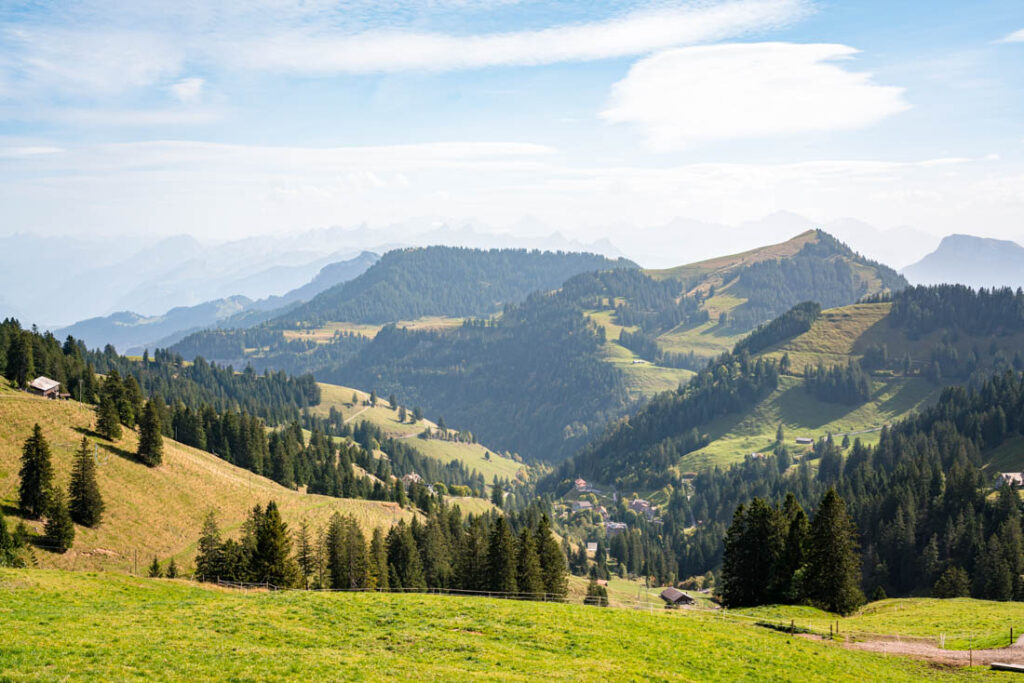
It’s very easy to wax lyrical about a place, but I really do think Switzerland is one of the most beautiful countries in the world.
It just ticks all the boxes for me. The mountains are grand, majestic and powerful; there are emerald and sapphire lakes dotted all around the country; and the little towns and villages with cobblestone streets and ancient cathedrals are as picturesque as they come. It’s one of those rare countries where just being there is an activity in itself. And when the seasons change it becomes a winter wonderland with some of the world’s best skiing.
I’ve recently spent 5 days in Switzerland travelling around the country by train, bus and boat, and I now love the place that little bit more. I even said the classic line: “I could easily up sticks and move here…”
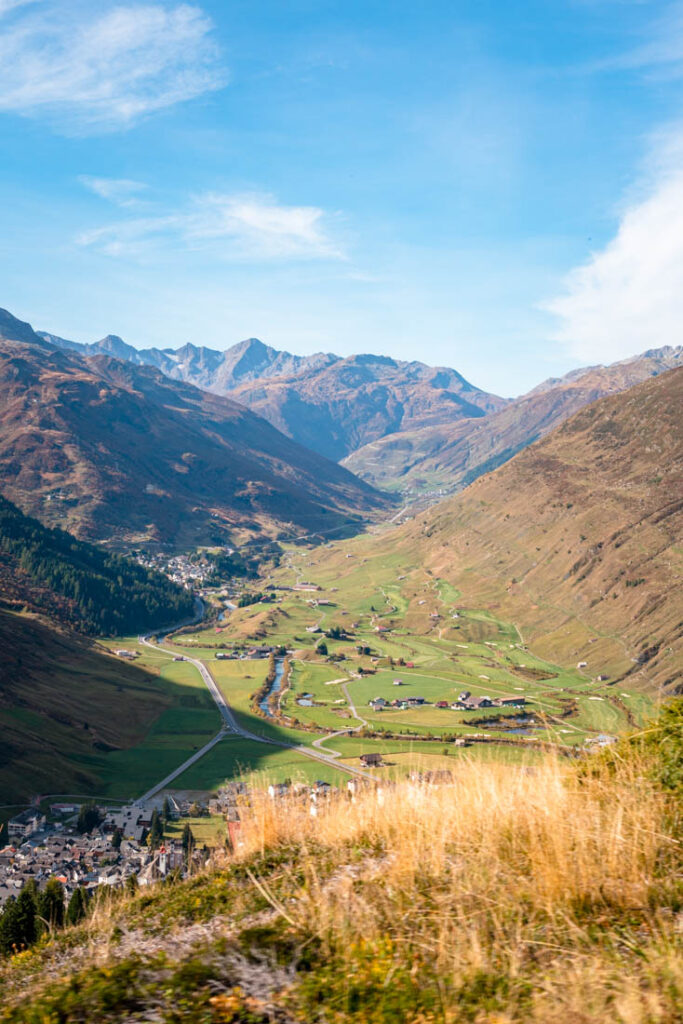
In this blog post I’m going to share my ultimate train itinerary for Switzerland. This is for all you guys who are planning a trip here and want to see the very best of the country.
From starting off in the stunning city of Zurich to seeing the beautiful mountain town of Zermatt, this itinerary is perfect for those of you who like to take things slow and enjoy your surroundings.
I’ll also give you lots of practical tips like how to use your Swiss Travel Pass , what the trains are like, and some of the tops things to do in each place you visit.
I really hope you guys find this Switzerland train itinerary useful for planning your trip here. And as ever, if you have any questions at all you can ask me in the comments below!
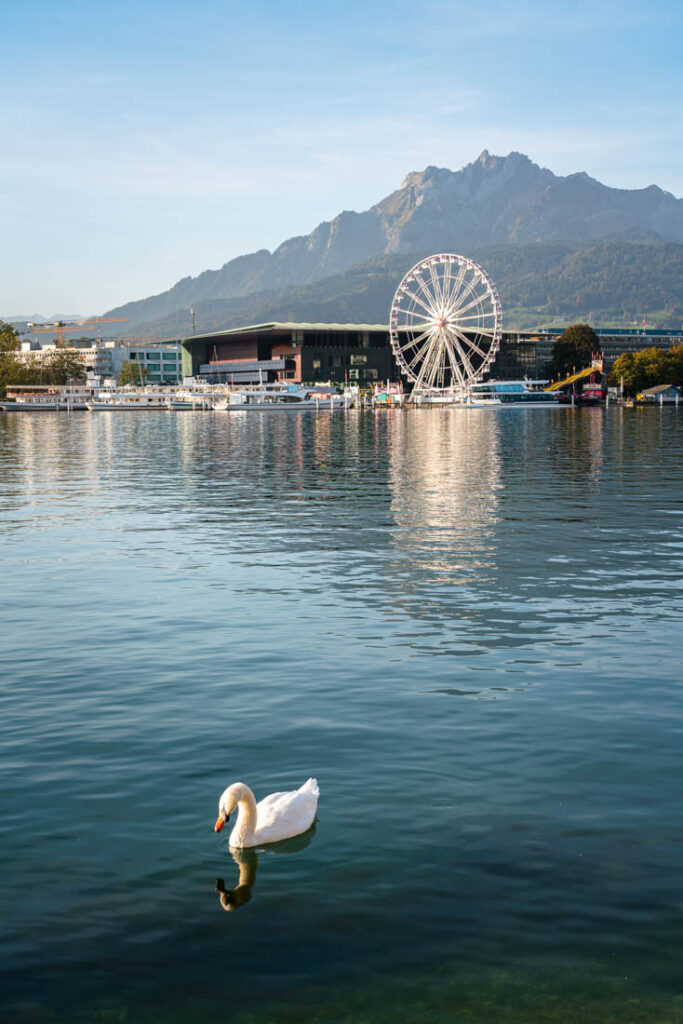
Why visit Switzerland by train, but and boat?
Beauty – You know the cliché “it’s the journey, not the destination…” Well, this rings true for most of the trains in Switzerland. You don’t need to travel far out of the main transport hubs before the views zooming past your window start to get spectacular.
Convenience – When it comes to infrastructure, Switzerland is a leading light in Europe. Everything works meticulously. If a train is one minute late, it is very late. There are rail connections between all major cities and towns. Also, everything is set up so connections between trains, buses and boats are organised so that you don’t lose any time between transfers. Basically, the Swiss Travel System makes it simple and easy travelling throughout the country.
Comfort – Swiss trains are renowned for being super comfortable and clean. Some carriages even have round tables and sofa-like seating making journeys with friends and family very sociable. They also have big panoramic windows, food buffet cars, seat service, and charging points too.
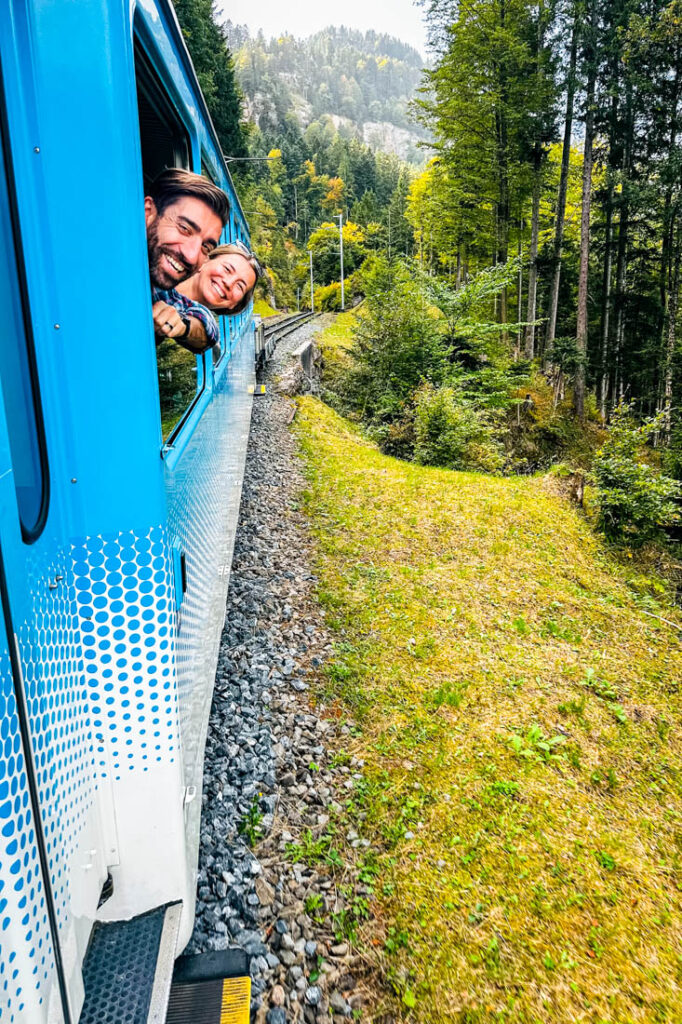
Budget – There’s no getting around the fact that Switzerland is an expensive country. However, the Swiss Travel Pass is an amazing way of travelling around and keeping costs down. It’s actually remarkable value for money.
Sustainability – One of the buzz words in Switzerland at the moment is Swisstainability . They are very proud of being one of the most sustainable countries in the world, and their rail network is a big part of that. Obviously travelling by train in Switzerland is a lot more environmentally friendly compared to other forms of transport.
Scenic travel trains – So there are normal trains that take you from A to B, and then there are scenic travel trains that take you from A to B but via the most beautiful route. These are the trains where you just kick back and watch the world go by.
What is the Swiss Travel Pass?
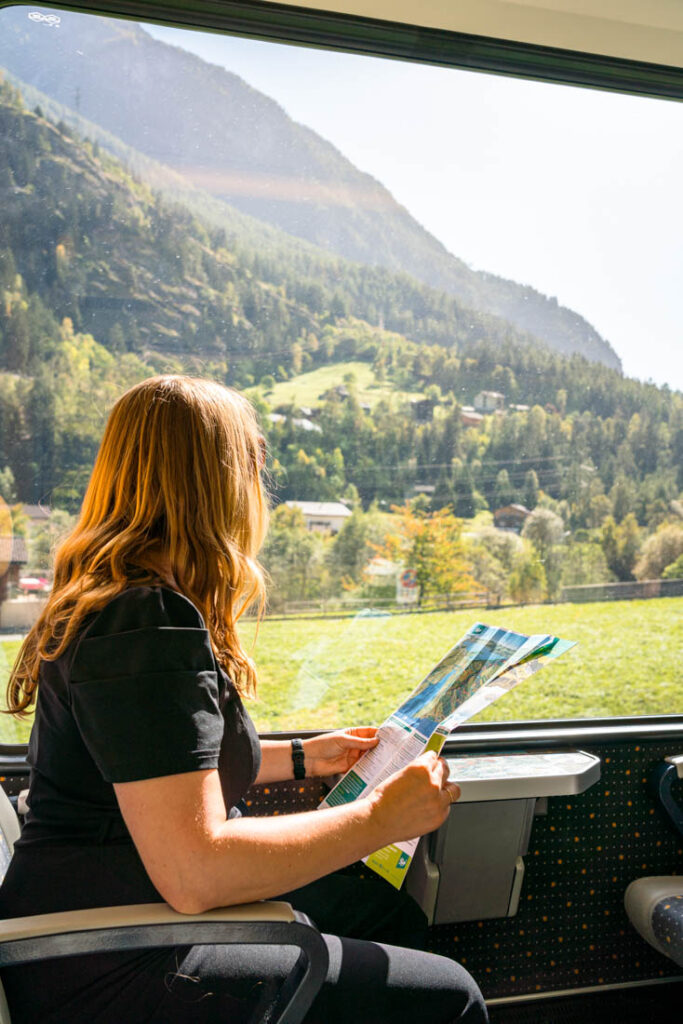
The Swiss Travel Pass is your all-in-one ticket for travelling Switzerland. It’s a bit like your old fashioned InterRail/Eurail ticket. This is where you buy a multi-day ticket, and then you can travel as much as you want within that timeframe. And it really is unlimited travel.
The best thing about the Swiss Travel Pass is it’s not just trains, but also for boats, busses and metros. You even get discounted prices off other modes of transport like mountain gondolas too, so it covers pretty much all transportation in Switzerland.
To highlight that, one day I caught the metro down to the port in Lausanne, then jumped on a boat to Montreux, then caught the train to Zermatt – all on the same ticket. Simples.
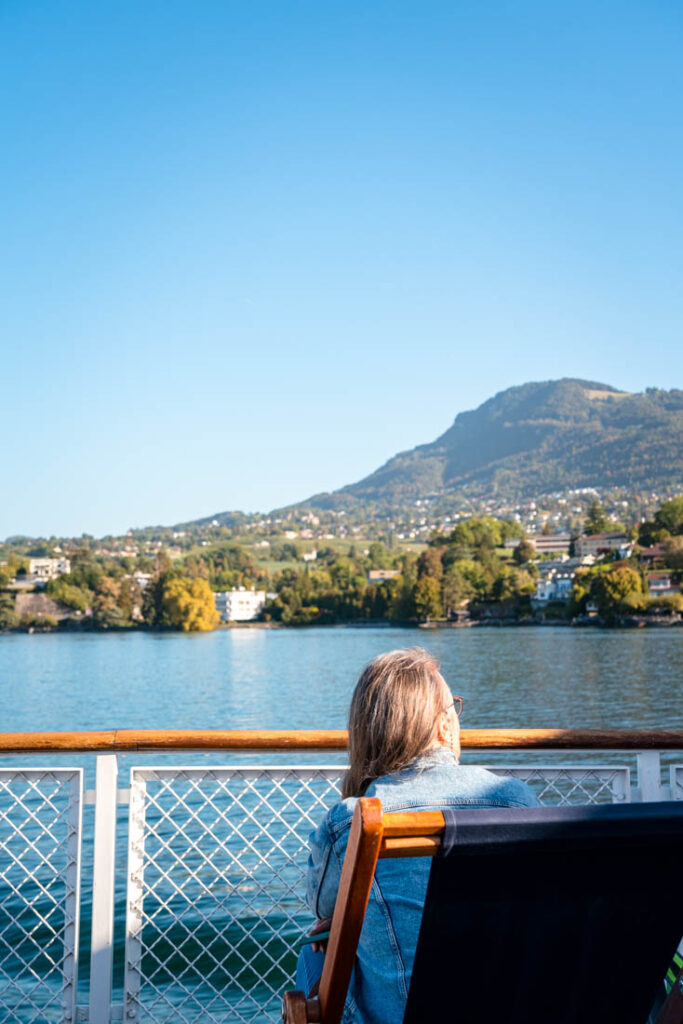
Another benefit of the Swiss Travel Pass is you get free entry into over 500 museums and attractions in the country saving you even more money on your holiday.
One of the things I really liked about the Swiss Travel Pass is it was just one ticket I had on my phone. I didn’t need to queue up multiple times to buy tickets, I could just jump on the train I needed without any trouble. It made things that little bit easier when travelling around the country and save A LOT of time.
How much does the Swiss Travel Pass cost?
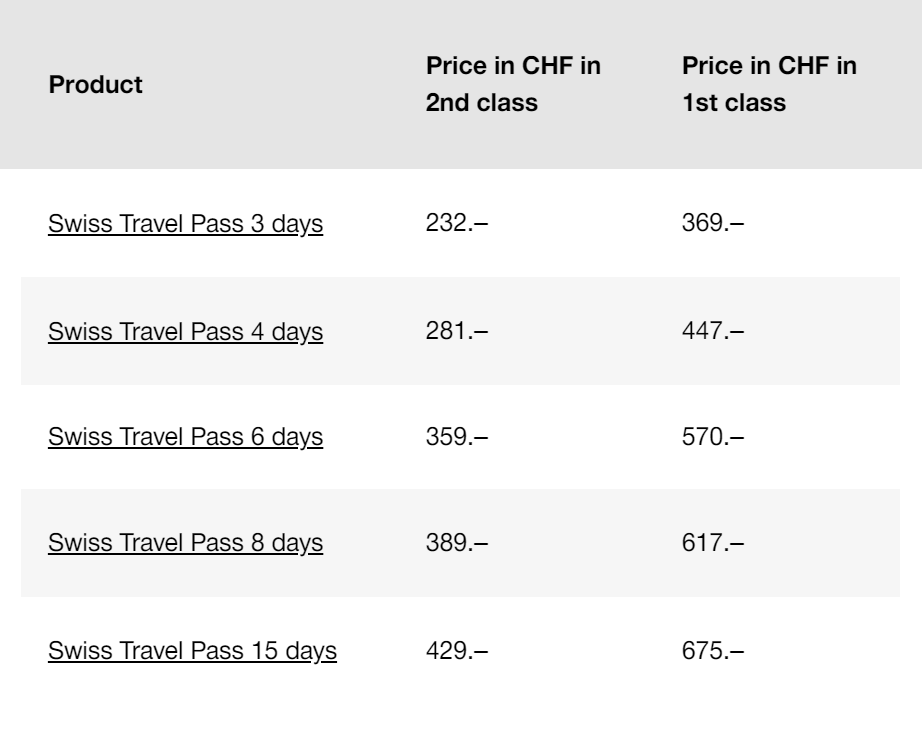
For the Swiss Travel Pass, you can buy a 3,4,6,8 or 15-day ticket. This can either be consecutive or non-consecutive days depending on which pass you buy.
For my Switzerland by train itinerary, I had a 4-day non-consecutive ticket. You could probably do it in 4 consecutive days, but I think it’s well worth spending the day in somewhere like Zermatt (one of my favourite places in Switzerland). I explain all about this below.
With the Swiss Travel Pass Youth, young people up to their 25th birthday travelling through Switzerland benefit from a 30% discount off the regular Swiss Travel Pass ticket fare.
Children from their 6th up to their 16th birthday accompanied by at least one parent (holding a Swiss Travel System ticket) travel free of charge on train, bus, boat and mountain railway with the complimentary Swiss Family Card.
I’ve actually written a huge guide on how to use the Swiss Travel Pass . In this guide I go through the different ticket options, what additional perks of buying a Swiss Travel Pass are, and I go through loads of common questions too. So, if you have anything that’s confusing you about the Swiss Travel Pass, make sure you read my guide
Train itinerary for Switzerland
For this itinerary, I’ve highlighted some of the most popular places to visit in Switzerland.
Some of these trains, like the Lausanne to Zermatt leg, then the scenic train from Zermatt to Chur, are absolutely stunning. As I said, travelling here is an activity in itself, so this itinerary really emphasises that.
I mention it later on in this post, but you could do this itinerary in 4 days and skip the day in Zermatt, but I think it’s well worth spending the day there. It all depends on how much time you have though!
Day 1 – Zurich to Mount Rigi to Lucerne
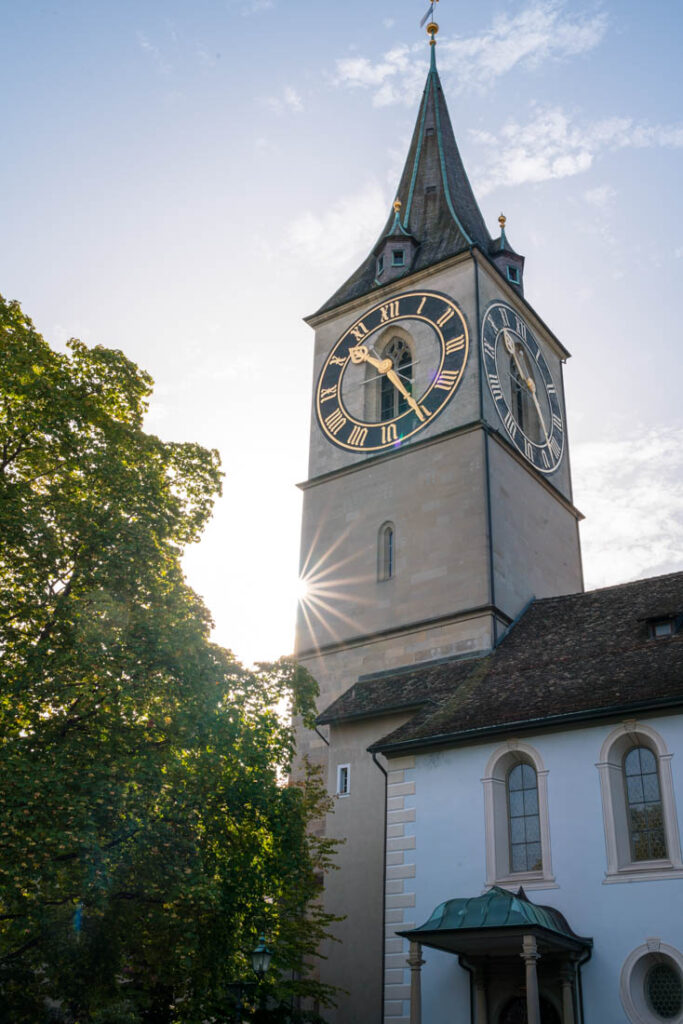
Welcome to Zurich ! This place is so much more than just the financial capital of Switzerland. It is the perfect blend of old-world charm and modern sophistication.
Firstly, the city is stunningly beautiful. The picturesque Old Town (Altstadt) with its medieval architecture, cobblestone streets, and charming squares is like stepping back in time. You can wander through narrow alleys, explore historic churches, and discover hidden gems at every turn.
Now, add a touch of modernity. Zurich is a global financial hub and a city of innovation. The contrast between the medieval and contemporary is fascinating. The sleek and shiny financial district stands in juxtaposition to the historic landmarks.
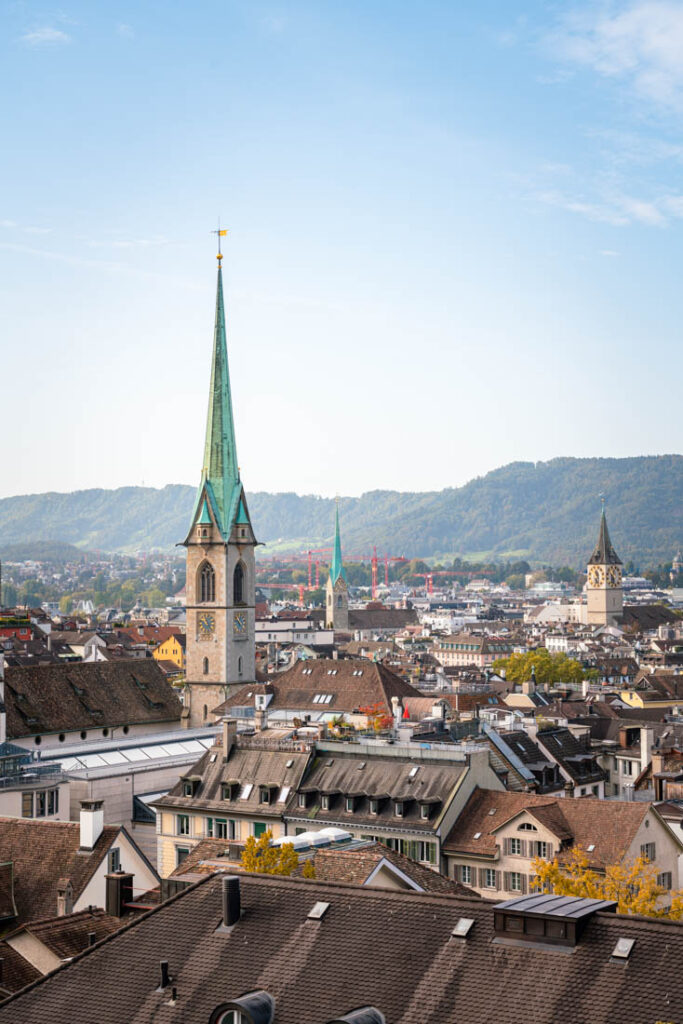
As you guys will know, I am a sucker for a viewpoint. Well, one of the best viewpoints in the city can be found on the university terrace.
Getting here is easy – all you need to do is hop on the UBS Polybahn funicular (which is free with your Swiss Travel Pass) and it’s a short 5-minute ride to the top.
From here, you can see a number of church spires with the mountains in the background. It really is such a stunning view and very close to the Old Town.
Also, if you love your architecture, it’s worth popping into the main university building itself and seeing the atrium. There are so many clean lines here.
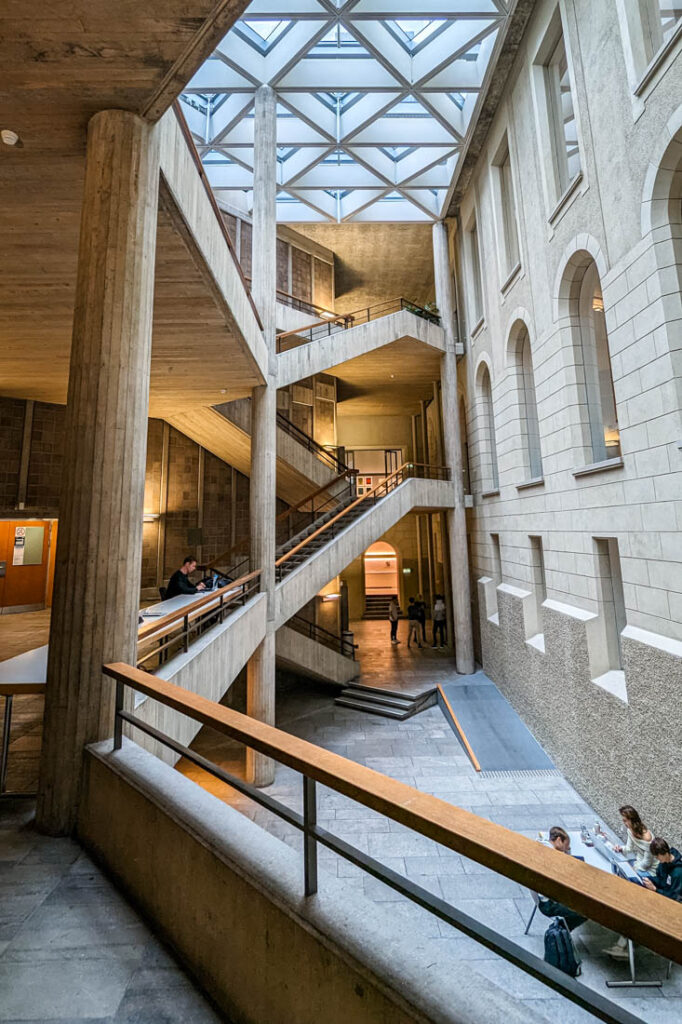
If you’re looking for a good museum to explore then I’d recommend Kunsthaus . The museum has an extensive and impressive collection of artworks spanning from the Middle Ages to contemporary art.
You can find masterpieces by renowned artists such as Alberto Giacometti, Marc Chagall, Vincent van Gogh, Claude Monet, and many more. If you’re an art lover then this place really is a must.
How long you spend in Zurich is completely up to you. You could easily spend the whole day here and head straight to Lucerne (skipping Mount Rigi along the way), or you could explore some of what the city has to offer in a couple of hours.
For me, I spent the morning in Zurich and then hopped on the train to Mount Rigi. You’ll see why below!
Getting to Mount Rigi
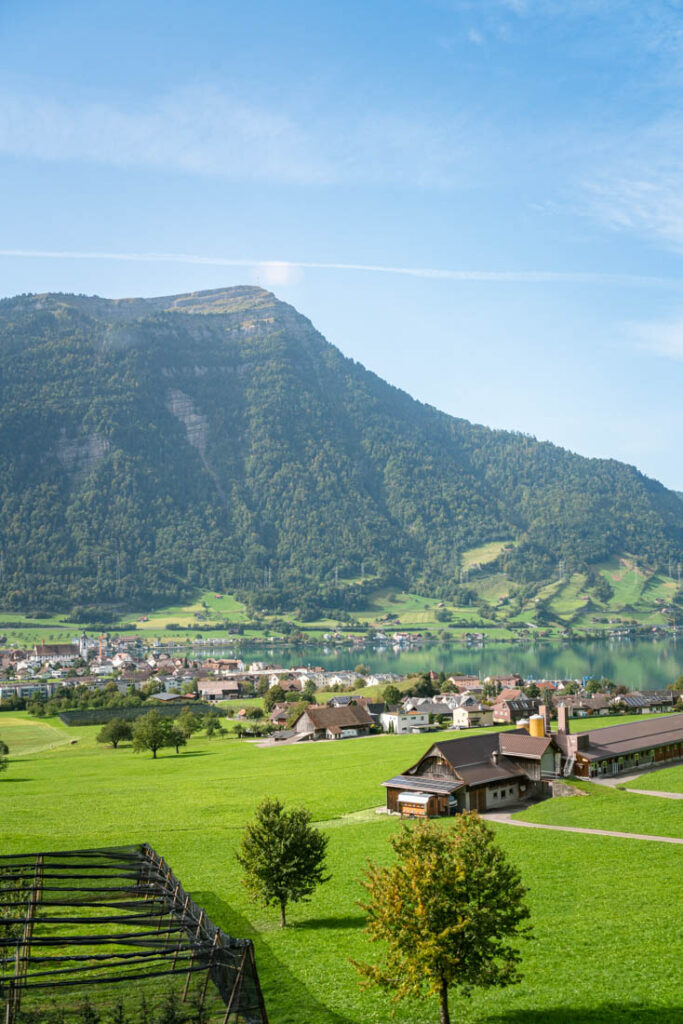
It might seem a bit out the way adding in a stop to Mount Rigi, but I promise you it’s well worth it. Just wait until you see the views at the top of the mountain!
Mount Rigi is known as “Queen of the Mountains”, and even among the Swiss it is considered beautiful.
Getting here is very easy. From Zurich, you need to catch the EC/IC2 train to Arth-Goldau . The train is only 45 minutes but it quickly gives you a taste of what it’s like travelling around Switzerland.
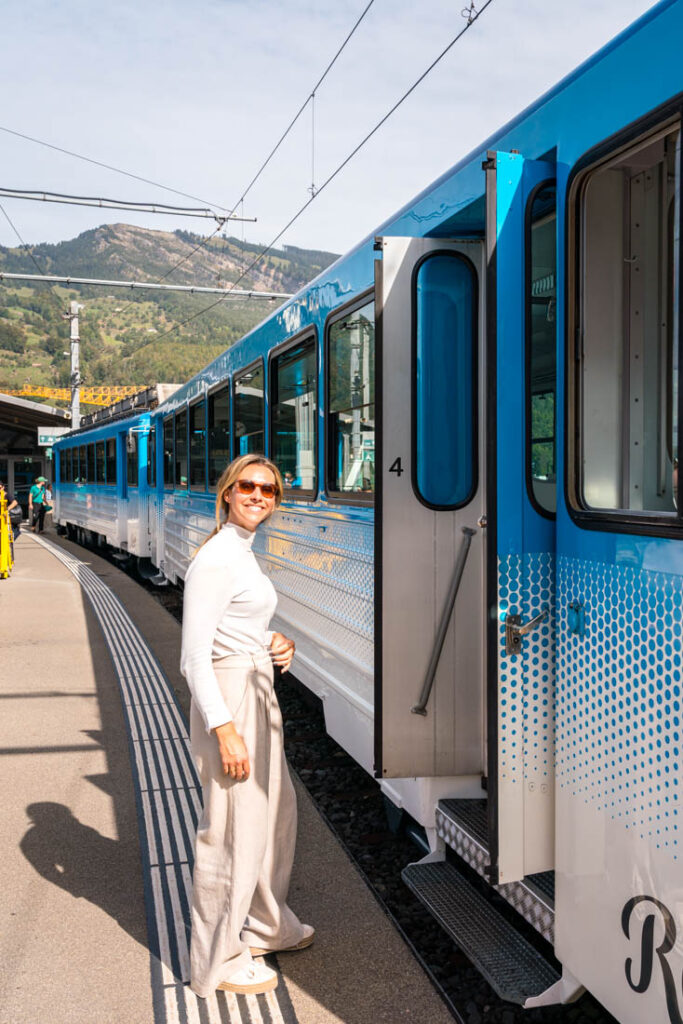
Once you get to Arth-Goldau, you can walk over to the Rigi Bahnen – this is the oldest mountain railway in the world.
Getting to the top is an adventure in itself. The journey is super scenic, and as you ascend, you’ll be treated to increasingly spectacular views.
The summit of Mount Rigi offers breathtaking panoramic views of the surrounding Swiss Alps and Lake Lucerne. It’s a picture-perfect spot that captures the essence of Switzerland’s stunning landscapes.
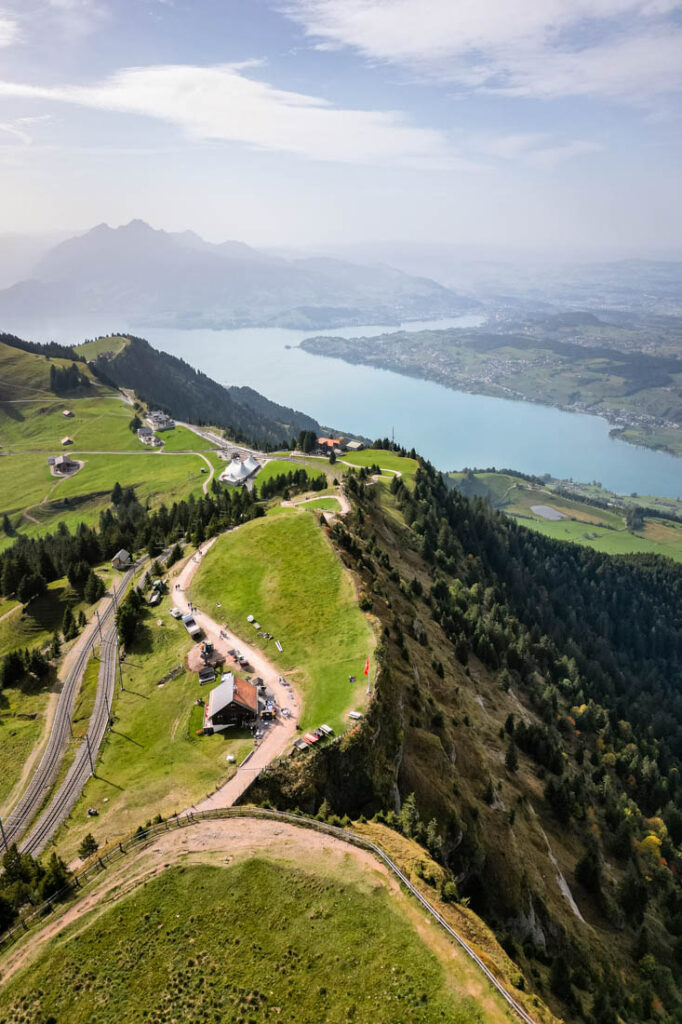
The journey to the top takes around 40 minutes , but I’d recommend getting off the cogwheel train at Rigi Staffel . This is the stop below the final stop (Rigi Kulm).
From here, you can take a leisurely 30-minute hike to the viewpoint itself. It’s quite a steep hike, but it makes the views at the top all the more worthwhile.
Mount Rigi really is one of the top things to do in Switzerland, so I think it’s well worth adding it to your Switzerland train itinerary.
Getting to Lucerne
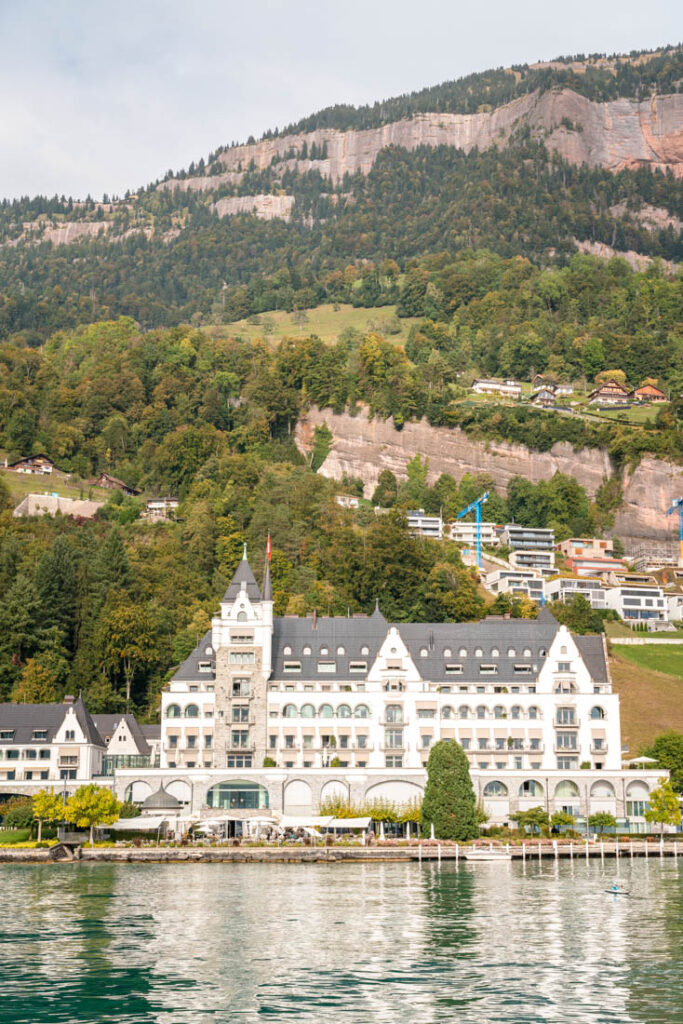
Once you’ve finished at the top of Mount Rigi, you can catch the train down the other side of the mountain down to Vitznau . This train takes 40 minutes .
Once you hop off the train, just walk 50 metres in front of the station and you’ll find a boat waiting for you. This is the boat to Lucerne which takes 1 hour .
It’s journeys like this which highlight how good the Swiss Travel System is. All the boats leave 10 minutes after the trains down from Rigi arrive, so you’re never rushing to transfer from one to the other.
The boat ride itself is soooooo relaxing. I’d recommend grabbing glass of wine and just watching the world go by. This is what travelling in Switzerland is all about after all!
Day 2 – Lucerne to Fribourg to Lausanne
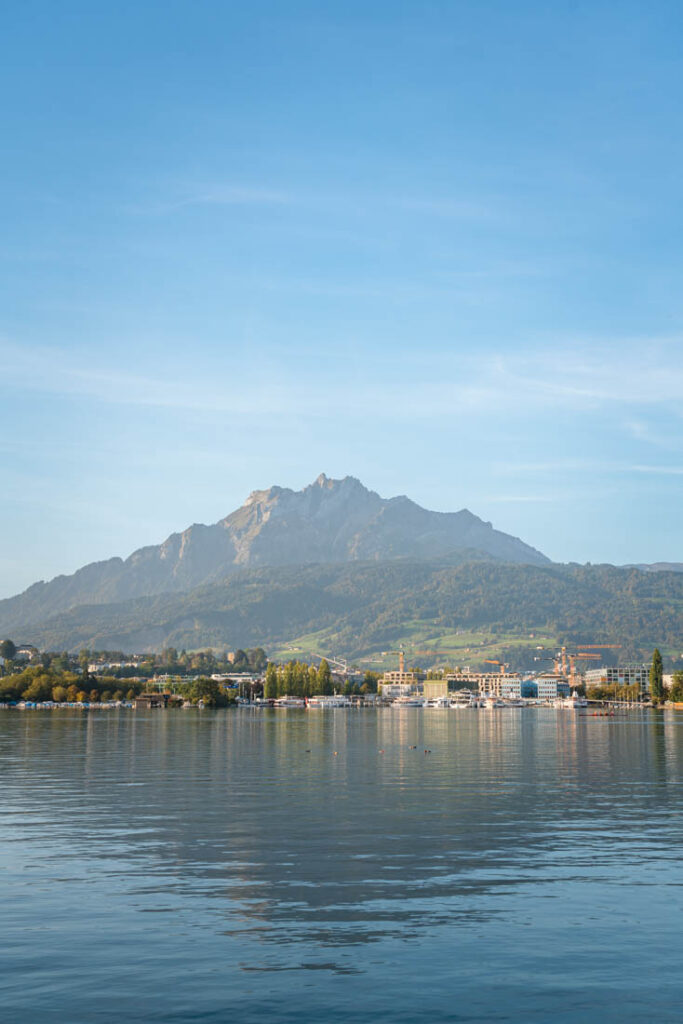
The journey from Lucerne to Lausanne takes around 2 hours and 20 minutes , so it’s not a long journey.
Obviously you can head straight to Lausanne, but I’d recommend breaking up the journey and having lunch in the old medieval town of Fribourg along the way. This is a lovely little place to visit and it’s the birthplace of the cheese fondue. It really is the perfect reason to visit!
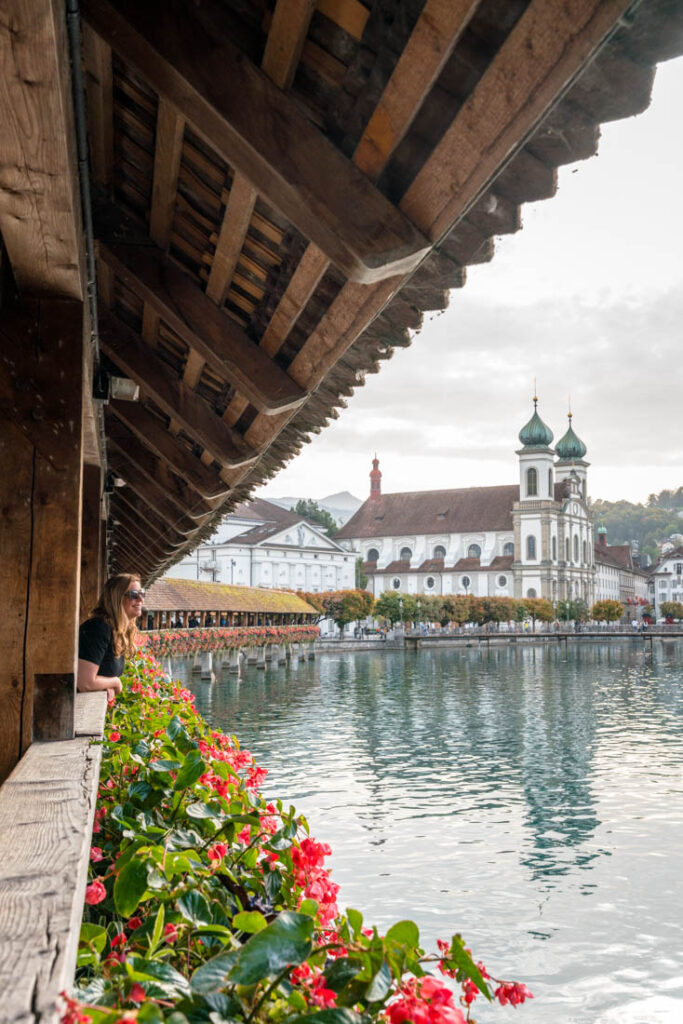
Lucerne is the type of place I could easily imagine myself living. It has such a good vibe when walking around.
To make the most of your time here, I’d recommend getting up early and going for a stroll around Lake Lucerne . From here, you’ll get the best views of “Dragon of the Mountains” (the giant mountain overlooking the city). There is a really nice path that takes you around the lake and only takes about 20 minutes walking towards the train station.
Another site well worth seeing along the way is Chapel Bridge . This is an ornate wooden bridge that dates back to 1365 (it has been subsequentially rebuilt since then!) It is the oldest surviving truss bridge in the world though, and it is one of the top things to do in Lucerne.
Getting to Fribourg
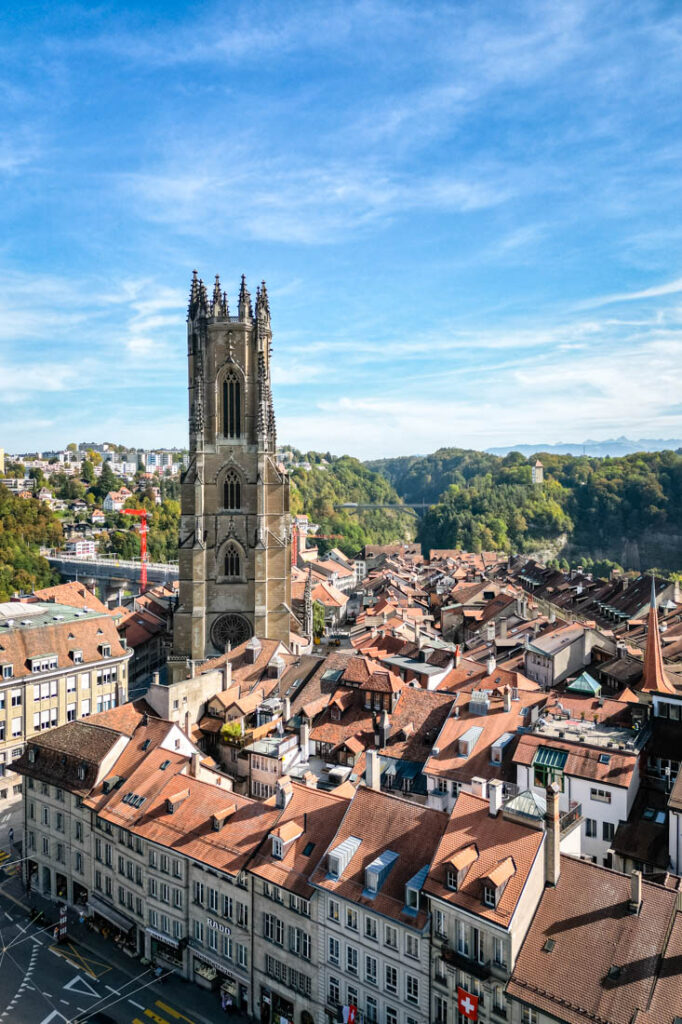
The IR15 train from Lucerne to Fribourg takes 1 hour and 25 minutes .
Fribourg is a very small city, so you can easily walk around here. A lot of people would skip places like Fribourg for their train itinerary for Switzerland, but they are so Swiss I think it’s important to add them in.
A couple of places I’d recommend visiting are Chapelle de Lorette – from here you’ll get the best view of the city. Another place that is a must is Middle Bridge – this is right over the River Sarine and again, the views are stunning.
Another place I’d recommend is St Nicolas Cathedral . This cathedral dates back to 1490 and it looms over the close packed buildings in the city. You can actually climb the 365 steps (one for every day of the year) to the top of the tower for another viewpoint.
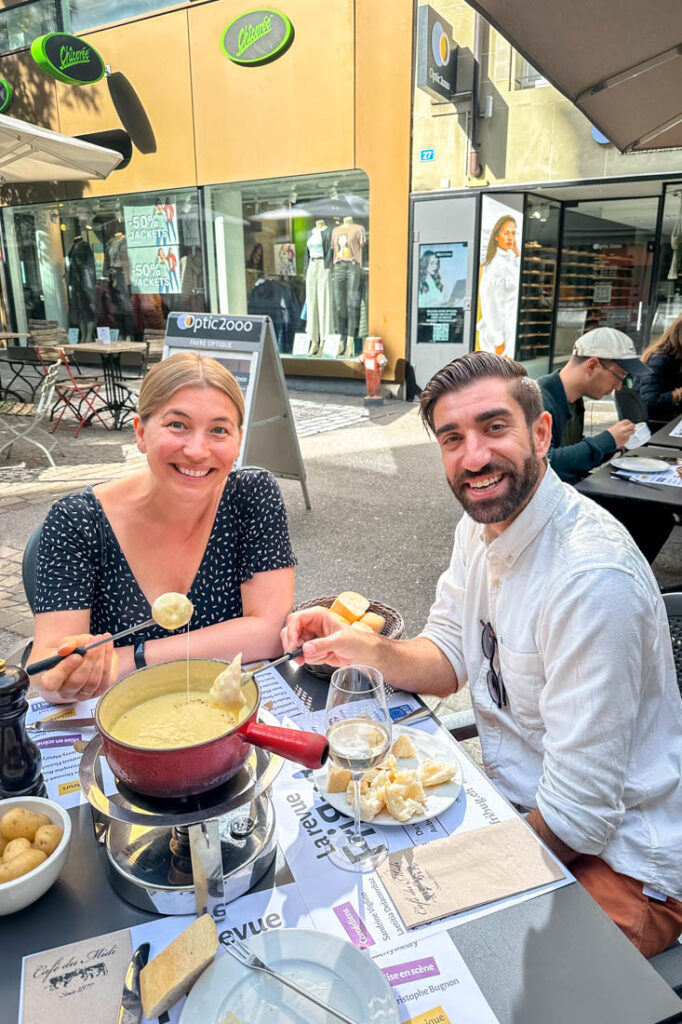
As I’ve already mentioned, Fribourg is the official home of the cheese fondue. I LOVE cheese (I have a proper addiction), so I was very excited to visit Fribourg just for this reason alone.
The local fondue is made from Gruyere and Vacherin giving it a slightly tangier taste. The two places to go for your fondue at Café du Midi (which is where I went), and Café du Gothard .
Don’t you dare worry about the calories – just enjoy the cheesy goodness.
Getting to Lausanne
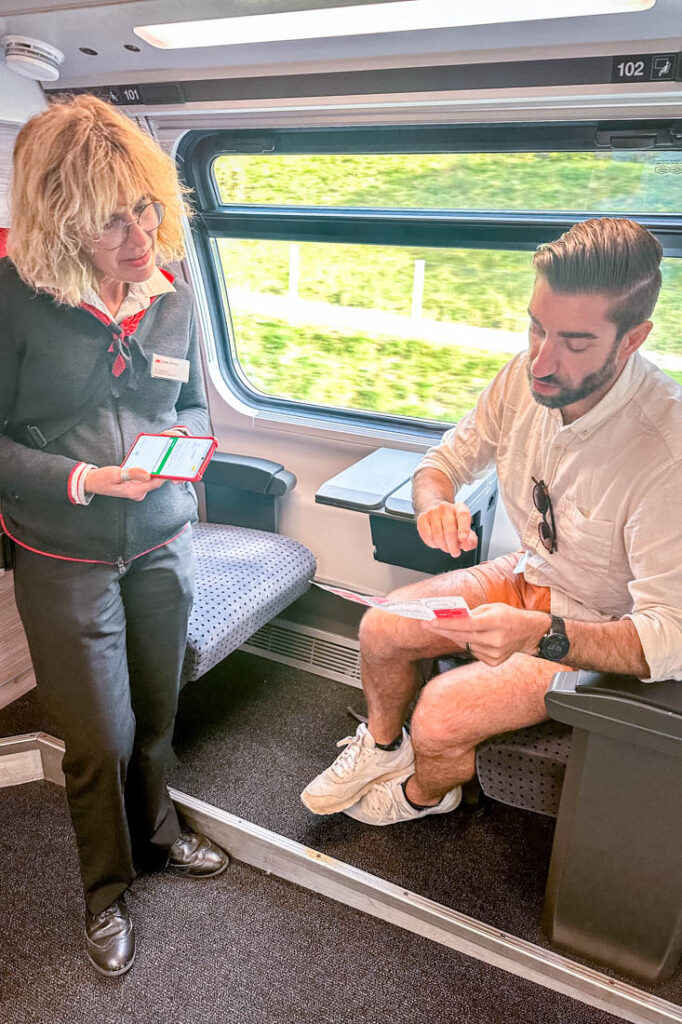
From Fribourg, the IR15/IC1 train takes 50 minutes , so this is a very quick and easy train. This whole train journey is gorgeous, but it goes up another level once you get views of Lake Geneva.
Day 3 – Lausanne to Zermatt
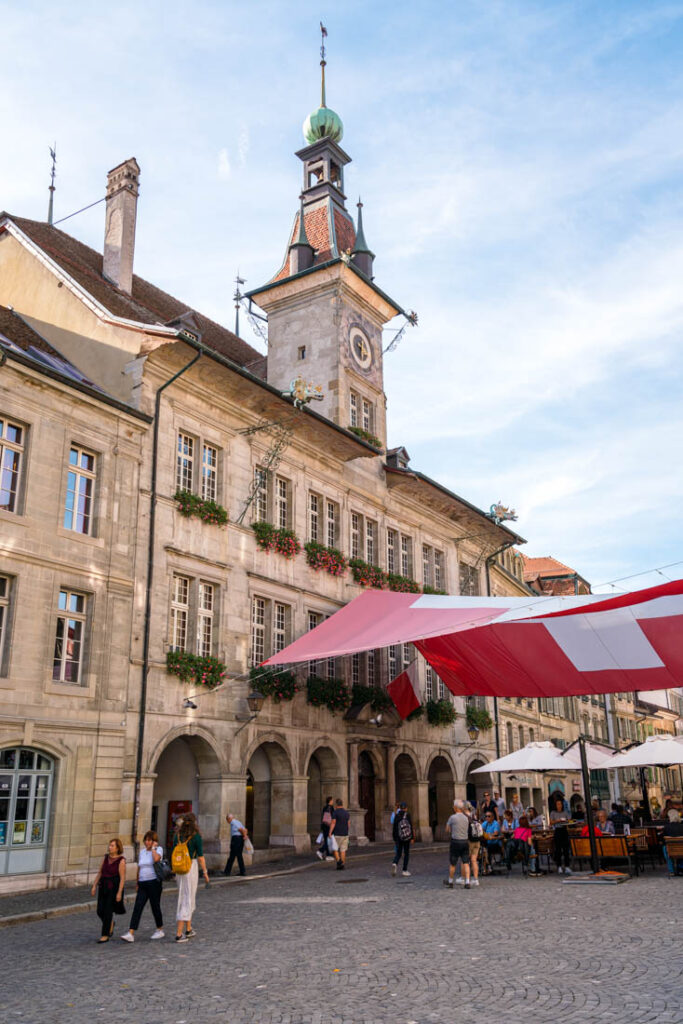
The journey from Lausanne to Zermatt takes around 3 hours and 10 minutes going direct. This journey involves catching the train to Visp, then catching another train to Tasch, before catching a final mountain train to Zermatt.
However, I am going to take you a very different route which involves a boat from Lausanne. Personally, this was one of my favourite activities I did in Switzerland, so I can’t recommend it enough.
No matter which route you take, you have to change at Visp and Tasch anyway, but it’s literally just getting off one train and getting on another.
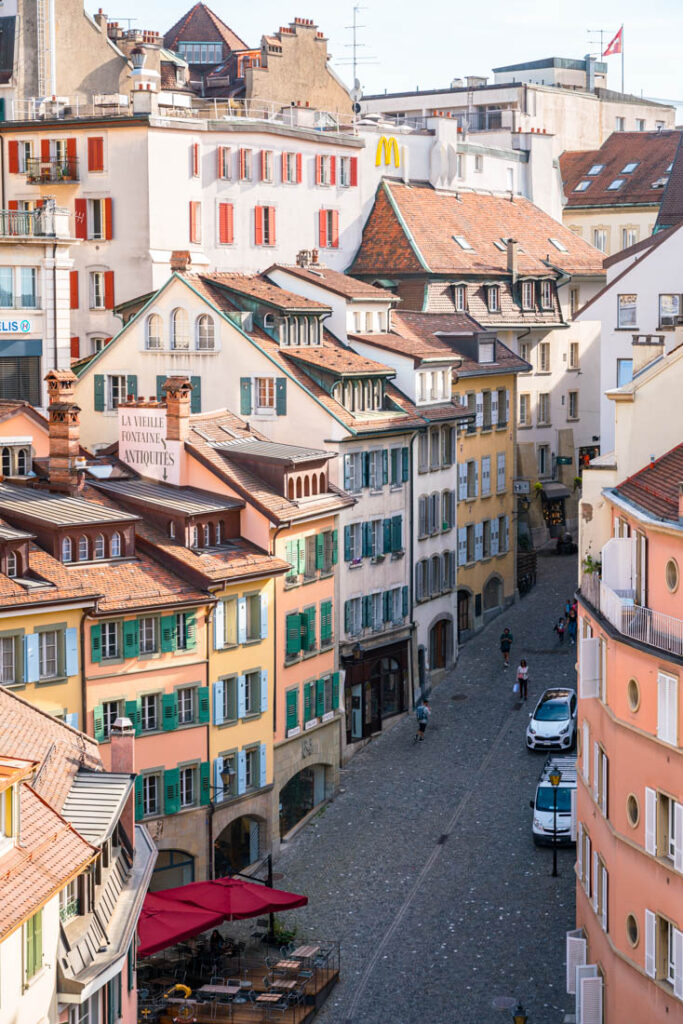
Lausanne is a wonderful place to spend a few hours wandering around the cobblestone streets. Almost on every other corner is an independent chocolatier or a fromagerie selling Swiss cheese.
One of the top things to do in Lausanne is visit Lausanne Cathedral . This is a beautiful church at the top of a hill overlooking the city. The main hall has these ornate high-vaulted ceilings – it actually reminded me a lot of the famous Notre-Dame Cathedral in Montreal .
If you want some of the best views of Lausanne then head to the top of the cathedral. Here you get 360-degree views of the city with Lake Geneva and the mountains in the background.
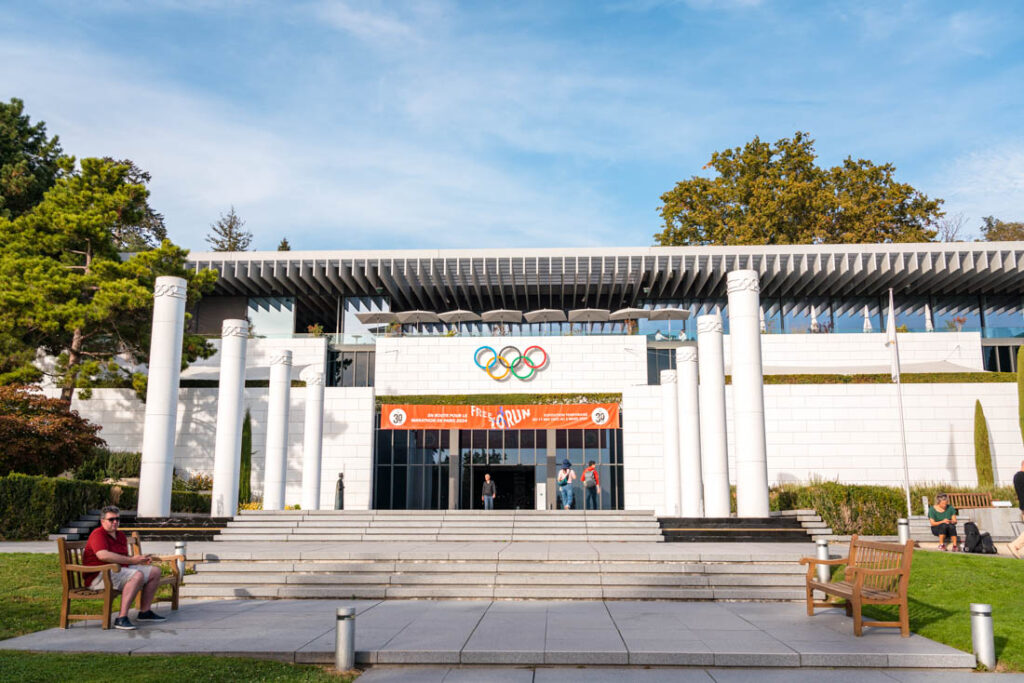
Another place that’s well worth visiting is the Olympic Museum . Pierre de Coubertin, the founder of the Olympic Games, brought the International Olympic Committee to Lausanne in 1915, and it’s still here today.
This is a very interactive museum which highlights the triumphs of the Olympic Games and its storied history. The café-restaurant also offers fantastic views of the lake.
Getting to Montreux
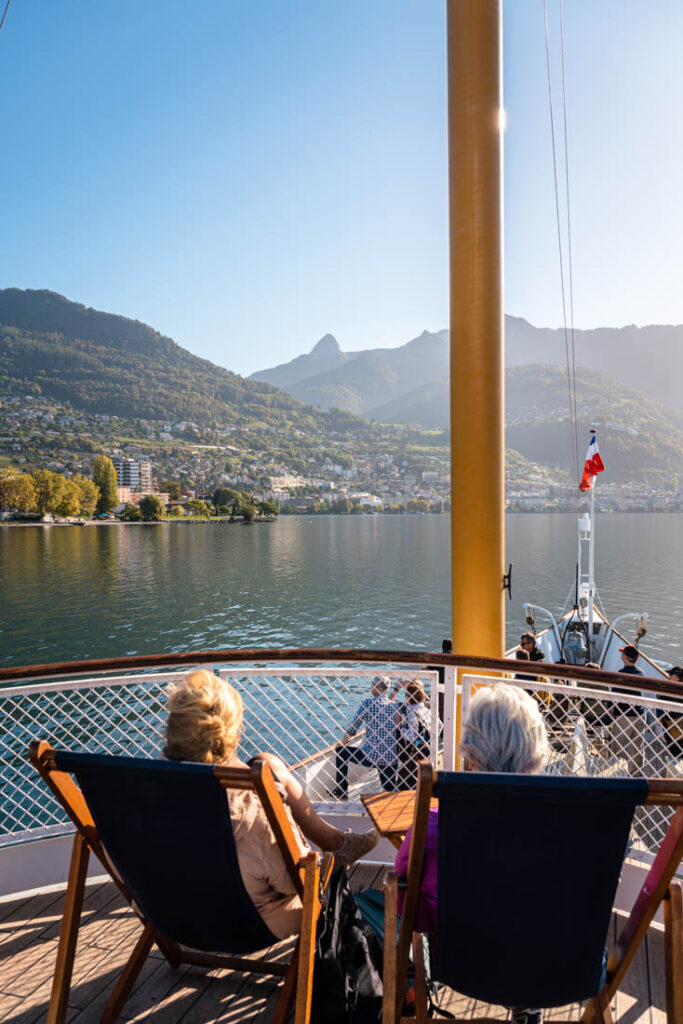
Okay, so now I’m going to take you on a different part of the Swiss Travel System.
Opposite the metro stop Lausanne-Ouchy you’ll find the boat terminal for Lausanne. From here you can catch a boat from Lausanne to Montreux which takes 1 hour and 20 mins .
This boat leaves at 11:00 in the morning during summer, and then there is a later boat too. Make sure you check the timings on the SBB website though to be sure.
The best thing about this boat trip is it’s included in your Swiss Travel Pass so you can just stroll onto the boat. And what a boat it is!
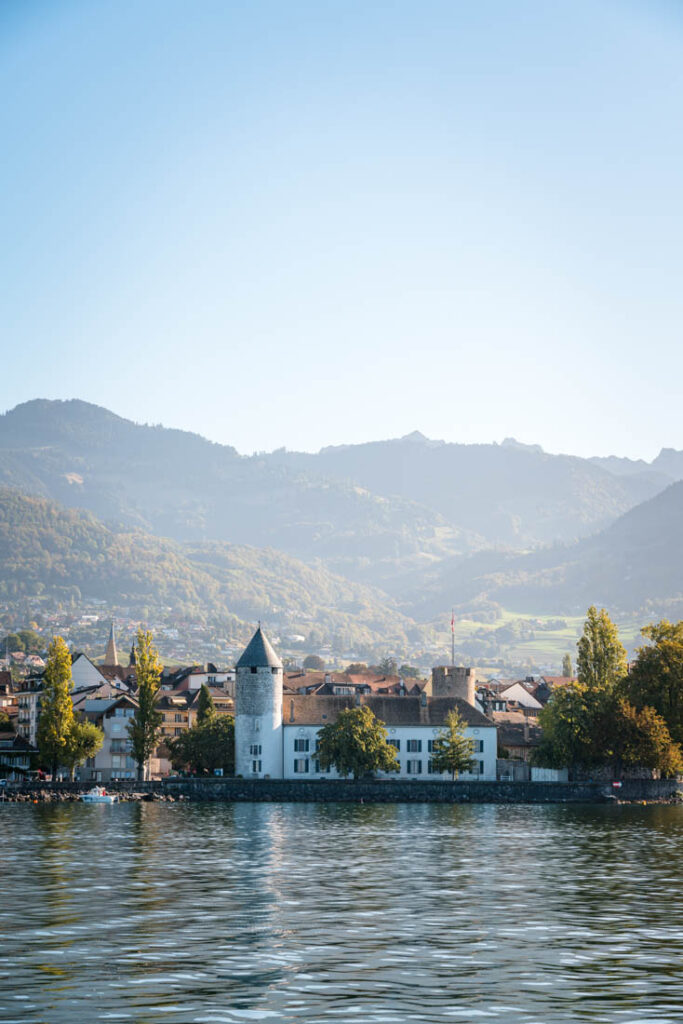
It’s an old-fashioned steam paddleboat like harks back to the days of the Titanic. You can even see the open engine and waterwheels chugging along.
Honestly, I can’t tell you how beautiful this journey is along Lake Geneva. Just seeing tiny towns and the mountains roll by is something else. Also, there are a number of deck chairs on the boat – just perfect for watching the world go by!
Getting to Zermatt
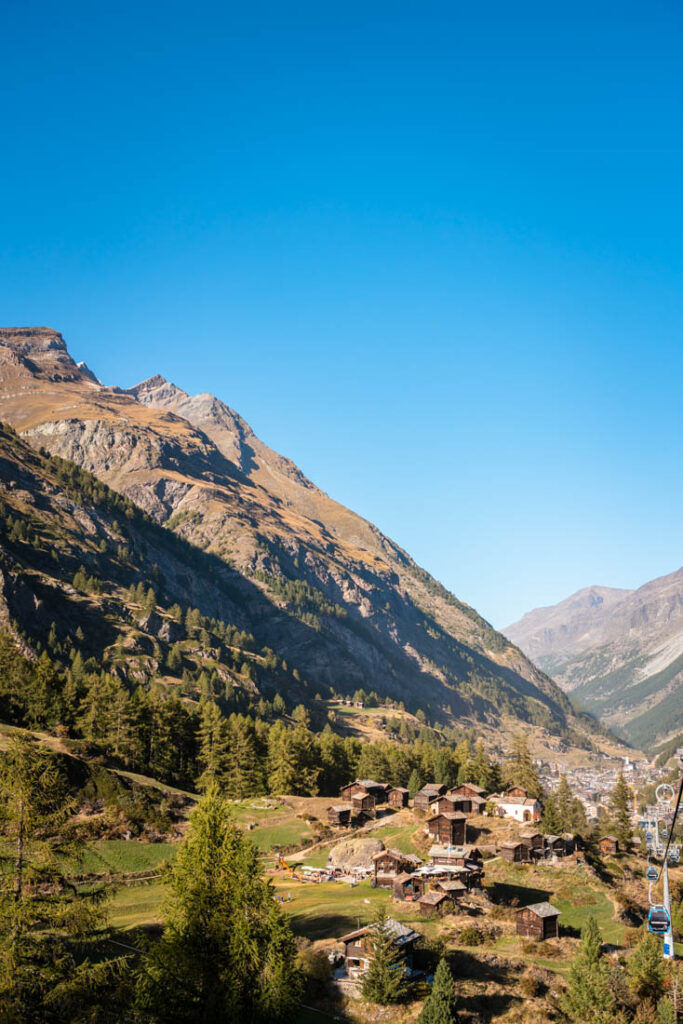
From Montreux, you can catch the IR90 to Visp which takes 1 hour and 10 mins . From here, you need to change trains to Zermatt which takes another hour .
I know I keep banging on about all these gorgeous views, but the train from Visp to Zermatt is another stunning journey. This train trip takes you past mountain villages, and as you get closer and closer to the Alps the landscapes become more and more dramatic. Eventually you’re treated to a view of the Matterhorn itself. Wow.
Day 4 – Zermatt
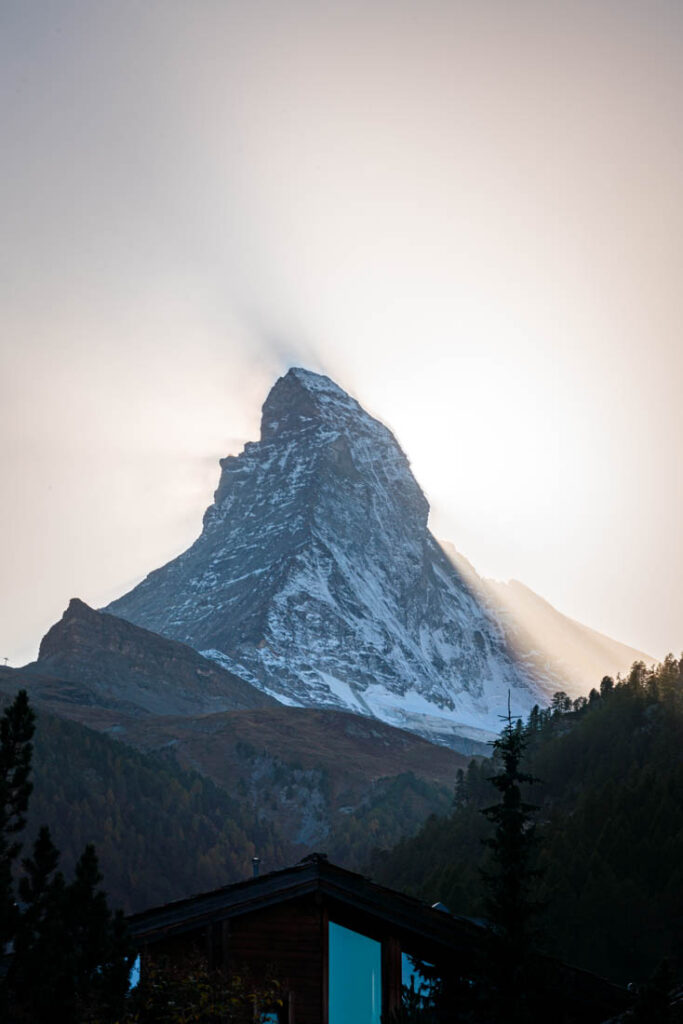
If you wanted a shorter train itinerary for Switzerland, you could skip this day and catch the Glacier Express directly to Chur. This would mean you’d only need a 4-day Swiss Travel Pass and you can shorten the itinerary by a day. However, I really think it’s worth spending the whole day in Zermatt.
To get around the fact that you’d be wasting a day of your Swiss Travel Pass not travelling, you can actually buy a flexible ticket where you can travel for 4 nominated days as opposed to consecutive days. This way it means you can spend a day in Zermatt without losing a day on your ticket. It’s a little confusing but I explain it all in my guide on how to use the Swiss Travel Pass .
The reason why I think you should spend the whole day in Zermatt is because I think it’s one of the most beautiful places to visit in Switzerland. Walking around here feels like you’re on a film set or in a fairy-tale; it’s just so magical.
It also means you get to go on the Gornergrat railway too, something that shouldn’t be missed.
Even though this train isn’t included in your Swiss Travel Pass, you do get 50% off. And once again, I promise you it’s well worth it!
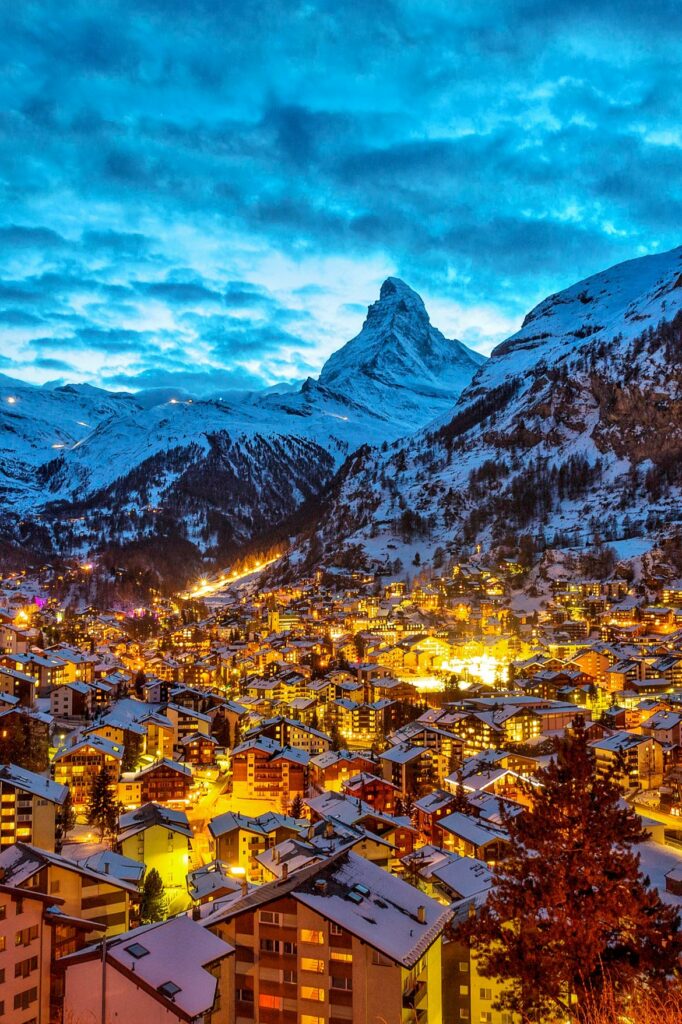
I would say the Gornergrat is one of the most beautiful train rides in the world with these spectacular views of the Matterhorn as you go up.
The Gornergrat train leaves Zermatt at 1,600m and takes you all the way up to the Gornergrat peak at 3,100m. The journey takes around 33 minutes so the best thing to do is bag yourself a window seat and enjoy the views.
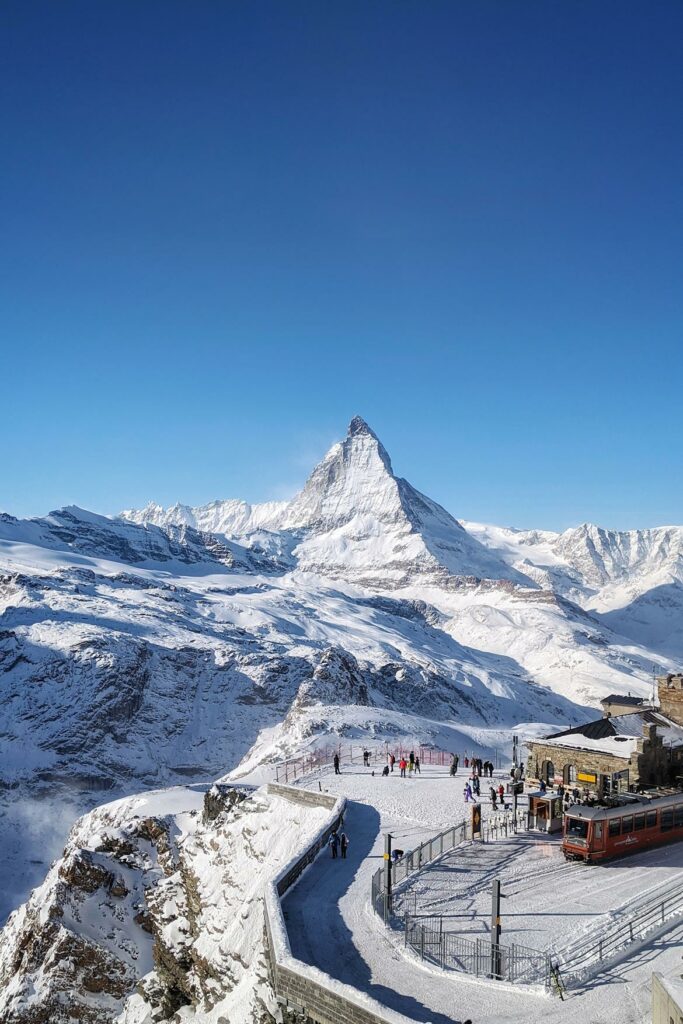
At the top you have some amazing panoramas of the mountains including the Matterhorn. There’s also a hotel which you can stay in (which is Europe’s highest hotel) and a restaurant up here too.
My top tip is if you want to beat the crowds then head up on one of the first trains around 8am. Then you’ll have the top of the mountain pretty much to yourself. There’s a reason why this is one of the best things to do in Zermatt!
You can book your tickets for the Gornergrat train here .
If you’re travelling in winter, then here is my guide all about learning to ski in Zermatt . Still one of the best places I’ve ever been skiing!
Day 5 – Zermatt to Chur on the Glacier Express
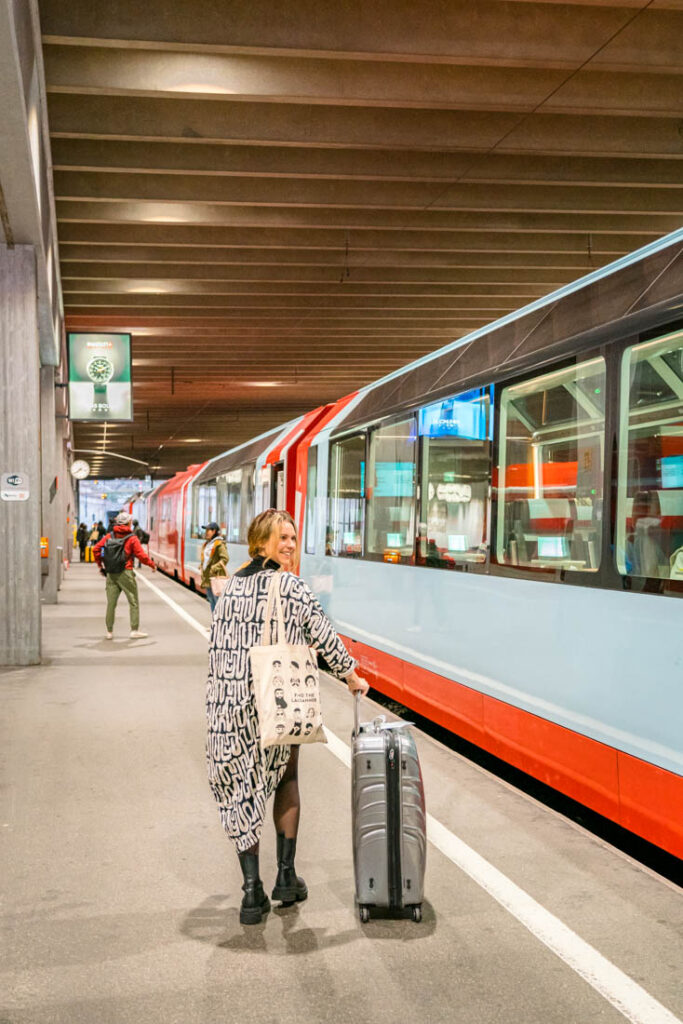
I don’t want to say I’ve left the best till last, but if you love train journeys then the Glacier Express has to be on your bucket list.
This is one of the panoramic scenic trains where you just kick back and enjoy the ride. The whole point of this train trip is to look out the window and enjoy the views – nothing more.
The train leaves at 07:52 during summer and 08:52 during winter, and takes around 7 hours 30 minutes . It’s often referred to as “the slowest express train in the world”. It only travels 290 kilometres in that time but the views gradually get better and better with each passing hour.
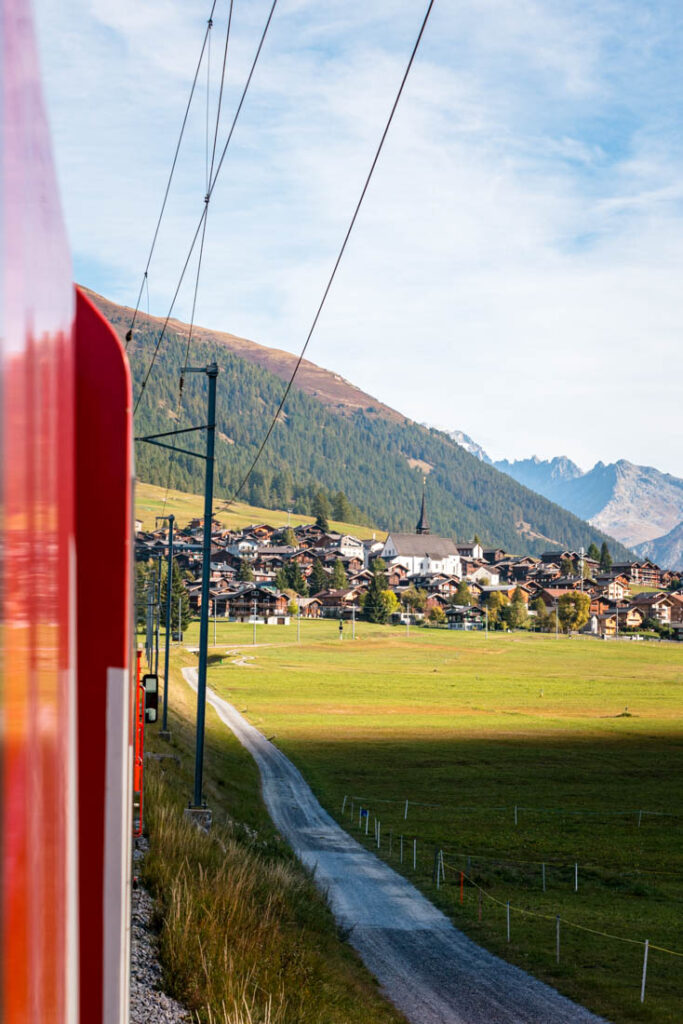
No train trip like this would be complete without a good meal. Well, the Glacier Express provides a culinary experience like no other. Tables are elegantly set, and the panoramic windows provide stunning views while you eat.
The menu often includes a selection of Swiss dishes local to the region. For our lunch we had beef stroganoff and it was absolutely delicious. You can also pair this with a Swiss wine or a little digestif while you’re rolling along too.
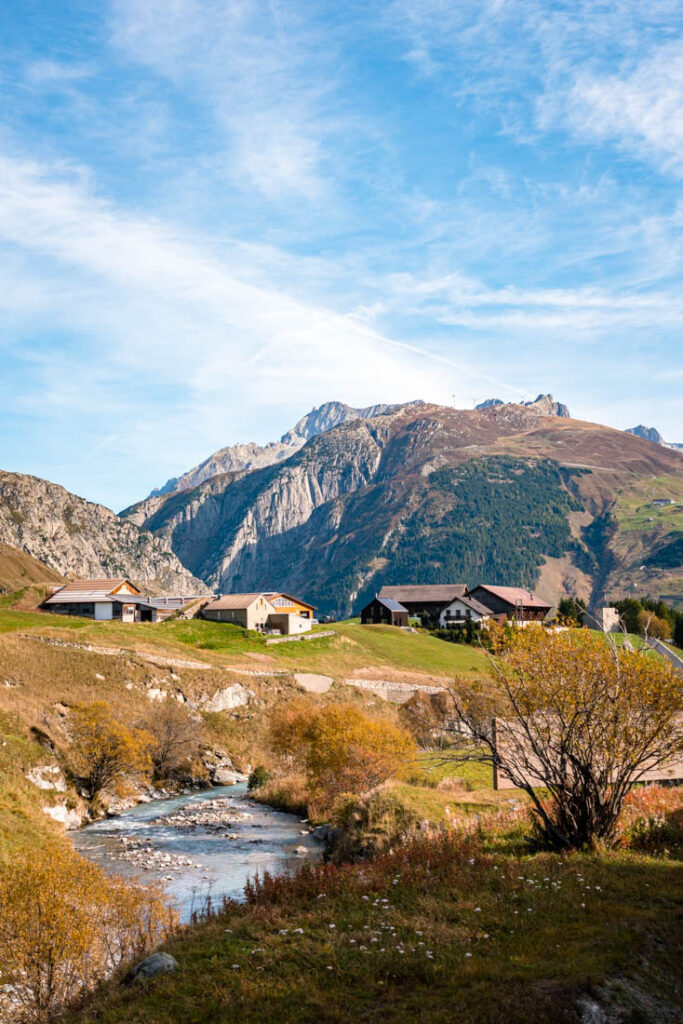
One thing not everyone knows about the Glacier Express is you can freely move through the carriages. Why would you want to? Well, in the food coach where you can grab a coffee, they have panoramic windows which you can open.
I can’t tell you how amazing this is for photography. No glares from the lights, no weird colours – just uninterrupted views. I love taking photos so it really made a difference to my journey having this.
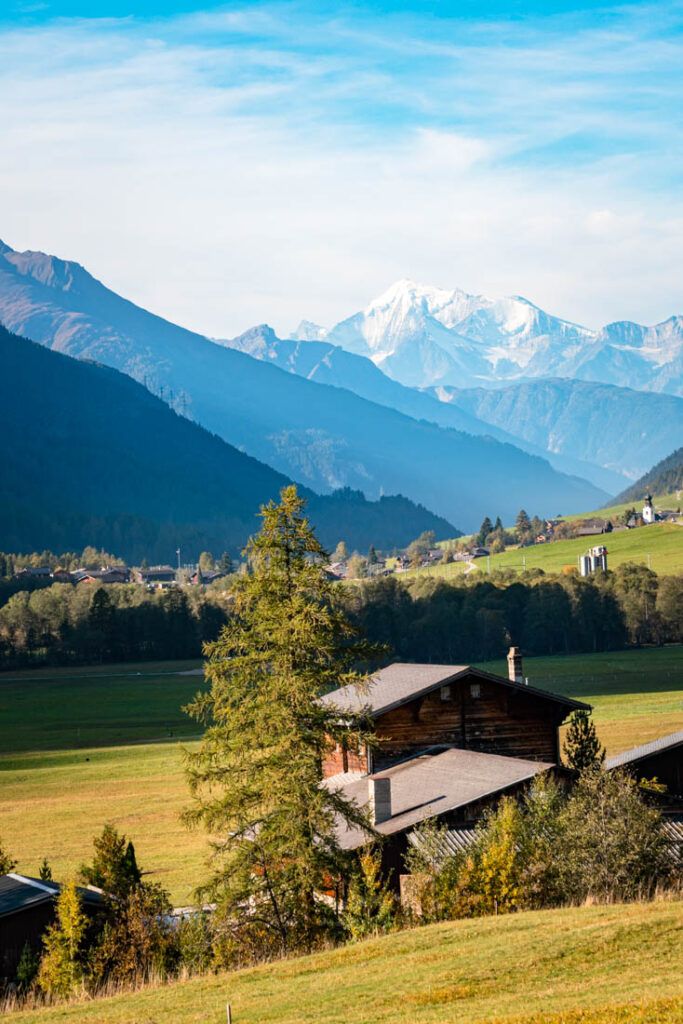
This train gets into Chur at around 13:52 in summer or 14:52 in winter. From here, you can either stay in Chur and carry on your Swiss adventure, or head back to Zurich.
Unfortunately this was the final stop on our rail itinerary for Switzerland, but 5 days was the perfect amount of time for travelling around the country.
I really hope you found my Swiss train itinerary useful for planning a trip here. As you can tell from my photos, this is such a stunning country to travel around. And doing it by train, bus and boat is just the perfect way of seeing the country.
If you have any questions about my itinerary, just let me know in the comments below. Otherwise, happy travelling!
This post was in association with My Switzerland and the Swiss Travel System showcasing some of the best things to do in Switzerland. As always, all views and opinions are my own.
If you’d prefer to drive, then check out my post on the perfect road trip in Switzerland . This was such an amazing road trip!
Like this blog post? then Pin it for the future!
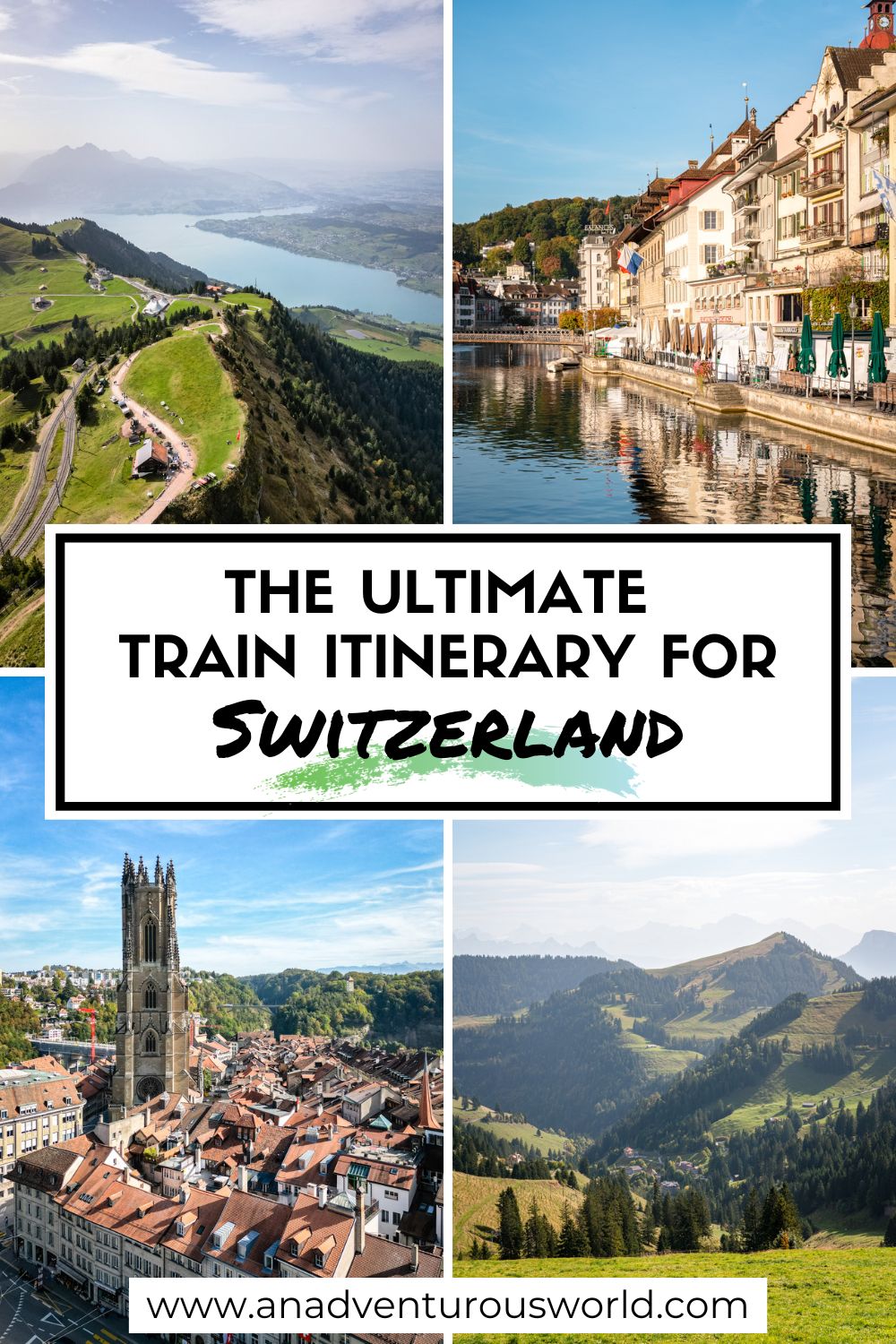
About the Author

Macca Sherifi is the founder of the multiple award-winning blogs An Adventurous World and the Great British Bucket List. Every month he inspires over 200,000 avid readers to travel the world.
View all posts
2 thoughts on “The Ultimate Train Itinerary for Switzerland”
Hi. First I would like to thank you for writing this blog. My family and I are planning to go to Switzerland this year. We are planning to visit as much places as we can on our 8-days trip. I am planning to get the Swiss travel pass, but I am confused with the family pass. There will be four of us (me, my husband, my 18 year-old son and my 12-year-old daughter). Does that mean I have to buy a family pass for just the three of us and a separate one for my son? And also with the consecutive days on the travel pass, does that mean have travel consecutive straight days? I have already booked 1 day tour to Top of Europe which will be around the 3rd day of our stay in Switzerland. Does that mean that the travel pass will become invalid since we wont be using it for 1 day? I really would love to hear from you and your feedback on my questions below.
Thank you and all the best on your next travel blog.
Regards, Verna Barcena
Thanks for commenting Verna. Firstly, have you read this blog post – https://www.anadventurousworld.com/how-to-use-the-swiss-travel-pass/ . That should cover a lot of questions you have. In it, I state that you can buy a flexible travel pass – this is where you can have a non-travel day in the middle of your Swiss Travel Pass which is exactly what you want to do. And yes, I think you’ll have to buy a separate pass for your son. Let me know if that helps or if you have any other questions at all!
Leave a comment Cancel reply
Rail travel in Switzerland

- 1.1 Ticket validity
- 1.2 Deductions
- 1.3 Travel cards
- 1.4 Reservation and "Tourist trains"
- 1.5 Buy the tickets before you board
- 2.1 Schedules
- 2.2 Train composition
- 2.3 Luggage
- 2.4 Types of trains
- 2.5 Bicycle
- 3 International connections
- 4 Information for railway enthusiasts
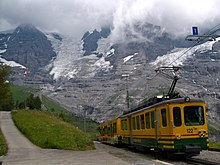
Switzerland will spoil you with a fantastic transport system - swift and disturbingly punctual trains, clean buses, and half a dozen different kinds of mountain transport systems, all integrated into a coherent system. The discount options and variety of tickets can be bewildering, from Half Fare Cards to multi-day, multi-use tickets good for buses, boats, trains, and even bike rentals. In general, there's at least one train or bus per hour on every route. On many routes there are trains and buses running every 30 or even 15 minutes, with city transit services running every 5-7 minutes during rush hours. However, as with everything in Switzerland the transit runs less often, or at least for a shorter period of the day during weekends, and particularly on Sundays and public holidays and in less densely inhabited areas.
Information, routes, fares, policies and schedules for almost all public transport can be found online on the Swiss Federal Railways' ( SBB CFF FFS ) website which is a must-use resource for any traveller to Switzerland. Information can also been found on posters and screens at any stop, or from a ticket window at any railway station. The nation-wide coherently integrated timetable is also available as a free smart phone app [dead link] . At any railway station of any provider you can get information and tickets (at manned ticket counters) for any of the many members of the integrated railways network of Switzerland and most bus systems, in particular PostBus Switzerland (de: PostAuto, fr: CarPostale, it: AutoPostale) which provides an online timetable as well with the same data.
Bus and trains do not and are not allowed under law to compete each other in Switzerland, rather - quite the opposite, they are complementary to each other – besides being coordinated timetable-wise. That way, almost all inhabited villages and towns in Switzerland can be reached by public transport. This is actually constitutionally demanded by the Public Service regulations of the Swiss Confederation. Public Service is a unique Swiss term loosely referring to all kinds of laws, acts, and ordinances, which define the basic supply of public services and infrastructure in particular concerning postal services, telecommunication, electronic media, public transport and road infrastructure.
There are about 20 regional fare networks throughout the country, which incorporate many kinds of public transport (city bus, tram, metro, any kind of train, PostBus, boats, funiculars and others) by many different providers around urban centers into one single fare system , such as ZVV in the canton of Zurich, unireso (see also: Geneva's tpg ) in the canton of Geneva and its French adjacent area, or mobilis around Lausanne in the canton of Vaud at the northern shore of Lake Geneva, passepartout in the cantons of Lucerne, Nid- and Obwalden (keyword: Titlis ). Usually these networks sell zone-based tickets valid for a particular time frame (instead of point-to-point tickets) for journeys within their fare network borders. Many of these networks and transit operators provide their own free smartphone apps; sometimes to be found on the major city's transit company website.
Even if there is no train or city transit available, the comprehensive PostBus Switzerland network gets you there. Where applicable, PostBus Switzerland is part of regional fare networks. You find all timetable information on Swiss Federal Railways' (SBB CFF FFS) online timetable, but PostBus Switzerland also provides their own free app with the same information as by SBB as well as many additional features.
Further information about the railway network in Switzerland [dead link] and the Switzerland-wide countryside bus network [dead link] is also available online.
Tickets [ edit ]

Public transport fares in Switzerland are usually set for two or more years and can easily stay fixed for ten years. This isn't surprising as changes in fares are easily a widely discussed political issue and regularly subject to public vote. If the fares do change, then only during the timetable change in December, otherwise the prices are stable.
Therefore, Swiss usually buy their ticket just a few minutes before departure, if they don't own a travel card or did not buy it online just for the sake of convenience. This is also a reason why you can buy domestic tickets at the earliest only 2 months before the date of travel.
There is however one exception: The supersaver tickets , which are only sold online, are only valid for a particular connection and only available online no more than 60 days before travel date.
Ticket validity [ edit ]
A standard domestic train ticket is usually valid for the entire calendar day until the end of day service (which is 05:00 of the next day), but just for one journey of the selected route. And normally, you are allowed to make intermediate stops and continue later on the same day.
Exceptions are supersaver tickets sold by the SBB CFF FFS , which are only valid for a particular connection.
Often, tickets are sold for a route which includes different providers and/or different kind of transport means. If the start and final destination are not in the same fare network, the previously mentioned validity is applicable.
Tickets sold for routes within fare network borders are often zones-based instead of point-to-point tickets and therefore only valid for any route which stays inside the indicated zones. They are valid for a particular time frame and usually valid for any number of journeys within this frame time (e.g. 1/2 hour, 1 hour, 2 hours for "one-way" tickets, or the whole calendar day, or even for 24 hours). These conditions can differ from fare network to fare network, though they are often very comparable or sometimes even the same, but check them beforehand.

Generally, standard domestic train tickets are always valid for any type of train , even for tourist trains (but it's possible you must also have a reservation for them) and for international trains as long as these trains take the same route as indicated on your ticket and you travel only between Swiss train stations (including some stops outside of Switzerland [dead link] ).
International tickets for international connections traversing the Swiss border usually have a quite different validity and are also often restricted to particular trains and/or type of trains. But on the Swiss travel system, they usually have at least the same validity as domestic tickets and are often valid even for more than one day. But make sure to check their particular conditions carefully!
Deductions [ edit ]
Almost nobody in Switzerland pays full fare for the transit system. At the very least they all have a Half-Fare Card (fr: abonnement demi-tarif , de: Halbtax-Abonnement , it: abbonamento metà-prezzo ) which saves you 50% on all national buses and trains and gives a discount on local and private transit systems. Press the '1/2' (or tarif reduit , reduzierter Preis , tariffa ridotto ) button on the ticket machines to indicate you have this card, and be prepared to hand it to the conductor along with your ticket on the train. Annual half fare cards cost Fr. 185 for adults (over 25 years old) and Fr. 120 (between 16 and 25 years old); visitors from abroad can buy a 1-month Swiss Half-Fare Card for Fr. 120.
You save Fr. 65 on a round-trip ticket from Zurich to Lugano, so if you are planning on travelling a lot, the card will quickly pay for itself. Children between the ages of 6 and 16 pay half price for travel around Switzerland. Children travelling with their parents have the option to acquire a yearly card for Fr. 30 called Junior Travelcard, subsequently travelling for free as long as accompanied by one of the parents. A similar option is available for the same price when accompanied by a single person over 16, called the Children’s Co-Travelcard (the card is personal both for the child and accompanying person). Parents from abroad in possession of any kind of a valid Swiss Travel Pass/Card/Ticket from the Swiss Travel System can get a Swiss Family Card for free with the same advantages.
Travel cards [ edit ]
The most convenient way to travel with public transport in Switzerland is with a GA travel card (de: Generalabonnement , fr: abonnement général , it: abboamento generale ), or for visitors only a Swiss Travel Pass (equally valid like a GA travel card). The GA card grants you access to all national buses, including PostBus Switzerland, and railways, many boats, all city transit systems, and offers travellers a hefty discount on many privately operated cable cars, funiculars, and some ski lifts. Swiss Travel Passes range in price from Fr. 232 for a 3-day, 2nd class pass to Fr. 675 for a 15-day pass, 1st class. There is also a Swiss Travel Pass Flex , which is slightly more expensive but can be used over non-consecutive days within a month. Like the Half-Fare Card, you can buy these passes from any railway station ticket office or simply online .
There are a few other possibilities in between a Half-Fare Card and a Swiss Travel Pass: See an overview here .
Reservation and " Tourist trains " [ edit ]
In general, you will always find a free seat on a train, except during rush hours (departure times ca. 06:30-08:00, and about 17:00-18:30); free seats may be hard to find on non-stop connections between the major business cities and its suburbs. In particular between Zurich and Bern, between Zurich and Basel, and between Lausanne and Geneva in both directions. You can easily check this on the online timetable by the statistically based occupancy indication updated daily and available from 30 days before departure.
Normally, you do not need a reservation for any of the public transport system in Switzerland. Often, a reservation is not even possible, in particular for local trains. Though, there are some exceptions. Besides the scenic trains mentioned below, some of the yellow bright PostBus lines require reservation [dead link] as well. The easiest way to check this is by using the online timetable . If you find a capital R on the timetable indicated next to a particular connection, then a reservation is possible. If you find a capital R in a square , then a seat reservation is compulsory . And of course, a reservation is compulsory (and automatically bundled in the tickets) for many of the international connections, particularly for TGVs to/from France, and ECs to/from Italy.
Only two trains within Switzerland require reservations: the Bernina Express (BEX) , running daily between Chur / Davos and Tirano and the Glacier Express (GEX) running between St. Moritz / Davos and Zermatt. However, it is also possible to travel the same routes using regular (regional) trains. These trains stop often and you have to change trains two or three times for the whole route, but the train connections are well coordinated.
Reservations is also recommended during high seasons for the GoldenPass Line between Montreux and Interlaken , as well as for the Gotthard Panorama Express [dead link] between Luzern and Flüelen by boat and also for further travel between Flüelen and Lugano / Locarno in the southern Ticino through the 15 km long St. Gotthard vertex Tunnel in the middle of the Alps by train; and its several spiral tunnels instead through the world's longest railway tunnel, the Gotthard Base Tunnel of 57.1 km, where you will hardly perceive that you are traversing the largest and highest mountain range in western Europe, the Alps.

Since the opening of the Gotthard Base Tunnel in 2016, however, the transfer between Italy/Southern Switzerland (Milano, Lugano, Locarno, Bellinzona) and Northern Switzerland (Luzern, Zurich, Basel) has become often very occupied due to the even easier and faster connection. During tourists' rush hours; trains running through the Gotthard Base Tunnel can get totally occupied, and travellers without a reservation will be prevented from entering fully booked trains, since the SBB does not allow standing passengers on trains through the world's longest railway tunnel (takes 20 minutes for traversing, one hour between Bellinzona and Arth-Goldau). So make sure to check the occupancy on this route and to make a reservation, if necessary.
For the Pre-Alpine Express (VAE) [dead link] between Luzern and St. Gallen / Lake Constance in north-eastern Switzerland you do not need any reservation. For the Lötschberger between Bern , Spiez in the Bernese highlands and Brig in the Valais over the old, 500-m-higher line and 14-km-long Lötschberg vertex Tunnel you also don't need a reservation.
During winter season on weekends to and from major ski areas, trains can be packed.
Buy the tickets before you board [ edit ]
On many trains in Switzerland, tickets can no longer be bought on board, so it is highly advised to buy tickets beforehand. You will get heavily fined if you don't have a ticket.
The red-grey ticket machines accept credit/debit cards. You can also buy a ticket, either, at any manned ticket counter, or online on the Swiss Federal Railway (SBB CFF FFS) website and can be displayed on your laptop, tablet or smartphone – even without the app, or on SBB's smart phone app [dead link] , if you have an account registered with a valid payment method (credit/debit card, invoice, Postfinance, Reka or Twint). But take care – they must be bought before the train leaves the station (automatic time checks with timetable by the scanners) and you are responsible for the working condition of your smart phone (so make sure you have enough battery.)
One exception is PostBus Switzerland, where you still can purchase your ticket with the driver on board; for most routes to any destination in Switzerland . PostBus Switzerland provides now the same mobile ticketing service with their own PostBus App .
Travel [ edit ]

Schedules [ edit ]
Using trains is easy, although the number of different kinds of trains can be a bit confusing unless you know that the schedules at a Swiss railway station are colour-coded. The yellow sheet is for departures (fr: Départ , de: Abfahrt , it: Partenza ) and the white sheet is for arrivals (fr: Arrivée , de: Ankunft , it: Arrivo ). Faster express trains appear on both of these sheets in red, while the trains in black stop at more stations.
For trips with transfers it is often easier to use online timetable information, as it will pick transfers for you. You need not fear transfers of five minutes or less. You will make them, provided you are ready to de-board at the exit before the train stops, and provided you know which platform you arrive on and which one you depart from. The online app, information screens, and speaker announcements will help you to prepare accordingly. Many Swiss commute with a one or two minute transfer between trains, providing the distance between the tracks allow it.
On departure and arrival posters you can consult the standard platform, indicated by a track number. Departure/Arrival screens and boards, as well as SBB's online timetable and smart phone app provide you with eventually updated information. Online you can also track the current location of a train, as well as other real-time information.

Train composition [ edit ]
At the track, overhead displays indicate the (larger and) final destination(s) and the official departure time. The small numbers and letters along the bottom show you where you can board the train. The letters indicate the platform area you should stand in, so called sectors of the platform indicated by blue overhead signs with large capitals (such as A, B, C, D, E, or F), and the numbers indicate the class. The class (1st or 2nd) is indicated by a " 1 " (and a thick, horizontal yellow stripe on the coach's outside) or " 2 " on the side of the coach, these correspond with the numbers on the overhead display. This train composition information (class number, bicycle coach, family coach, restaurant/bistro coach and respective sector letter) you can also find online for most domestic trains (as of 2019 the ones operated by SBB or BLS) and international trains leaving from or arriving in Switzerland (with exception of TGV) of a particular connection with a departure or arrival time quite close to the future ( online timetable: by clicking the plus sign next to platform number; SBB Mobile app: by selecting the respective stop name in the details). In addition most bigger stations will have a printed plan (blue sheet) with the train compositions of most major trains on the platform.
All Swiss trains are non-smoking — this is also indicated on the side of coach, as well as inside.

Luggage [ edit ]
Small luggage, coats and jackets can be stowed above your seat. In most trains where four seats build a compartment you can store small and middle sized luggage between the backs (!) of the seats. For larger luggage you often find a rack at the end of the coach. During busy periods, people often stow large luggage (or skis) in the entrance area in between coaches. This is usually fairly safe, but apply common sense and keep an eye on them. Further, SBB provides a totally safe and effective nation-wide luggage delivery service [dead link] to any manned railway station, or Post office reachable by PostBus (usually called " <village name> Post/Posta ") destination, especially addressed to tourists and skiers with large, heavy luggage or many suitcases, or even door-to-door, so that you can fully enjoy you journey and make your swift transfers easily and without any hassle.
Types of trains [ edit ]

The many different types of trains is bewildering at first, but is actually quite simple.
The routes the SBB timetable suggests will make much more sense if you understand them. All trains have a one or two letter prefix followed by a line number (new since 2017/18) and a train number .
For example IC 2 889 for the InterCity between Zurich HB and Lugano (no. 2) leaving Zurich at 17:32, or S 3 12323 for the mobilis S-Bahn line no. 3 (suburbain train) leaving at 07:52 from Villeneuve to Allaman and also connecting Montreux with Lausanne.
Only the prefix, the line number (if available), the destination, and the time of departure are important. Sometimes, for regional lines, there is no line number given as for example in RE 3823 for the RegionalExpress train leaving at 12:50 from Bulle to Berne.
However, your regular ticket will be valid for all of them including tourist and international trains for domestic journeys, given they run the same route within the Swiss travel system. Normally, a train ticket is valid the entire calendar day until the end of day service (05:00 of the next day), but just for one journey. And, normally, you are allowed to make intermediate stops and continue later on the same day. Exceptions are SBB's supersaver tickets , which are only valid for a particular train connection, and fare network tickets (check their own regulations.)
- R (Regio/Régional) trains are local trains. They stop everywhere or almost everywhere, and generally reach into the hinterlands of a major station like Lausanne , but not to the next major station (in this case Geneva ). If you are going to a small town, you may transfer at a larger station to an R train for the last leg.
- Suburban trains are usually indicated by an S (for S-Bahn ) and followed by the number of the line, such as S 12 .
- RE (RegioExpress) trains generally reach from one major station to the next, touching every town of any importance on the way, but don't stop at every wooden platform beside the tracks.
- IR (InterRegio) trains are the workhorses of Swiss transit. They reach across two or three cantons, for instance from Geneva , along Lake Geneva through Vaud , and all the way to Brig at the far end of the Valais . They only stop at fairly large towns, or railway junctions.
- IC (InterCity) trains are express trains with restaurant cars. They are sumptuous and comfortable, often putting vaunted services like the TGV to shame, and make runs between major stations, with occasionally stops at a more minor one where tracks diverge.
- Former ICN trains ( InterCityNeigezug , or Intercity Tilting Train) are now branded as IC trains, as well. They are the express tilt-trains, as luxurious as the IC trains. They run between major cities like Geneva , Lausanne , Biel/Bienne , Zurich , Brig , Lugano , Luzern and Basel .
There are also a number of narrow gauge railways that don't fit this classification that supplement the buses in the hinterlands, such as the line from Nyon to La Cure or the line from Interlaken to Lauterbrunnen.
All trains are integrated into regional fare networks, if existing. Therefore you can use zone-based tickets on them, but, of course, only for journeys within the borders of the fare network, so take care about the validity of your ticket. This is especially taken into consideration for journeys with local train systems, such as on R and S trains. Often, IC s and ICNs do not stop a second time within the fare network, so tickets by the regional fare network would be of no use on them.
Bicycle [ edit ]
You can bring your bicycle on almost every train in Switzerland (check the timetable, sometimes you must make a reservation, or it is not allowed at all, e.g. on international connections), with two provisos: you must have a ticket for it (either a regular ticket, a half-fare ticket if in possess of a valid Half-Fare Card, or a day pass for Fr. 14), and you must get on at a door marked with a bicycle. On ICN trains and some IR trains this is at the very front of the train.
Dogs [ edit ]
You are allowed to bring your dog onto the train, however you have to purchase an extra ticket for the dog. Independent of the class of travel, you have to buy a second class half-fare ticket or the stipulated minimum fare. For bigger trips it might be worthwhile to buy a day card for your dog at Fr. 25. An exception to this are dogs below 30 cm shoulder blade height, which can travel for free as hand luggage provided they are in a carrier or basket. More information on travelling with dogs can be found on the SBB CFF FFS website .
International connections [ edit ]
Switzerland is, together with Germany, one of the most centrally located countries in Europe, and trains arrive from all parts of Europe. Some major routes include:
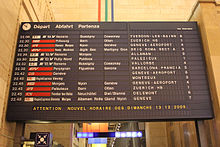
- The TGV Lyria ( Train à grande vitesse , French/Swiss high-speed railway connection), with several trains daily from/to Paris , Dijon , Lyon , Avignon , Aix-en-Provence and Marseille .
- Hourly EC ( EuroCity ) trains from Milan with connections to all parts of Italy .
- Regular ICE ( InterCity Express , German high-speed trains) from Zurich and Interlaken via Berne , Basel to Freiburg i.B. , Offenburg , Baden-Baden , Karlsruhe , Mannheim , Frankfurt a.M. (main railway station or airport ) in Germany, many continuing toward Cologne and Dortmund , or Hannover and Hamburg , or Berlin , or Amsterdam .
- Regular IC ( InterCity ) trains between Zurich and Stuttgart , travel time 3 hr
- Regular EC ( EuroCity ) trains between Zurich and Munich , travel time 4 hr
- Regular RJ ( RailJet ) trains between Zurich and Innsbruck (3½ hr), Salzburg (5½ hr), Vienna (8 hr) in Austria, and further to the east
- Sleeper trains operated by ÖBB as Nightjet
You can use most of these trains with the exception of night trains domestically in Switzerland with a normal domestic ticket, but keep in mind that they may arrive at the end of a long journey and may not reach the very high Swiss standards for punctuality.
Information for railway enthusiasts [ edit ]

In Switzerland, more than 99% of the railway infrastructure is electrified, but it is possible to find steam railways such as the Brienz Rothorn Railway, the Furka Cogwheel Steam Railway and others.
There are many interesting mountain railways of all types. In Switzerland most electric trains get their power from a single phase AC network at 15,000V 16 2/3Hz. This network uses its own power lines run with 66 kV and 132 kV, which have, unlike normal power lines, a number of conductors not divisible by 3. Most power lines for the single phase AC grid of the traction power grid have four conductors. Railway photography is permitted everywhere provided you don't enter forbidden areas without permission.
Here is short list of the most remarkable railway lines:
- The Glacier Express (GEX) between Davos / St. Moritz (en: Grisons, de: Graubünden) and Zermatt (Valais), an 8-hour trip through the central Swiss Alps . The train has special wagons with curved windows on the roof, supplement required. Views in all directions .
- The Bernina Express (BEX) between Davos / Chur and Tirano in Italy, via Pontresina / St. Moritz over the Bernina pass (2253m o.s.l.) the highest rail transversal in the Alps , high mountain scenery. The train has special wagons with curved windows on the roof with views in all directions. Supplement required.
- The Pre-Alpine Express (VAE, Voralpenexpress) running between St. Gallen / Lake Constance and Lucerne , through the rolling hills of the Appenzellerland down to Rapperswil , where it crosses the first, eastern part of Lake Zurich, then up again through the lovely moor of Rothenturm (saved from military destruction by a publicly initiated referendum in 1987) and close to Einsiedeln down again to Arth-Goldau at the bottom of the Rigi and further to Lucerne along the Lakes of Zug and Lucerne.
- The Jungfrau Railway , from Interlaken (560 meters) to the Jungfraujoch station (3450m a.s.l.) in two hours. Definitely the most impressive journey in the Alps.
- The Gornergrat Railway , departure from Zermatt to the 3090m a.s.l. high Gornergrat.
- The Mount Rigi Railway , oldest mountain railway in Europe.
- The Mount Pilatus Railway , from Lucerne to the top, the steepest (max. 48% gradient) railway in the world.
- The Brienz Rothorn steam cogwheel railway above lake Brienz to the Rothorn summit (2350m a.s.l.) and almost exclusively run by steam locomotives.
- The Lötschberger is a line connecting Berne / Spiez ( Bernese Highlands ) and Brig ( Valais ), not considered as a mountain train but with still impressive scenery, especially if you take the route by a regional train ('RE') through the old 14.6-km-long Lötschberg vertex tunnel (between Kandersteg and Goppenstein, 500 m above the 34.6-km-long Lötschberg Base Tunnel, a high-speed train tunnel opened in 2007).
- The St. Gotthard line [dead link] with its many spiral train tunnels and the 15-km-long St. Gotthard vertex train tunnel (built between 1872 and 1882, 199 workers lost their lives in its construction) connecting the German spoken northern Switzerland Zurich / Luzern and the Italian spoken southern Switzerland Ticino ( Bellinzona , Lugano , Locarno ). Also advertised as the Gotthard Panorama Express [dead link] between Luzern and Flüelen by boat, and further then by train to either Bellinzona , or Locarno / Lugano .
- Has custom banner
- Articles with dead external links
- Usable topics
- Usable articles
- Rail travel in Europe
- Topics in Central Europe
- Topic articles
Navigation menu
A Complete Guide To Train Travel in Switzerland

Taking a train ride is one of the best ways to enjoy the incredible views that the natural wonders of Switzerland offer. Train rides and beautiful landscapes have almost become synonymous with Switzerland.
Tourists, visitors, and Swiss residents themself have to enjoy a train ride at least once in their lifetime. But for a large part of the Swiss population, train rides are more than tourist attractions. They are an essential part of their public transport service which makes their daily life easier.
Let’s take a look at how train travel works in Switzerland.
Train Travel in Switzerland
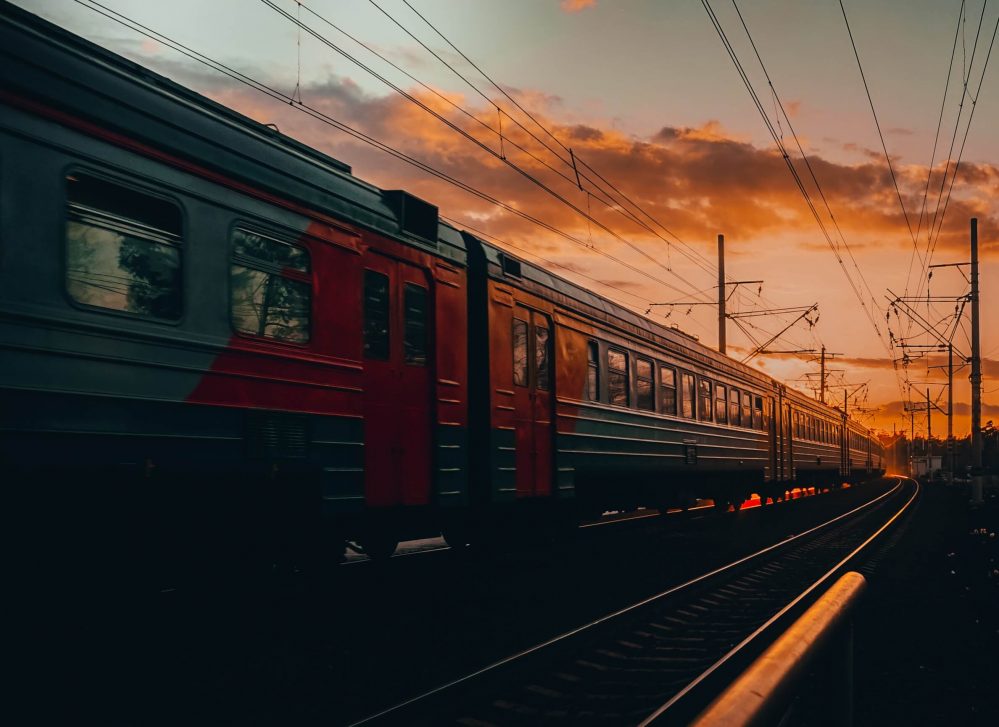
Switzerland’s national railway company is the Swiss Federal Railways . It is the largest railway and transport company in Switzerland, and it covers approximately 3260 km of the railway as of 2020. Other railway companies include BLS and SOB .
The Swiss network system has two main routes, domestic and international. The most popular domestic routes are Basel-to-Bern, Basel-to-Zurich, Bern-to-Geneva, and Geneva-to-Zurich, whereas popular international routes include Zurich-to-Hamburg, Zurich-to-Vienna, and Zurich/Basel/Geneva-to-Paris.
Switzerland Travel Pass Options
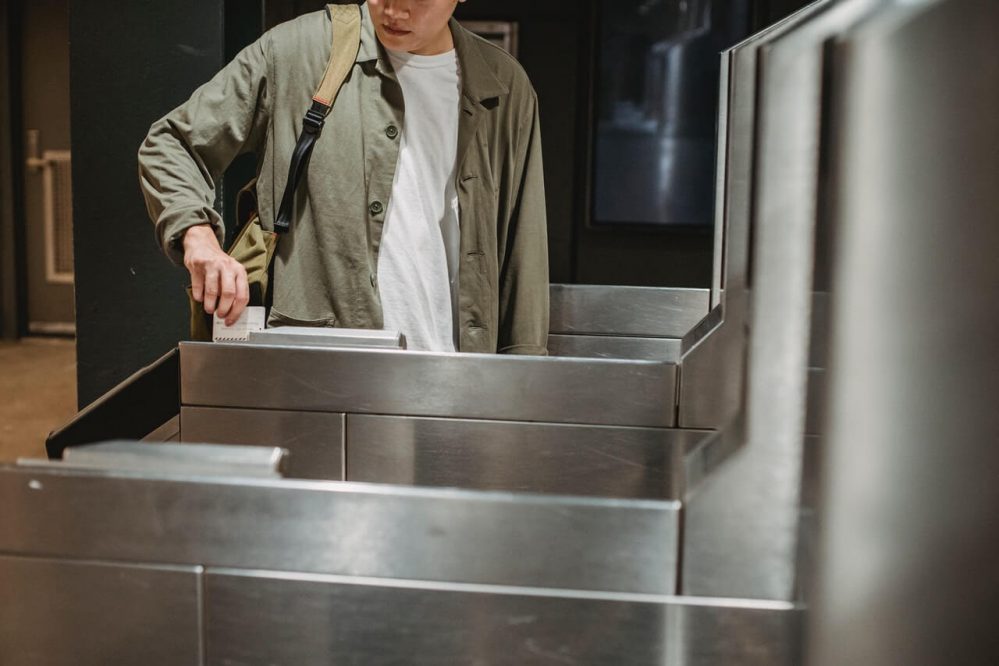
The Swiss travel pass was specifically created to enable people to travel more freely throughout all Swiss territories. It is available to individuals permanently resident outside Switzerland and the Principality of Liechtenstein.
Swiss Travel Pass
Swiss travel pass comes with different travel day options, and you can choose between 3, 4, 6, 8, or 15 consecutive days of travel within one month. Also, you can choose if you want your Swiss travel pass to be available for 1st class or 2nd class transport.
Swiss Travel Pass Flex
The Swiss Travel Pass Flex is a great option that allows you to select the days on which you will use the travel pass in order to take maximum advantage of this service.
Just like a standard travel pass, the days you choose have to be within one month, and you can choose between 1st and 2nd class transport. However, you should know that the Swiss Travel Pass Flex can be significantly more expensive than the standard travel pass. For example, a three-day travel pass costs 232 CHF for the 2nd class and 369 CHF for 1st class, while a three-day travel pass flex costs 267 CHF for 2nd class and 424 CHF for 1st class.
Swiss Half Fare Card
A Half Fare Card is a travel card that enables you to pay half the price for all the public transport means. If you’re aged between 16-25 and buy a Swiss Half Fare Card, you can also get a Half Fare Youth Card for an exclusive price.
The Half Fare Card has an indefinite use time and renews itself automatically. The card is joined with your travel pass card and remains valid for the same time of use.
Saver day pass and 1 Day Travel Pass
A Saver Day Pass or One-Day Travel Pass is a travel card that enables you to travel for free by all public means of transport in Switzerland. Similar to other travel cards, this card is available for 1st and 2nd class transport and can be purchased at half price when using a half fare card. Unlike some other types of travel cards, this card has to be booked in advance, at least one day before.
Swiss Family Pass
A Family Pass is a travel card that enables a family to cut the cost of travel by allowing members aged 16 or younger to travel for free on all forms of public transport.
This card can be purchased by parents and is available to buy at all train stations in Switzerland. And remember, children under the age of 6 always travel free of charge; however, they have to give up their seats in case the vehicle is overcrowded.
Train Tickets Without a Travel Pass
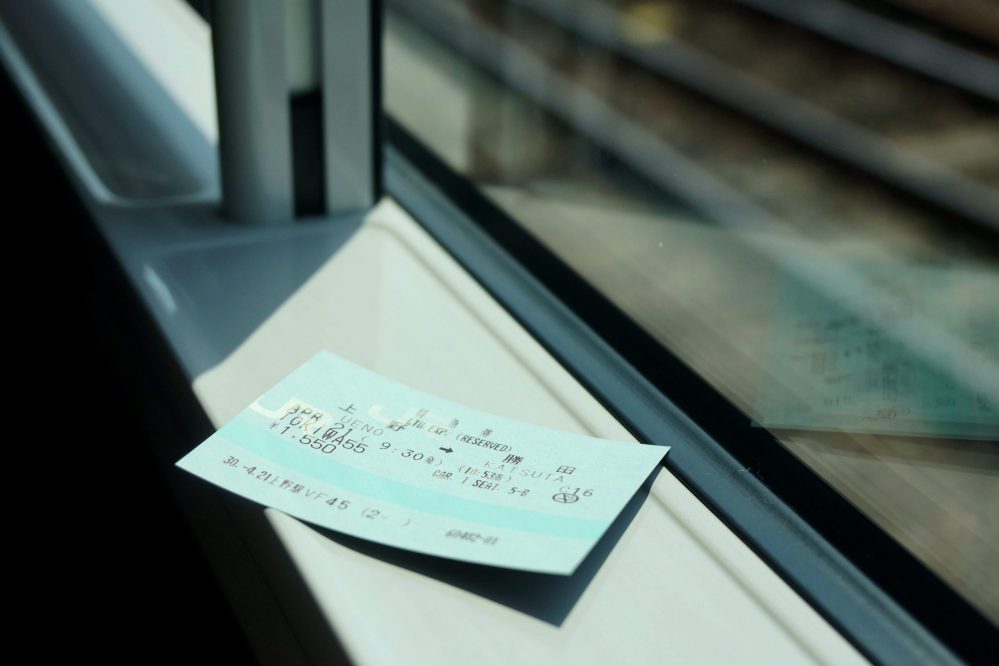
Then there is the multiple-journey ticket which, similarly to point-to-point tickets, is a one route ticket, but this ticket enables you to travel up to six times through that same route.
Another option is the city ticket, which is perfect for people who travel to urban areas by train. This train ticket enables you to use urban public transport for free.
In addition to all the in-country transport routes, the Swiss railway service also offers transportation to several other European countries. The most popular destinations are Germany, Austria, France, and Italy. To travel to these destinations, you must buy a ticket for traveling to Europe . To purchase these tickets, you should look at the specific regulations and conditions of the particular country you want to travel to.
How To Buy Swiss Train Tickets in Switzerland?
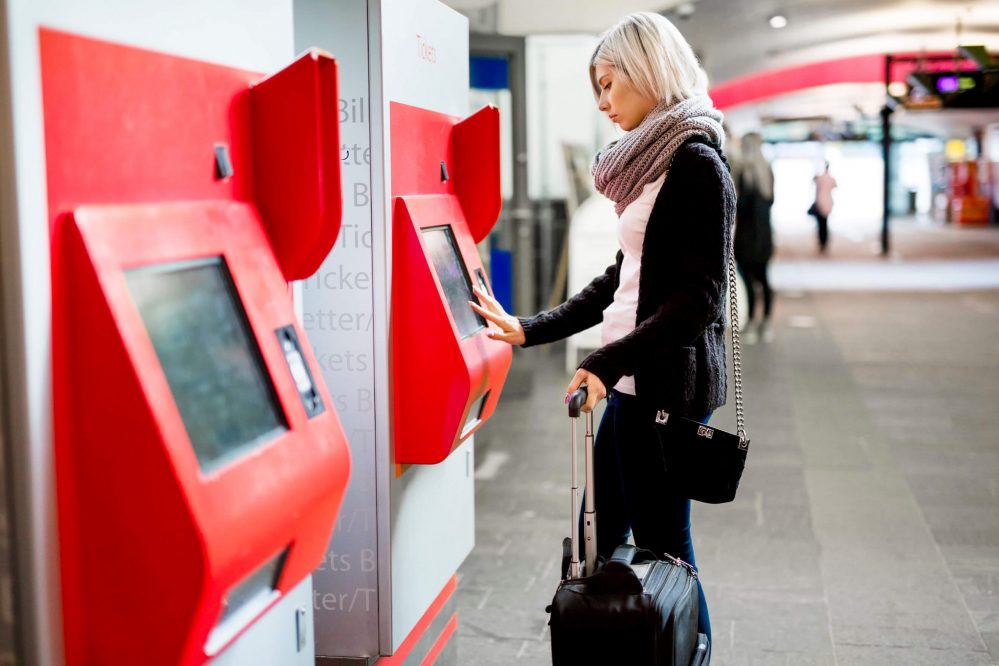
You can also purchase tickets physically at the ticket counters located in each train station. However, like in most other purchases that people make nowadays, the favorite method of buying tickets by foreign residents, tourists, and Swiss residents is online. SBB offers online services where you can purchase all types of tickets and travel passes. The company also offers an online and offline timetable in order for customers to be informed about the time of arrival and departure of the trains at all times.
First vs. Second Class Train Ticket in Switzerland
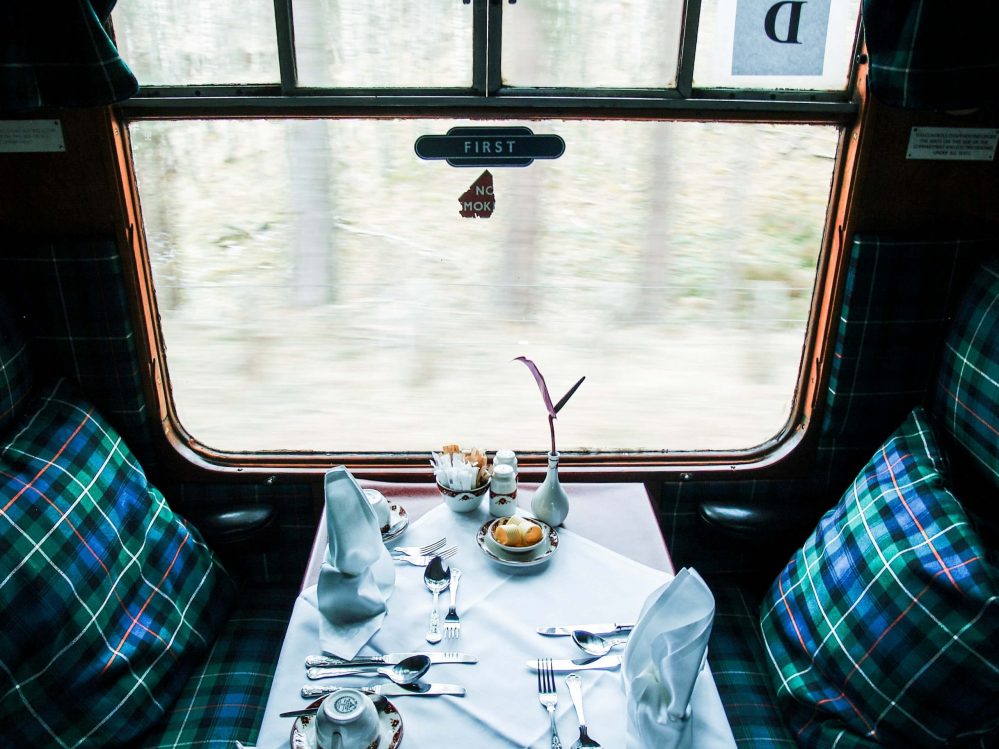
You can purchase class upgrades on daily and multiple days tickets or passes. The daily class upgrade costs 52 CHF, while the multiple-day class upgrades cost 312 CHF. However, if you have already bought a 2nd class ticket or pass, and you want to change class, you have the option to do so.
Panoramic Trains in Switzerland
One of the reasons Swiss trains are so popular in foreign countries is the many panoramic routes available in the Swiss railway system. These trips have initially been taken for practical reasons; however, many people take these trips solely to enjoy the beautiful view. Many of these lines are very old and would be out of service if not for the beautiful scenery they offer to their passengers. So let’s take a look at some of these lines.
The Alpine cruise is a luxury train cruise that travels throughout the canton of Graubünden and has the reputation of being one of the most scenic train rides in the world. And if you are a fan of French Switzerland, the Glacier Express is a train ride that goes through the beautiful Alps in the canton of Valais. The journey connects the ski resort of Zermatt with that of St.Moritz.
Another panoramic line is the Bernina express . This line is the highest altitude rail route in Europe, and it connects the Swiss city of Chur with the Italian city of Tirano. The line is also a UNESCO world heritage line.
Tips for Travelling by Train in Switzerland
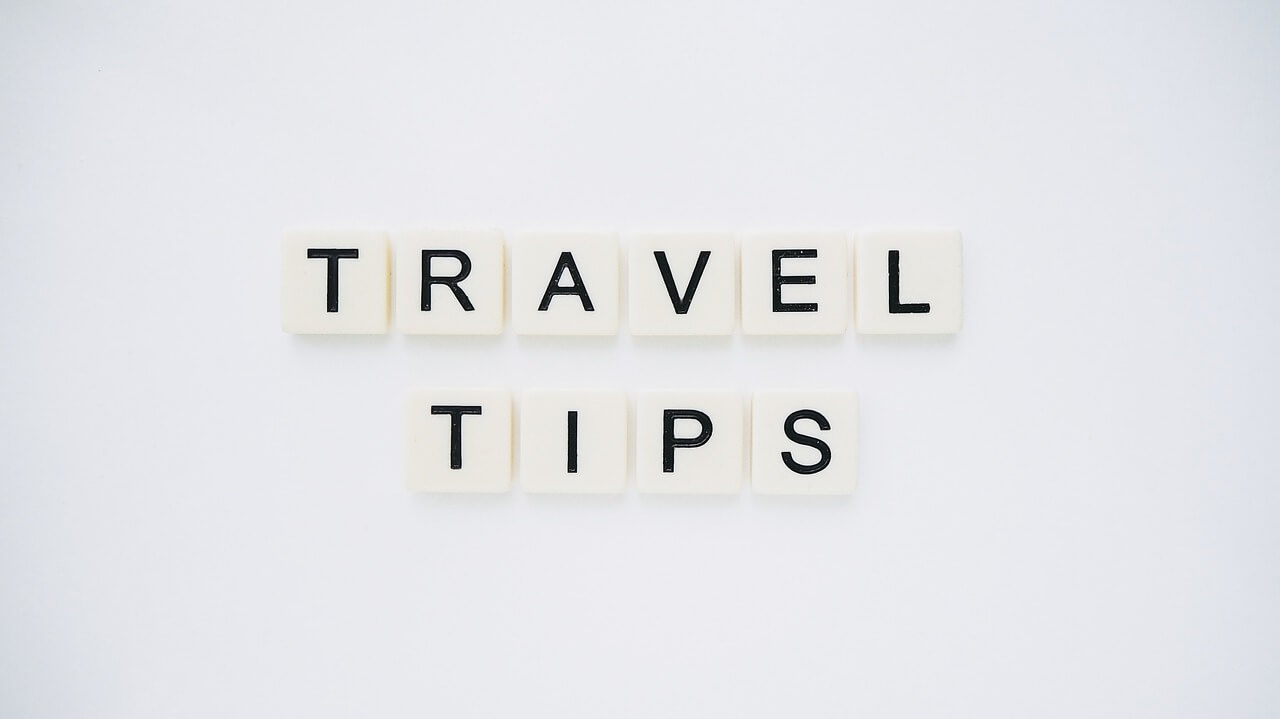
- Pre-Plan your trip so that you don’t get anxious during your travels.
- Study the tickets and passcards prices and offers to calculate your spending and get the best offers possible.
- Study the railway system, and be attentive in the train station to avoid unpleasant surprises such as being lost or missing your train’s departure.
- Get luggage service to avoid the unnecessary exhaustion of carrying your luggage.
- Have a means of light transport for short distances. A bicycle would be perfect and can be loaded onto other means of public transportation.
- Enjoy the view and the food ; they might be a once-in-a-lifetime experience.
Bottom Line
Train travel is at the heart of Switzerland’s identity. Switzerland’s advanced and elaborate railway system is an excellent means of transport for its residents and foreigners. It is easily accessible, provides great transport conditions, and offers a beautiful travel experience.
Leave a Reply Cancel reply
Your email address will not be published.
Save my name, email, and website in this browser for the next time I comment.
University of Central Florida

Founded as a public institution in 1785, UGA boasts an illustrious history in higher education. Today, Georgia's flagship university offers online programs to make a UGA degree more accessible. The online courses limit class sizes and use the same high academic standards as on-campus classes. UGA offers an online bachelor's degree in special education and multiple online graduate programs in education. Degree-seekers can also earn master's degrees in community nutrition, international biomedical regulatory sciences, emerging media, and avian health and medicine. Other available online master's programs include business, technology, and social work.
- VIEW PROFILE
University of Georgia is regionally accredited by the Southern Association of Colleges and Schools Commission on Colleges (SACSCOC).
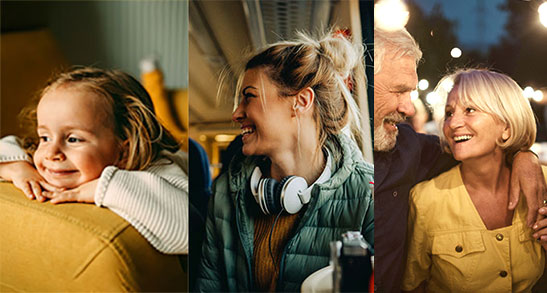
10% your international health insurance for life!
Scorestudies includes higher benefits than the Swiss compulsory health insurance, it is very often on a full refund basis and no co-payment of 10% is required. In case of emergency, hospitalisation or prescribed medication, you are fully reimbursed by Allianz Care.

13 Magical Trains in Switzerland You Need to Ride ASAP
Last Updated: October 31, 2023
*FYI - this post may contain affiliate links, which means we earn a commission at no extra cost to you if you purchase from them. Also, as an Amazon Associate I earn from qualifying purchases. Check out our Privacy Policy and Disclosure. for more info.
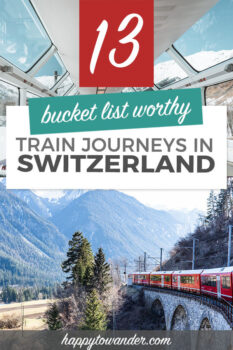
Having just returned from a whirlwind binge of Switzerland’s most scenic trains, I can say without an ounce of exaggeration that the Swiss train system is a true marvel of magic.
And beyond their surplus of scenic routes, razor-sharp punctuality and Care Bear-friendly service, the crowning jewel of the Swiss rail system is, in my opinion, its glittering roster of scenic, panoramic Swiss trains – a holy grail of sorts for those traversing Europe by rail.
As I’m sure you know, train travel in Europe is an oft glamourized mode of transport, a classy and elegant contrast to the stuffy conditions of air and bus travel.
Well, I’m happy to report that in Switzerland, all your swankiest train dreams do indeed come true.
As a Canadian who grew up far removed from train travel, I admit the concept always delighted me (thanks, Hogwarts Express!!), and now even after so many years of frequent rides, I’m still like a giddy sugar-high child on her own moving candy shop.
Take it from this fangirl then, European train travel doesn’t really get better than Switzerland.
So, are you keen to try some scenic Swiss train rides for yourself? Here are some of my top picks for train rides in Switzerland you simply cannot miss.
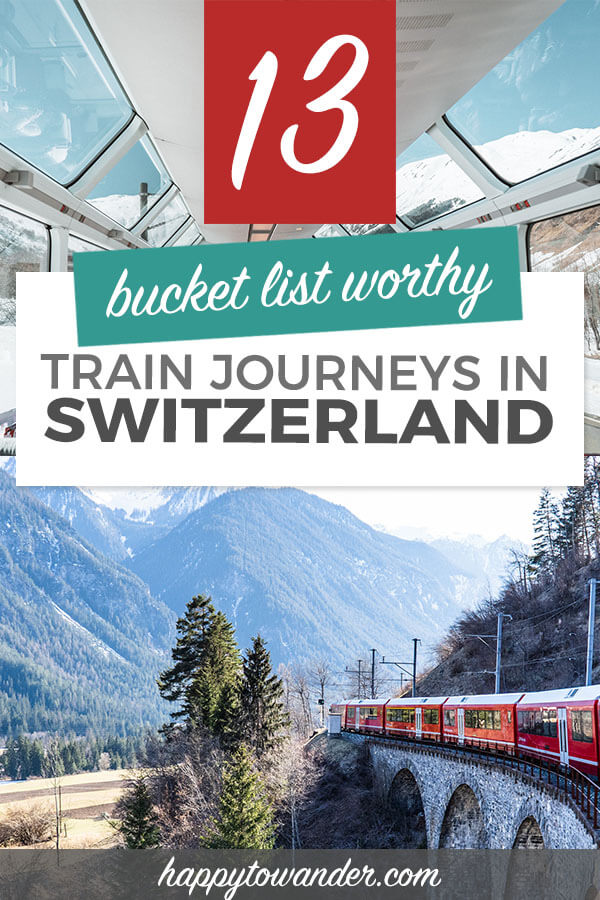
Save this List of Amazing Swiss Train Rides for later!
You’ll be very glad you did.
The Most Magical Swiss Train Rides You Need to Try
The following are all stunning Swiss train rides that I have personally done and consider extremely bucket list worthy, whether for the landscapes, the trains themselves or just the overall experience. So, without further ado, here are some trains in Switzerland that you definitely cannot miss!
Money saving tip: If you plan on doing many of these train rides in one trip, look into huge money savers like the Swiss Travel Pass , the Half Fare Travel Card or a Eurail Pass to potentially save hundreds of dollars. More on this below!
1. The Golden Pass (Classic)
This Switzerland scenic train is, without a doubt, my favourite.
While not as famous as big Swiss names like the Glacier or Bernina Express , if it’s a touch of old world glamour and Belle Époque elegance you’re looking for, then please, book yourself on the Golden Pass Classic as soon as humanly possible.
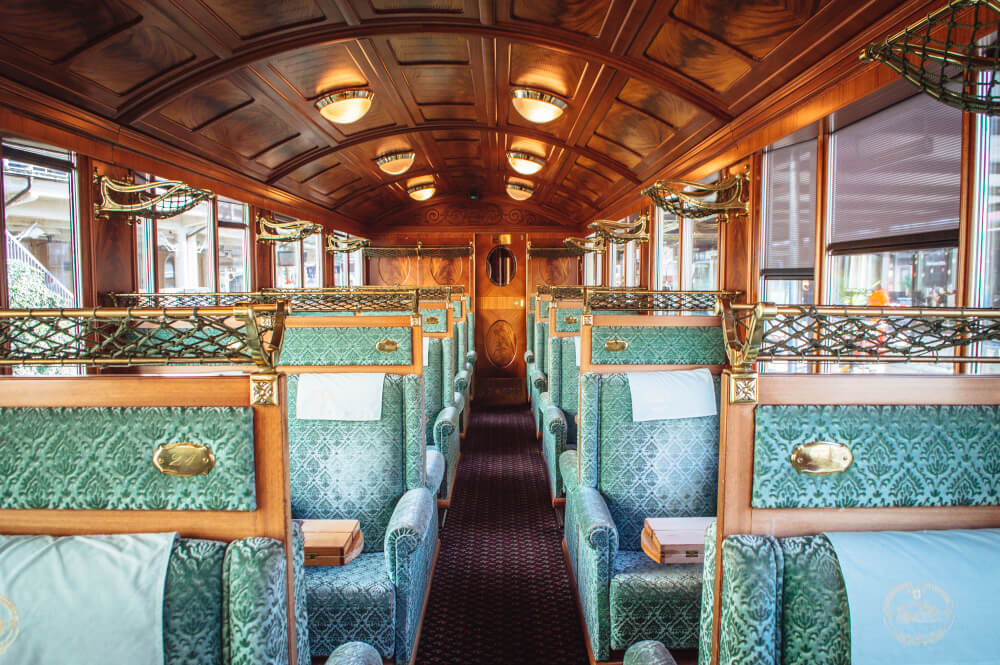
The entire GoldenPass line is a tremendously scenic line running between Lucerne and Montreux in three separate segments, offering sweeping views of snow-dusted peaks and eight glimmering lakes along the way.
While the entire route is well worth drooling over, the segment from Montreux to Zweisimmen in particular is one I’d highly recommend because a few times a day, you can do the route in the “MOB Belle Époque” which is modelled after a 1930s Orient Express style luxury train.
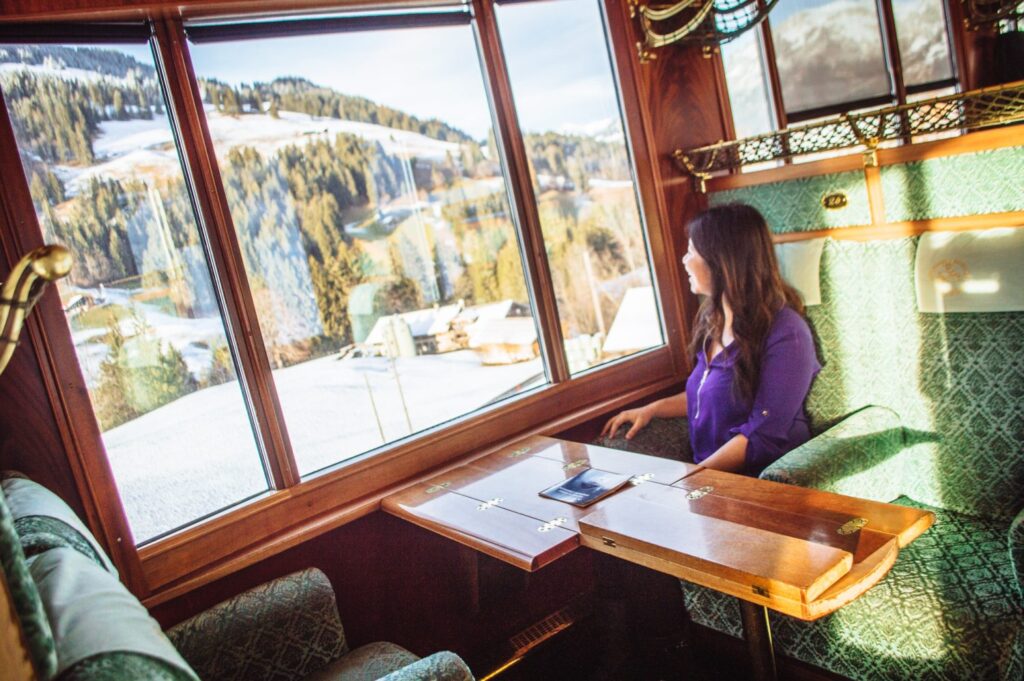
If you’re feeling especially swanky, splurge for 1st class, where you get to sit in plush green armchairs while taking in all the stunning scenery. I have to admit, this felt even swankier than that $7000 train ride I did in India!
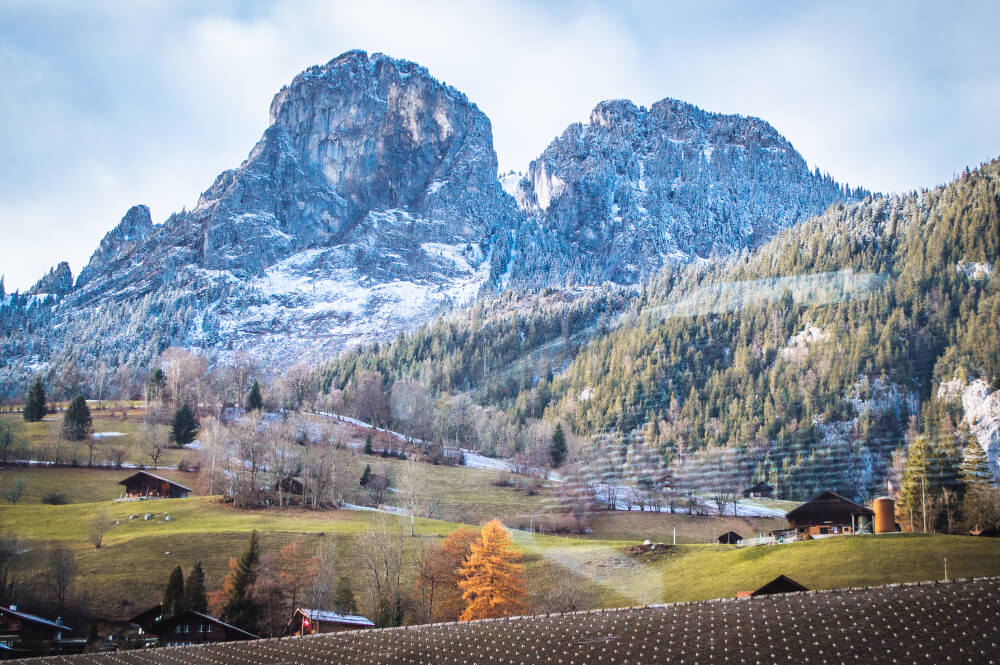
NOTE: The Golden Pass from Montreux to Zweisimmen ALSO has trains called the “MOB Panoramique” that do the same route, but with modern cars and not the classic ones. If you really want the experience I described above, make sure you are booking on the “MOB Belle Époque”.
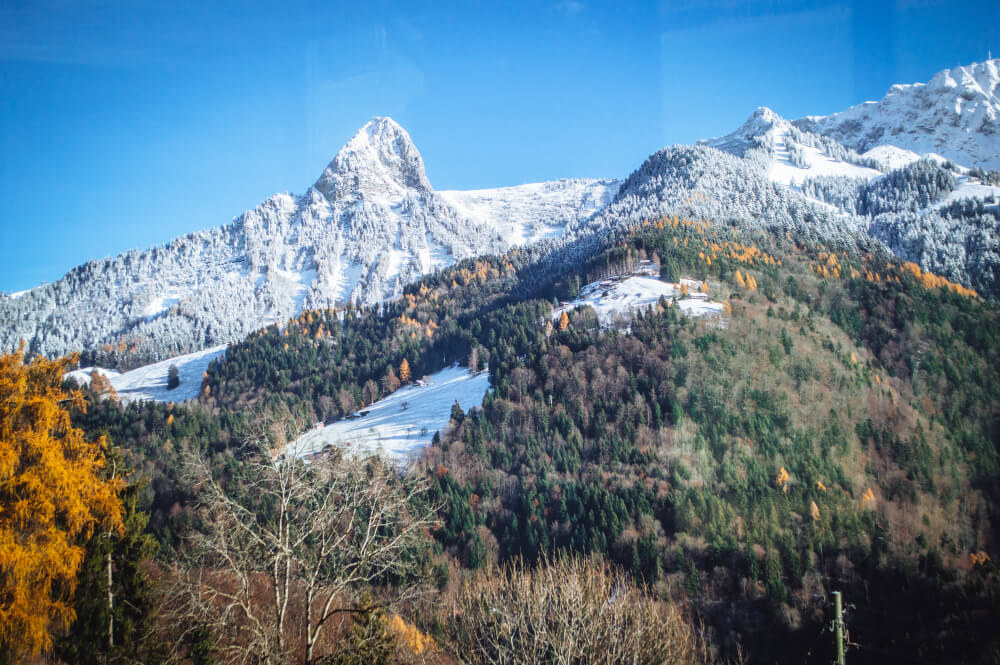
BONUS TIP: I did this scenic ride in November, and I got to witness golden autumn colours mixed in with all the snowy mountains, while enjoying the benefit of fewer crowds. I’d highly recommend this time of year for it! You can also stop off at some of the most magical Christmas markets in Switzerland along the way, including the beautiful lakeside Christmas Market in Montreux.
2. The Glacier Express
This famous Swiss Alps train ride is known as one of the most luxurious and best train rides in Europe, so it’s no wonder it’s made my list (read my honest review of the Glacier Express in 1st class! ).
End to end, it brings you between the swishy ski resorts of Zermatt and Saint Moritz, stopping in a variety of stops like Andermatt and Chur along the way.
From start to finish, you’re looking at a tortoise-like slow ride of about 8 hours, ensuring that it does indeed earn its title of “the slowest express train in the world”.

And while the Glacier Express is certainly not everybody’s cup of tea (again, it’s very very slow and takes up an entire day), I loved it for the experience.
There’s nothing quite like a long scenic train ride to give you an ample dose of dreamy “I love the world” moments.
Imagine giant panoramic glass windows, plush, comfy chairs, and my personal favourite: table service with hot three course meals served straight to your seat.
After all, if you’re taking a train through Switzerland, why shouldn’t you be inhaling a giant chocolate pudding at the same time?

It’s not just about the food of course. This wonderful train ride through the Swiss Alps will take you from snow-dusted mountains and terraced vineyards to rocky gorges and turquoise rivers.
This is definitely a bucket list trip that comes with a hefty price tag, but if you want to treat yourself to one of the best train trips in Switzerland, this is it. Just don’t expect to get anywhere in a hurry 😉
Read my full guide to the Glacier Express for more info.
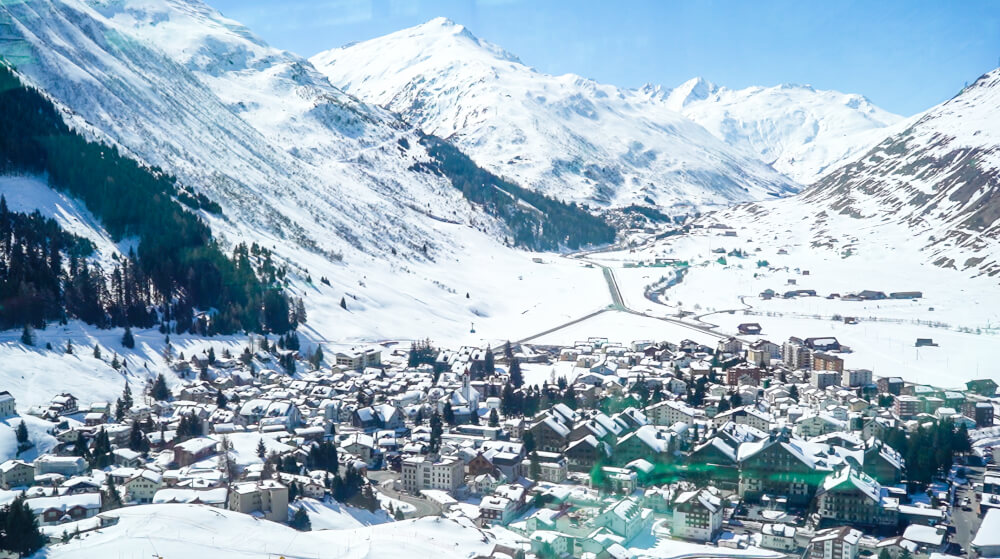
3. The Bernina Express
Bar none, the Bernina Express is one of the most famous train trips in Switzerland, and I’m happy to report that it does indeed live up to all the hype and buzz!
This four hour ride between Chur and Tirano is one that brings you from the snowy mountaintops of Switzerland down to the warm, balmy Mediterranean views of Italy , passing by a constant barrage of unique landscapes along the way.
No doubt, if it’s excellent value you’re looking for, this is the train I’d recommend. read my full guide to the Bernina Express for more info.
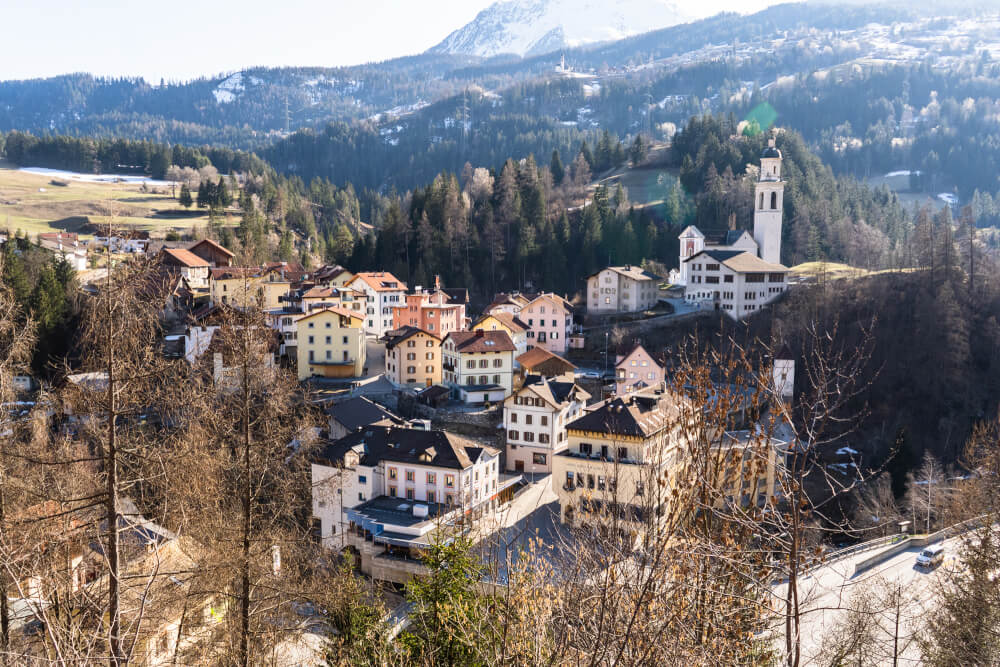
Compared to other journeys (side-eying you, Glacier Express ), the Bernina Express is quite a short ride, but the diversity of landscapes you get to take in is breathtaking.
From ruined castles and fortresses to quaint alpine villages and famous viaducts, the Bernina Express is like a “best of” tour of Switzerland, all in a compact, time-friendly package.
Just to warn you though, your memory cards will all run out of space, and your phone will 1000% die from the sheer beauty of it all.
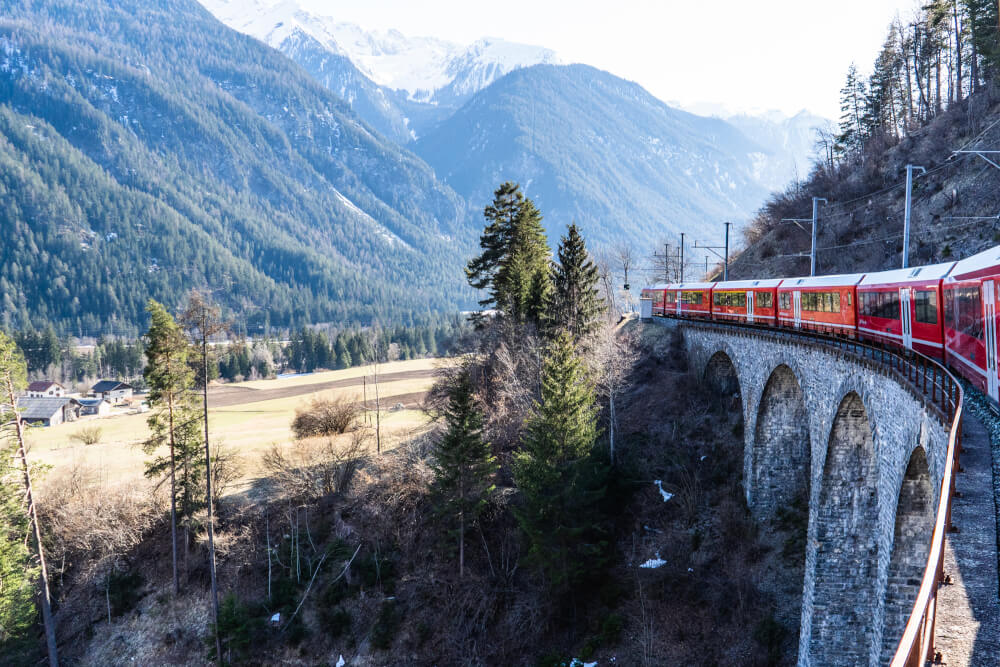
NOTE: If you are a keen photographer, or prefer to avoid touristy crowds, I would actually recommend doing this ride using regional trains instead. More on this below!

This Switzerland train ride has amazing views in winter too:
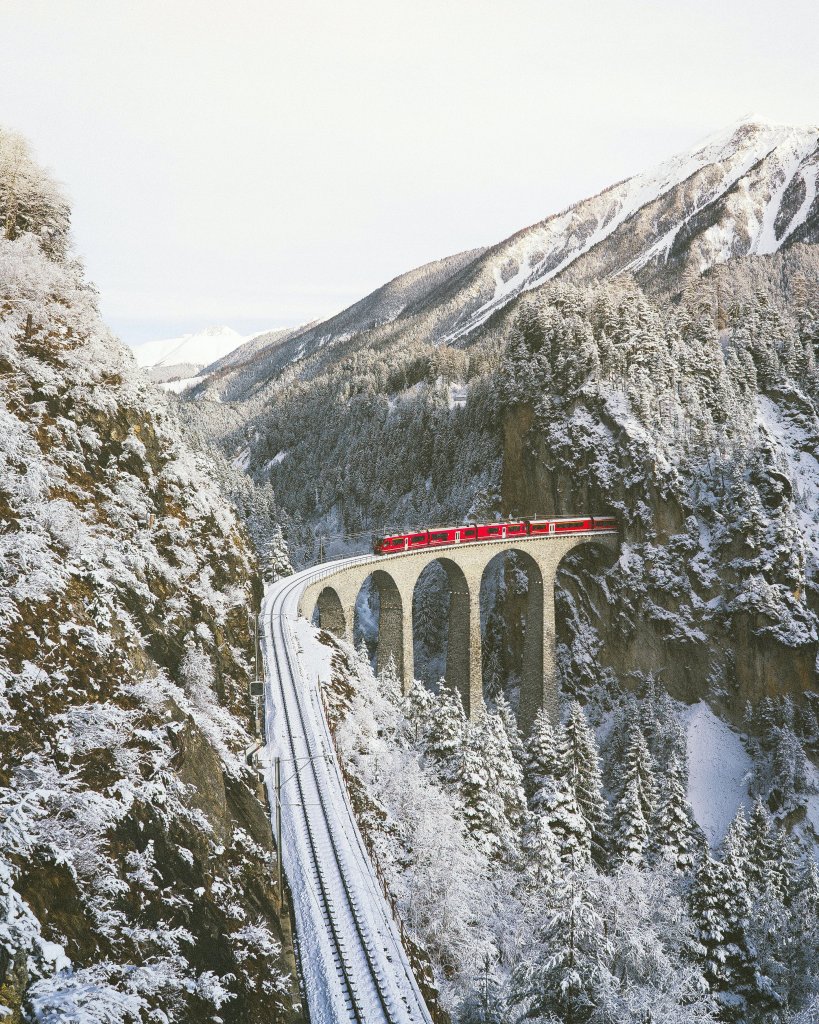
4. The Transalpin (from Austria to Switzerland)
It’s definitely not the most well known of all Swiss train rides, but I recently rode the Transalpin from Innsbruck to Zurich, and was blown away.
This EuroCity Express ride is one that isn’t marketed as being a scenic sightseeing experience, but is nonetheless one that brings you across some awe-inspiring landscapes in Austria, Switzerland and even the wonderful micro-nation of Liechtenstein .
The scenery you pass is gorgeous, but the starring feature for me is the panoramic 1st class car that they add to one journey a day, which allows you to soak in the views with giant windows just like on the sightseeing trains mentioned above.
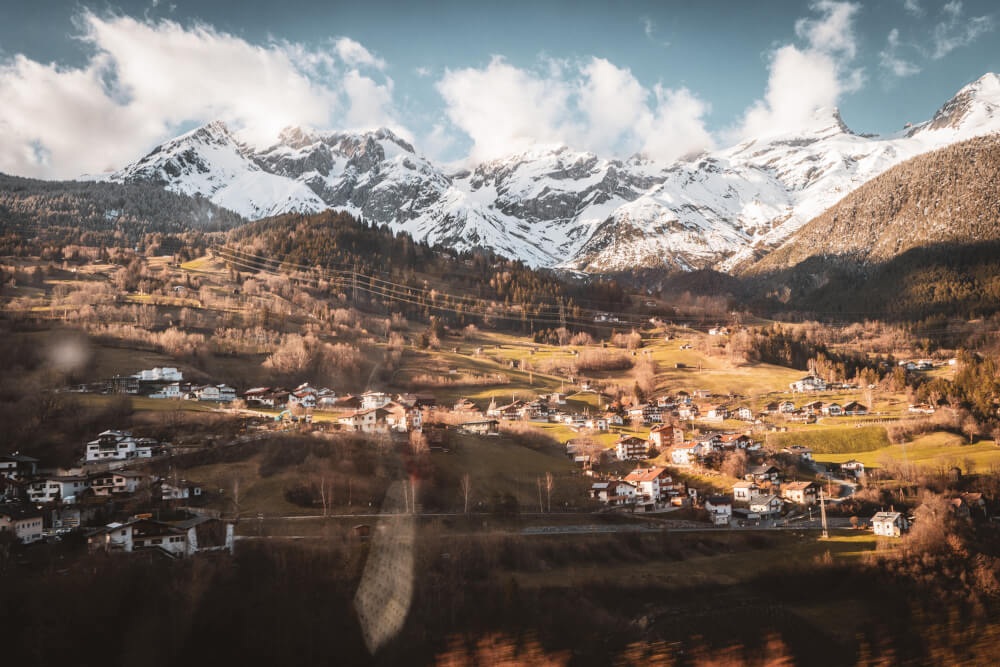
Seriously: it’s the glamour of the aforementioned express trains, but without the crowds!
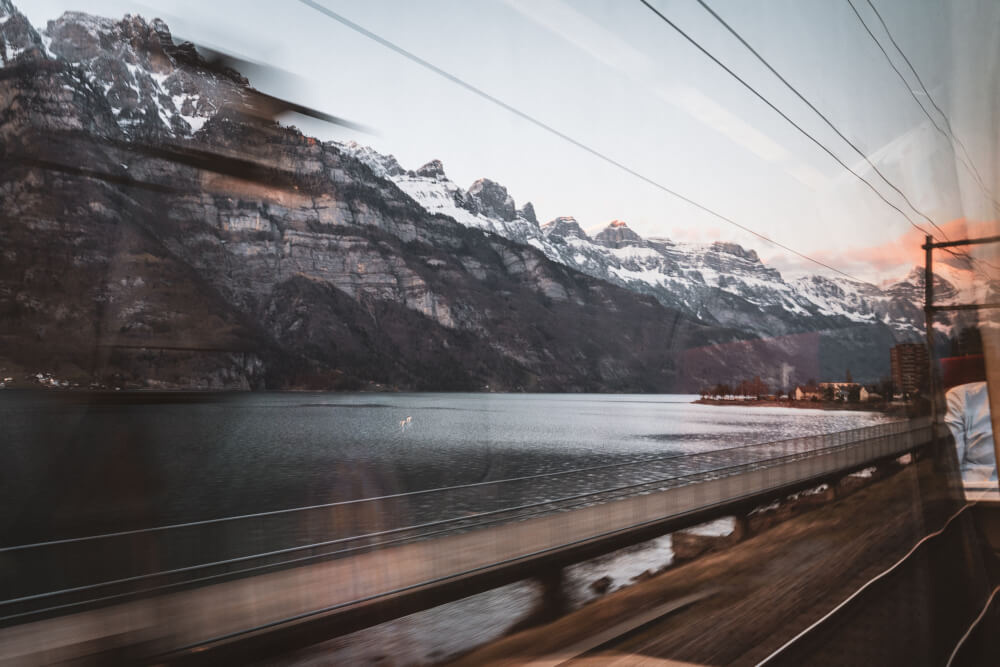
The best part is, taking this panoramic train at 3:48pm from Innsbruck in March meant I was able to watch sunset from the train, and let me tell you: watching the sky turn fiery pink over Walensee as we weaved through the impossibly green rolling hills of Austria, then Liechtenstein, then Switzerland was pure magic.
This is a lesser known Swiss panoramic train, and definitely a hidden gem that you should consider adding to your Switzerland train tour.
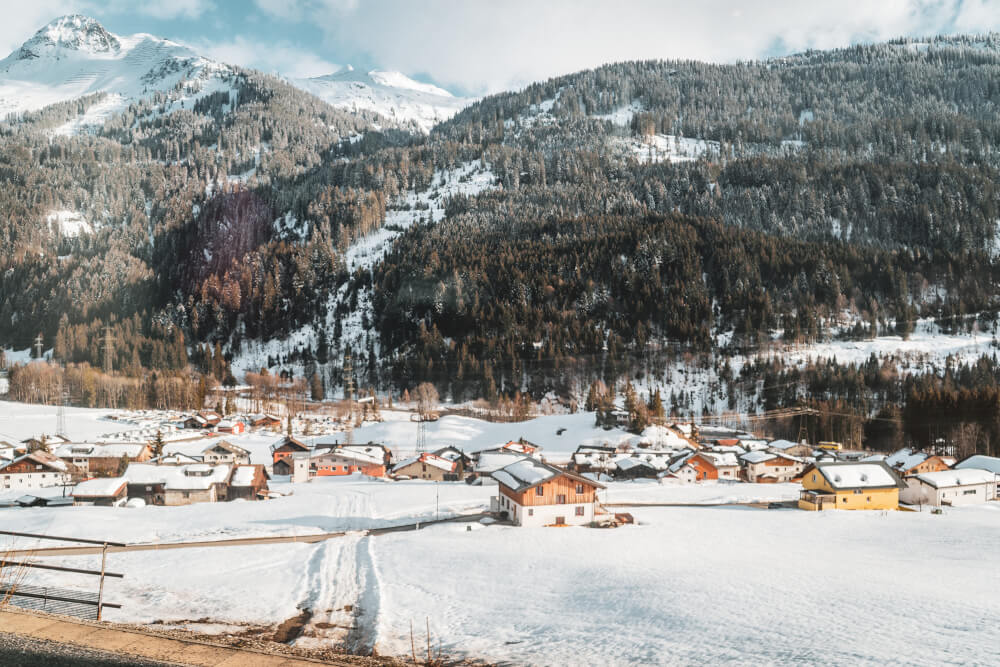
5. The Matterhorn Gotthard Bahn
Alright, listing the Matterhorn Gotthard Bahn is kinda cheating because the following route is technically a segment of the Glacier Express.
But since the Glacier Express is a million years long and not everyone has the luxury of spending a full 8 hours on a scenic train, I would recommend the Matterhorn Gotthard Bahn from Visp to Zermatt as an excellent taste of the Glacier Express experience.

Not only do they have panorama cars just like on the Glacier Express, the rugged scenery here (I would argue) is one of the best parts of the entire GE journey.
Leaving from Visp, you pass by rocky mountains, terraced vineyards, turquoise rivers, and of course, as you approach Zermatt, snowy Alpine towns and even the famous Matterhorn if you pay attention! I didn’t, and managed to miss it, although thankfully I got some great views of it in town!
If you want to experience a panoramic train in Switzerland without paying a reservation fee (and without the accompanying crowds of the more popular scenic trains), then this is a great option.

Other (Non-Tourist) Swiss Train Rides and Routes I Recommend
Train travel in Switzerland is next level, so naturally, the country has far more to offer than just the panoramic tourist trains mentioned above.
In fact, pick any random route in Switzerland and it’s bound to bring you somewhere pretty scenic.
That said, here are some of my top picks for train rides I’ve done that weren’t part of the panoramic express rides mentioned above, but are still pretty incredible (with the added bonus that they don’t feel at all touristy).
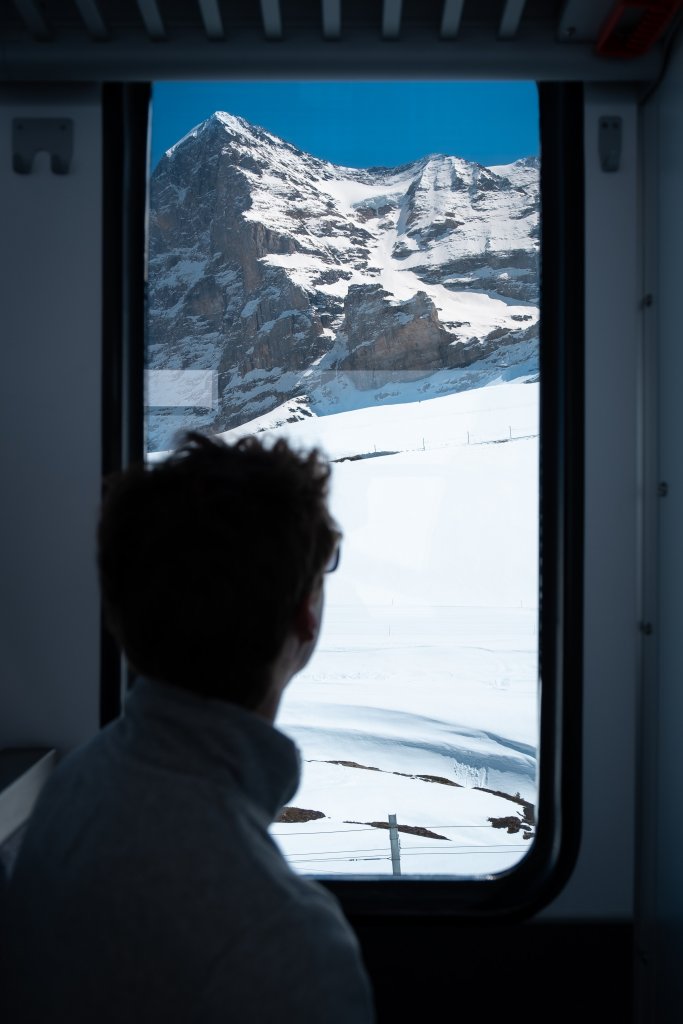
6. The Express routes above but on regional trains
So here’s a secret I’ll let you in on: all the “Express” trains mentioned above are so-named because they are built for sightseeing, and take you end to end with no stops… BUT regional trains travelling between those areas go past the exact same landscapes, often with fewer crowds, and the ability to open windows on certain trains.
So, while most Swiss train tours will bring you along one of the ‘Express’ trains, if you are an avid photographer, want to save money on the reservation fee, or would like to stop at different towns along the way, then I would recommend doing the Bernina Express and Glacier Express on regional trains instead.
I did this on my return leg from Tirano to Chur (AKA the Bernina Express route) and I loved the experience. I had a carriage all to myself, I could open the windows and overall, I was like a happy puppy sticking her head out a car window the entire time ! 10/10 would recommend.
NOTE: Download the SBB app to look up regional routes with ease. It’s one of the handiest Europe travel apps out there if you’re headed to Switzerland!
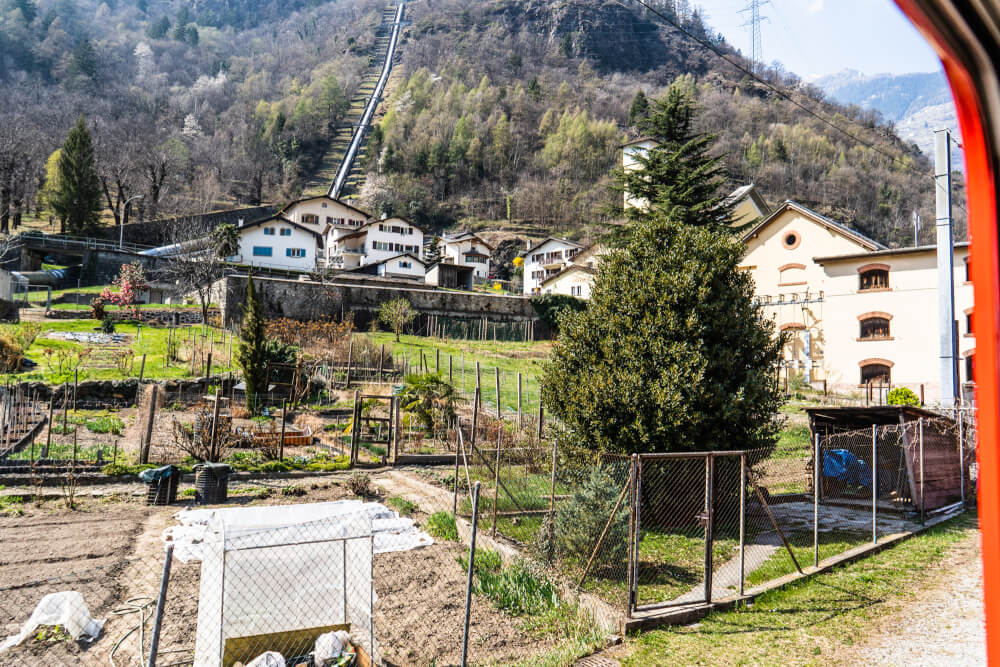
7. From Interlaken to Thun
The clarity and colours of Lake Thun are seriously next-level, so if you can, enjoy the views from a train going from Interlaken to Thun.
I recently got to enjoy the view below while going from Interlaken to Spiez, and I really couldn’t believe my eyes.
Is water even legally allowed to be that blue? Was I trapped in an over-saturated anime?
These are the kinds of existential questions that you’ll find yourself asking on board this ride 😉

8. From Interlaken to Lauterbrunnen
One of the biggest treats of doing Switzerland by train is being able to slowly enjoy the fairytale-esque landscapes, and as far as colourful postcards go, it’s tough to beat the short ride from Interlaken to Lauterbrunnen .
Rolling green hills, towering mountains and an endless parade of lush green trees await. The best part? The view riding into Lauterbrunnen, as the iconic Staubbach waterfall comes into view.
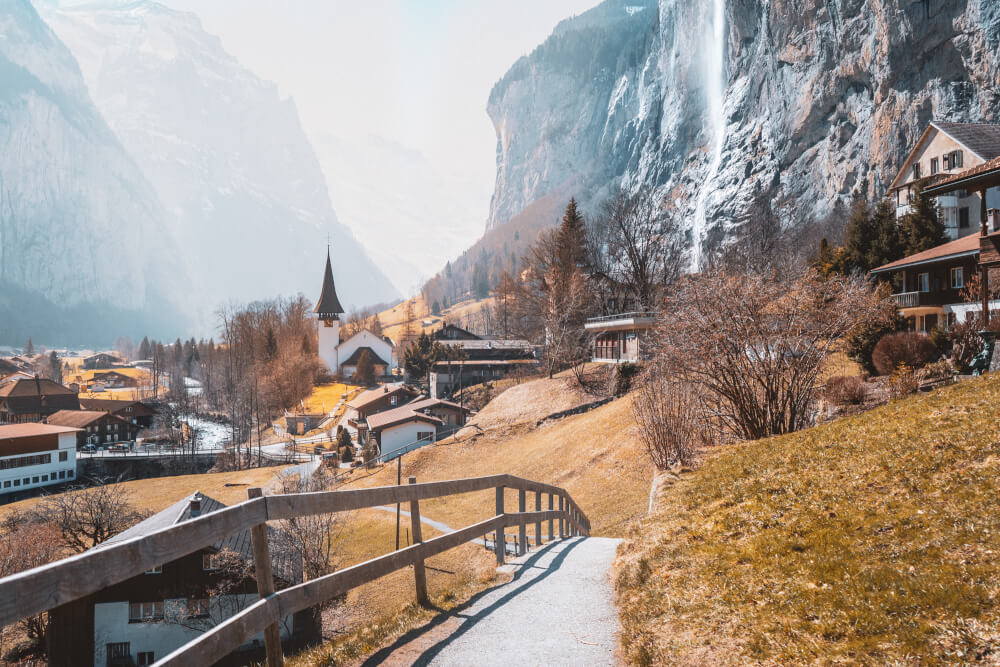
9. From Buchs to Zurich
I love that this Switzerland train ride takes you past two stunning Swiss lakes: my personal favourite, the impossibly turquoise Walensee, and of course the beautiful Lake Zurich.
This is a ride I’ve gotten to enjoy a few times, and it’s certainly one of my favourites.

10. From Lausanne to Montreux
Alright, so this is another short ride, but it’s an unbelievably beautiful one that glides along the clear blue waters of Lake Geneva the entire time, with a foreground of lush green vineyards to boot.
If your goal is to experience one of the nicest and shortest train routes in Switzerland, I’d highly recommend this ride, especially when it starts to tilt and swerve into Lausanne (a city with an awesome Christmas marke t). Total bliss!
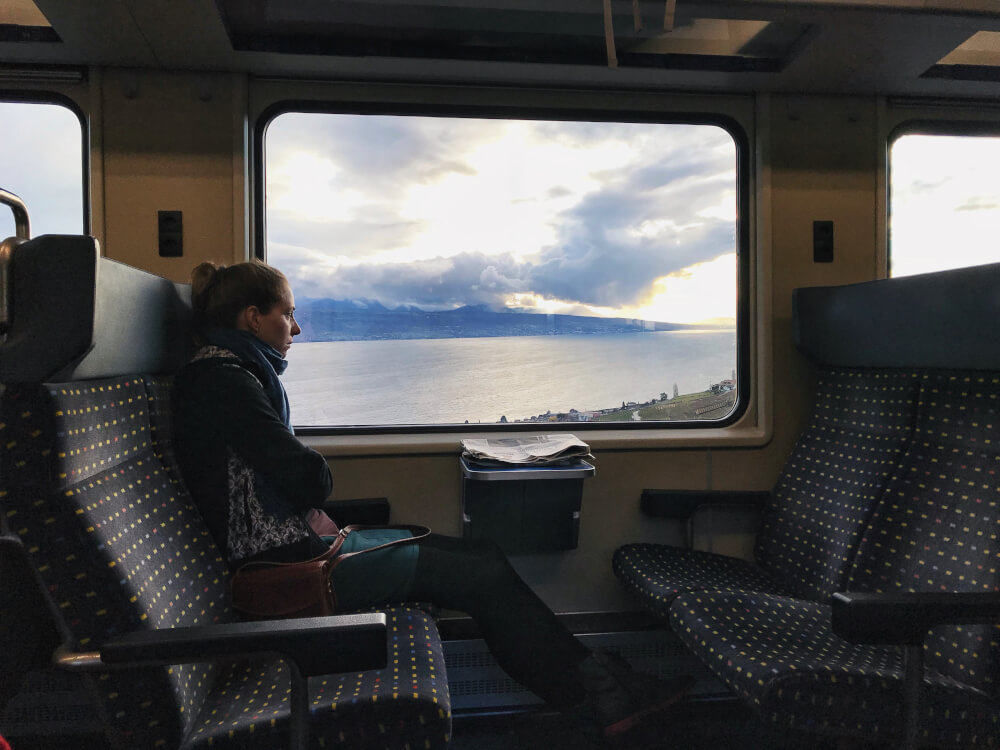
Amazing Swiss Train Rides Still on My Bucket List
Last but not least, there are a handful of Switzerland scenic train rides that I still haven’t had a chance to do, but it feels weird to exclude them in a roundup of Switzerland’s best train rides, so here they are below:
11. Erlebniszug Rheinschlucht
Imagine riding along the Rhine Gorge in an OPEN TRAIN, with all the fresh smells and sounds of nature hitting your senses directly.
I caught a glimpse of this yellow beauty while on the Glacier Express and I just about lost my mind and demanded that they stop the train immediately so I could transfer.
Unfortunately, the Erlebniszug Rheinschlucht is only available in the summer (which I guess makes sense) but it’s nonetheless something I would love to try someday. Click here for more details (and photos!)
Of all the scenic train rides in Switzerland, there are very few that allow you to experience it all completely open-air, so definitely put this one on your list!
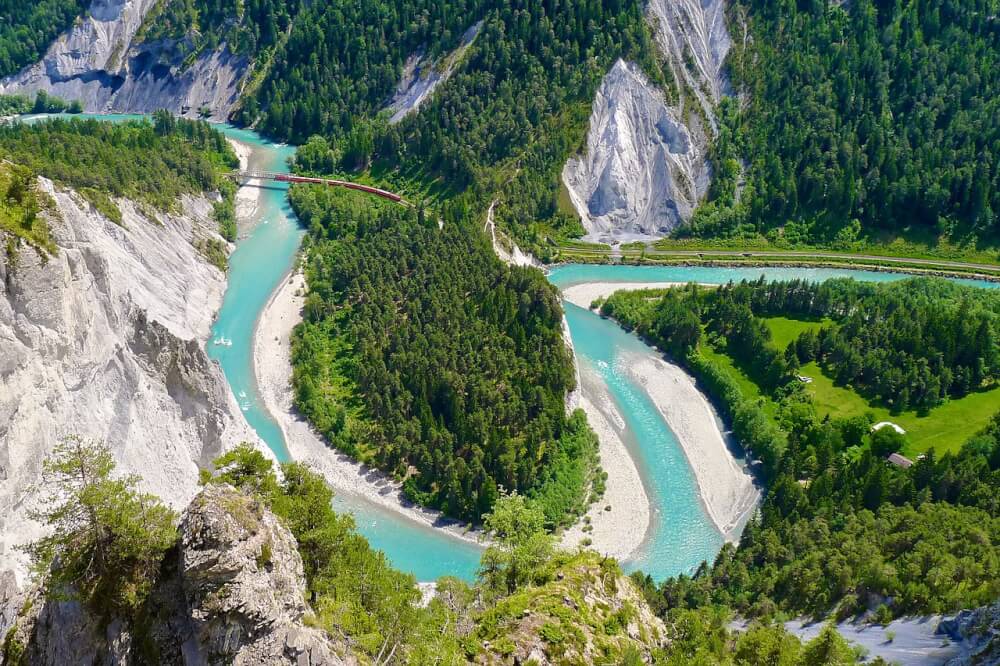
12. The Cogwheel Train up Mount Pilatus
With a title like “the steepest cogwheel train in the world” you can expect the ride up to Mount Pilatus to be pretty special.
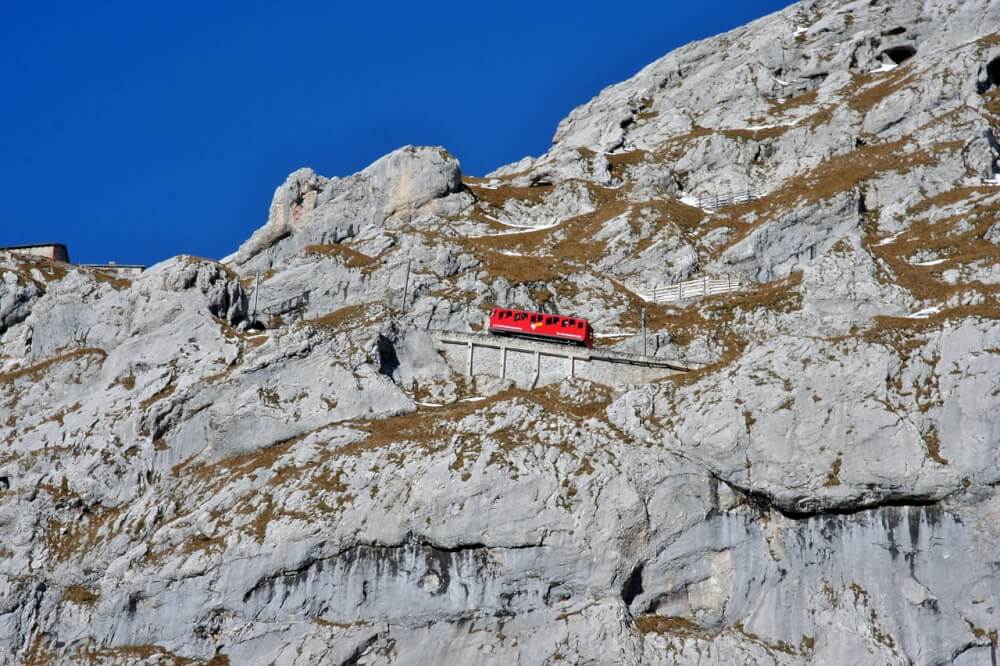
Mount Pilatus is one of my favourite mountains in Europe, and because my visit a few years back was veeery poorly timed (snow delayed the opening of the cogwheel train by a week!), I missed the opportunity to ride this steep monster up to the top.
Nonetheless, my consolation prize was sweet enough: a scenic ride up by cable car, with access to incredible views the entire way up.
The next time I’m in the area, I’ll be sure to catch the Cogwheel train to the top instead, experiencing a nerve-rackingly steep ascent that I’m sure will make me cry a little….. but in a good way!
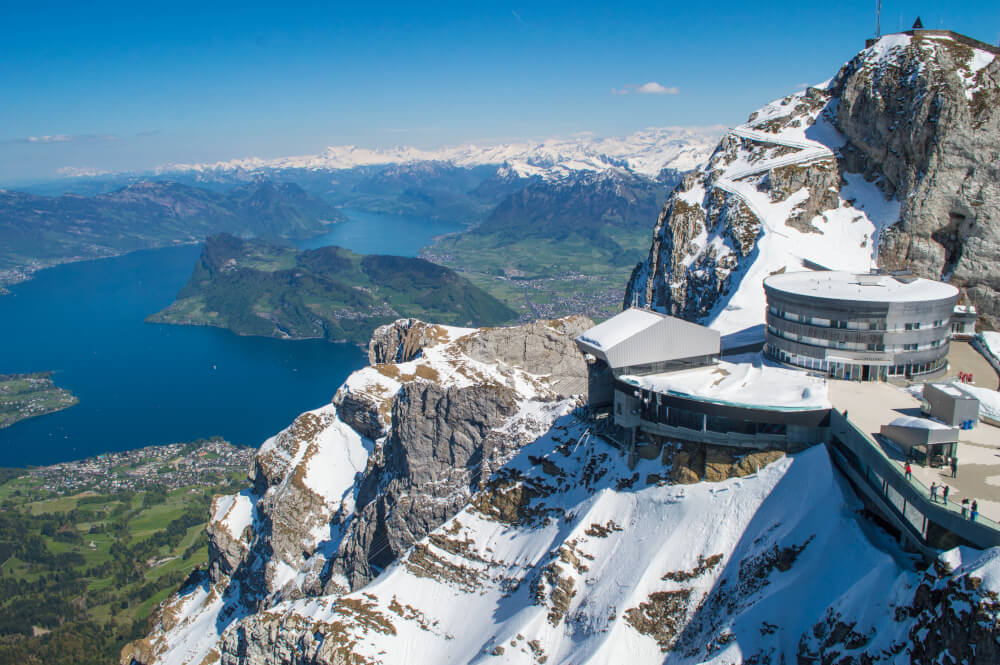
13. Jungfraujoch
Last but not least, we have the legendary Jungfraujoch.
The train ride up to Jungfraujoch brings you to the highest train station in Europe, passing by endless snowy peaks along the way (if your views aren’t obscured by poor weather that is!).
Truthfully, I’ve resisted doing the Jungfraujoch thus far for two simple reasons: cost and uncertainty!

At an eyewatering 200CHF for a regular roundtrip ticket, this is one trip that does NOT come cheap, certainly when bad weather might mean you don’t see anything at all once you reach the top.
Nonetheless, it’s a bucket list item for sure, and one that I’d be keen to test out sometime in the future, as I have heard great things about it. I did part of this journey (which for most, starts in Interlaken) from Lauterbrunnen to Wengen which was short and slow, but very nice.
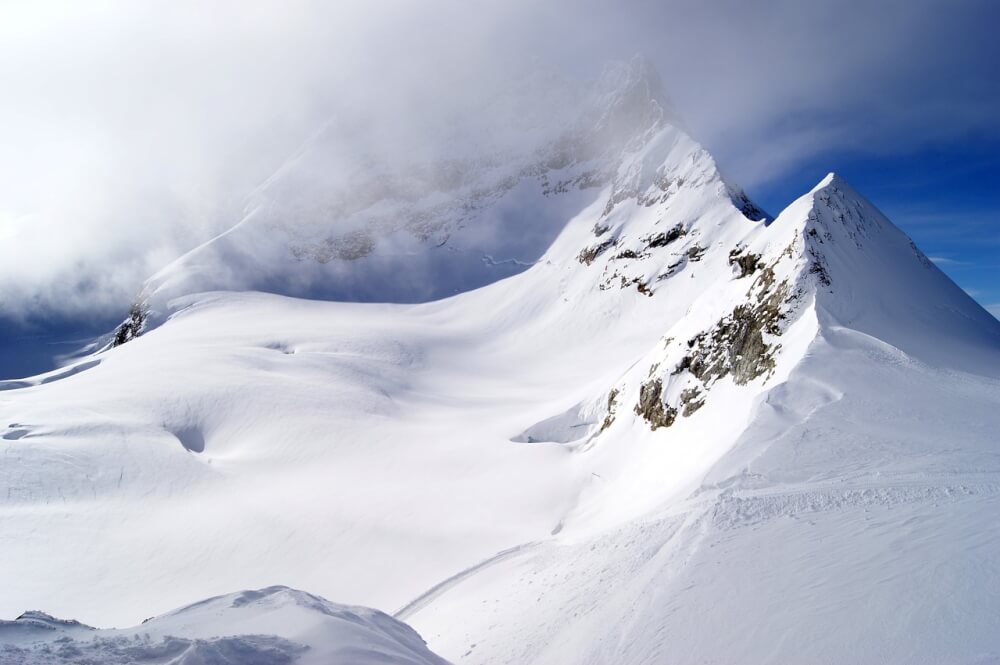
BONUS: The Gelmerbahn
No roundup of amazing Switzerland train journeys would be complete without this one, even though it’s brief and not quite a conventional train ride.
Nonetheless, the Gelmerbahn (AKA the Gelmer Funicular) is a truly epic ride that deserves a mention on this list.
This surprisingly thrilling ride is an open air funicular that whisks you up a steep mountain to a crystal clear turquoise lake.
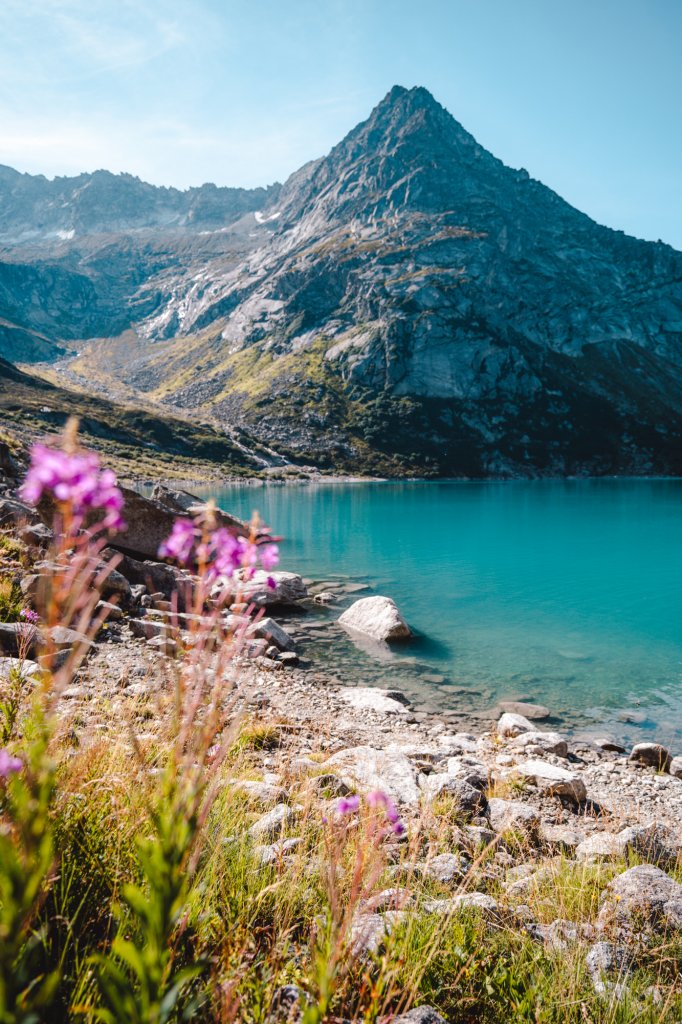
The incline is so steep, it was once the steepest of its kind in Europe, and moves 2m per second, which doesn’t sound like a lot, but definitely feels like it when you’re racing up a mountain.
You can take the Gelmerbahn up (which is what we did), down (which I hear is much scarier) or roundtrip. Either way, the unique experience, views, and lake up top all combine to make this one of the coolest Swiss “train” rides you can do!
Read my full Gelmerbahn guide for more tips.
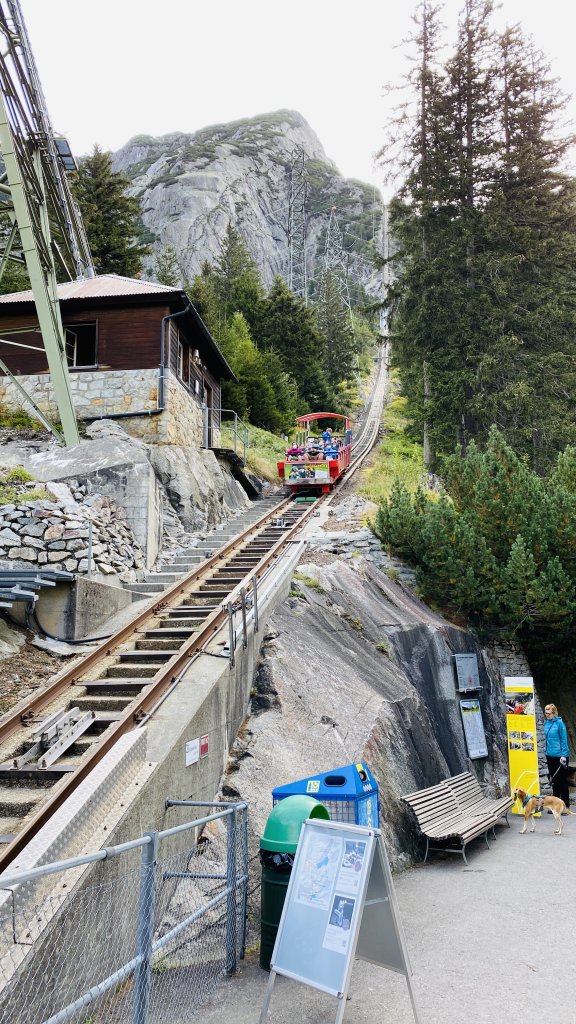
How to Buy Cheap Train Tickets in Switzerland?
Last but not least, I know what you’re all thinking after reading this post… how can you possibly afford all these Swiss scenic trains?
The tough truth is: enjoying Switzerland train travel is an expensive endeavour indeed, but I’ve been able to discover a variety of cost-saving hacks over the years that might be able to help you out!
TIP #1: Use a rail pass
One of the ways I’ve been able to explore Switzerland by rail SO cheaply is thanks to rail passes!
This is how I managed to scheme my way into only paying 30 euros for my 1st class tickets on the Glacier Express and Bernina Express!
Long story short, Eurail/Interrail passes allow you to waive the base ticket fee which means you only need to pay for a reservation. As such, I paid 306 euros for a Eurail global 10 day pass, (I got a free 1st class upgrade thanks to a sale they were running).
I then used 1 travel day on the Glacier Express, which evens out to only about 30 euros spent for this gorgeous ride (plus the 23 CHF reservation fee).
Still an incredible deal, and by far the cheapest way to do it. This is actually how I did all my recent train rides for a rock bottom price.
So, if you are travelling around Europe, getting a Eurail pass might be a good idea, because Switzerland is certainly where you get the best bang for your buck!
Need more info? Read my detailed Eurail pass review to see if it’s a good fit!

TIP #2: Consider a Swiss Travel Pass
A Swiss Travel Pass is similar to the Eurail / Interrail passes except it gives you unlimited transportation on trains, buses, boats and free public transport + museums).
If you are travelling only around Switzerland, this might be a good option.
It is expensive though, so make sure to do the math and see if getting one would really be worth it.
If you only plan to do one Switzerland train journey, buying a point to point ticket will most likely be cheaper. Click here for more info on the Swiss Travel Pass.
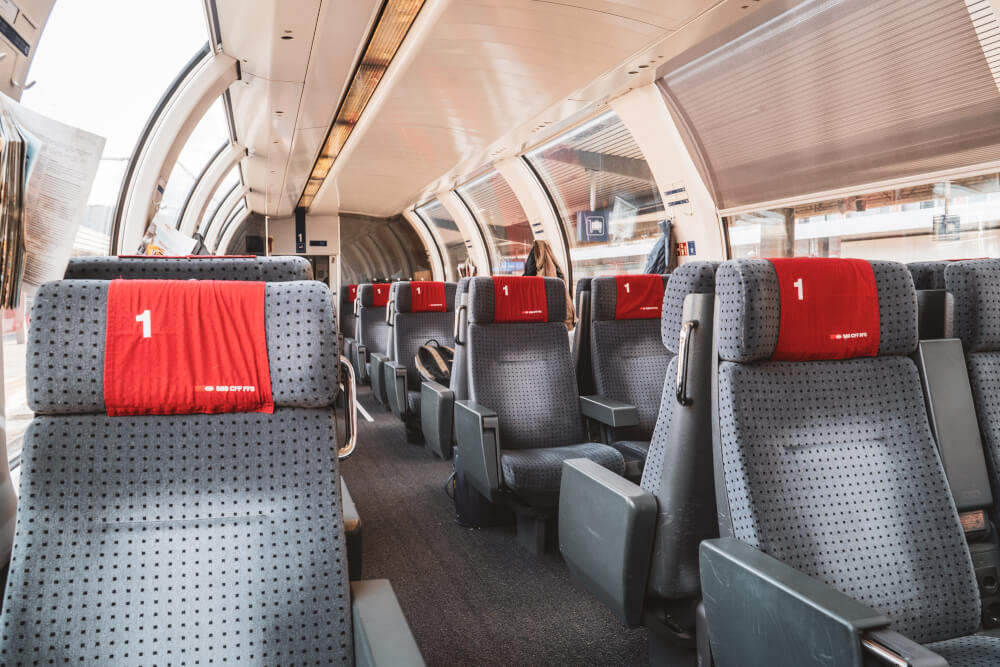
TIP #3: Consider getting a discount card
The Half Fare Travelcard is a very popular card that you can buy which (true to its name) gets you half price tickets across Switzerland.
In 2020, this card is 120 CHF for one month.
This sounds like a lot, but it could be worth it if you are spending an extended amount of time in the country and plan to take multiple Switzerland train trips throughout your stay.
For what it’s worth, if you were to use this card for the Glacier Express alone, you’d already be breaking even so if you take more trains on top of that, then you’d definitely save a good amount of money.
I still think buying a rail pass would work out to be cheaper though in most cases. Click here to browse prices/options for the Half Fare Travelcard.

TIP #4: Travel in the off-season
This tip is mostly just for the Glacier Express , but I’ll include it anyway.
While base ticket prices do not change, reservation fees for panoramic trains can change depending on whether you travel in the off, mid or peak season.
If you want to get the cheapest ride, go in the off-season which A) means guaranteed snow!! and B) half the price on a reservation.

Any more recommendations for scenic train rides in Switzerland?
I hope you enjoyed this post all about Switzerland train travel and the best Swiss railway journeys the country has to offer, assembled meticulously after many Swiss train trips of my own!
All that said, I’m always looking to add more Swiss trains to my list – especially hidden gems 😉
Let me know in the comments!
My Go-To Travel Favourites:
🧳 Eagle Creek: My favourite packing cubes
💳 Wise: For FREE travel friendly credit cards
🍯 Airalo: My go-to eSIM
🏨 Booking.com: For searching hotels
📷 Sony A7IV: My (amazing) camera
✈️ Google Flights : For finding flight deals
🌎 WorldNomads: For travel insurance
🎉 GetYourGuide: For booking activities
11 thoughts on “13 Magical Trains in Switzerland You Need to Ride ASAP”
Wowww the Golden Pass train is SO BEAUTIFUL
Oh my goodness! I am dying to go to Switzerland and your post confirms why. How stunning!
I’ve always dreamed of riding an old-fashioned train through Switzerland, so I think the Glacier Express is for me! The photos you captured through the train windows were breathtaking.
Wow, these look amazing. Would love to do one of those one day. Nothing quite beats the snowy Swiss scenery.
First of all, I didn’t realize that Switzerland had so many trains, but this proves me wrong! Now I need to go try them all!!!
Other scenic lines: Brig – Kandersteg – Spiez (this line climbs high from Brig along a track right next to the side of the mountains before going through and around the mountains. Beautiful views. A second great ride is (Luzern)- Arth/Goldau – Erstfeld – Göschenen – Bellinzona on the old line via the spiral tunnels. At the town of Wassen, the line circles around the little village and you get to see the quaint church three times from different heights and angles. On the other side of the Gotthard tunnel, in the Italian speaking Swiss canton of Ticino, there are more of these spiral tunnels and great views as the train circles slowly down to the valley floor.
https://www.myswitzerland.com/en-ch/voralpen-express.html This is a stunning train ride on a sunny day, definitely one for the list.
What a great article really well researched. I particularly agree with your tip about travelling on the local trains over the titled ones. I would add three trips to do should you return. The Brunig railway, Interlaken to Luzern, Martigny to Chamonix, the Mnt Blanc Express. The three mountain railway lines out of Aigle, I guess that makes it five then!
Great write up! This should help a ton in the coming weeks when we visit Switzerland. Thanks for putting this together!
You’re very welcome. Enjoy Switzerland! 🙂
Thank you for the great write up! Makes it easier for me to decide which rail ride to take. My trip is a year away and I am looking forward to it
Leave a Comment Cancel reply
By using this form you agree with the storage and handling of your data by this website. *
- Switzerland Tourism
- Switzerland Hotels
- Switzerland Bed and Breakfast
- Switzerland Vacation Rentals
- Flights to Switzerland
- Switzerland Restaurants
- Things to Do in Switzerland
- Switzerland Travel Forum
- Switzerland Photos
- All Switzerland Hotels
- Switzerland Hotel Deals
- Last Minute Hotels in Switzerland
- Switzerland
- Things to Do
- Restaurants
- Vacation Rentals
- Travel Stories
- Rental Cars
- Add a Place
- Travel Forum
- Travelers' Choice
- Help Center
Travel by train in Switzerland - Switzerland Forum
- Europe
- Switzerland
Travel by train in Switzerland
- United States Forums
- Europe Forums
- Canada Forums
- Asia Forums
- Central America Forums
- Africa Forums
- Caribbean Forums
- Mexico Forums
- South Pacific Forums
- South America Forums
- Middle East Forums
- Honeymoons and Romance
- Business Travel
- Train Travel
- Traveling With Disabilities
- Tripadvisor Support
- Solo Travel
- Bargain Travel
- Timeshares / Vacation Rentals
- Europe forums
- Switzerland forum

Can we take a train from the Geneva airport to downtown Geneva? Thanks for any help.
6 replies to this topic

Hello Laurie,
Swiss Travel Pass or Swiss Half fare card, one or the other. Which one depends of your transfers and activities (museums, mountain transportations).
Great info! Thanks for your reply.
Now, can I also use this pass on trains to other cities?
Unless you are museum goers it is more than likely that the Half Fare card combined with Saver Day Passes for longer travel days will be cheaper than the STP. Especially if you are going to the Oberland and then to the Jungfraujoch .... HFC = 50% off all transport including cable cars etc in most places. Would be helpful if you would post your full itinerary here and then we can comment further.
1 night in Bern , 2 nights in Luzern and 2 nights in
Zurich . Then we join a tour.
Any thoughts about traveling from city to city?
Take the trains.
Lausanne is the last place I suggest for tourists because of the topography. It is hard to figure out. And the centre is a long way from the lake. Montreux and Vevey are far better. Plus there is no sense in staying in Bern and Luzern and Zürich - they are all an hour by train from each other. Stay in Luzern and then make day trips to Bern and to Zürich.
There is no other way to travel between towns than the train. Renting a car makes no sense. It will be parked all day (city centres in many cases are pedestrian/public transport only and parking is expensive.
Don’t you want to go to a mountain village??
- July travel and A/C 1:44 pm
- Need a urgent help 1:38 pm
- Driving through Switzerland and staying in airbnbs for say 9 1:30 pm
- Does this sound like a good itinerary-flexible options 1:22 pm
- Geneva city pass 1:05 pm
- Wonderful advice 12:29 pm
- Transportation To Birg without Schilthorn 12:23 pm
- Driving from Zurich to Lausanne and back 11:56 am
- We want to see cheese making while in Murren or Lucerne 11:52 am
- How to Read the C12 Bus Schedule from Lugano to Menaggio 10:11 am
- Itinierary and transport recommendations please 10:08 am
- Zurich Euro 2024 9:40 am
- Itinerary advice for 11 nights 9:28 am
- Best chocolate tour/class 9:12 am
- best time to visit Switzerland 7 replies
- Best place to visit Switzerland in July 2 replies
- Factory Outlet 5 replies
- Weather in December 4 replies
- Basel to Geneva by Train 8 replies
- Switzerland in december 7 replies
- Switzerland in November 4 replies
- VAT Tax Refund 146 replies
- Swiss Trains 1st Class vs 2nd Class 10 replies
- Cost of food 8 replies
- Information about the Corona Virus (COVID_19) in Switzerland
- [0] How to use these Top Questions
- [1] News & important updates 2022
- [2] Introduction & basic information
- [3] Before you start to planning your trip
- [4] Public transport in Switzerland
- [5] Scenic trains & postal bus routes
- [6] Driving in Switzerland
- [7] Hiking and sightseeing
- [8] Arriving or leaving by Rhine river cruise
- [9] Christmas markets / Christmas / New Year
- [10] Posts and blogs from travelers
- [11] Trip Reports
- [12] Trip Reports (continued)
- [13] Trip Reports (continued)
- [14] Trip Reports (continued)
- Why aren't trains running Spiez/Visp/Brig - Milan in June - September 2024?
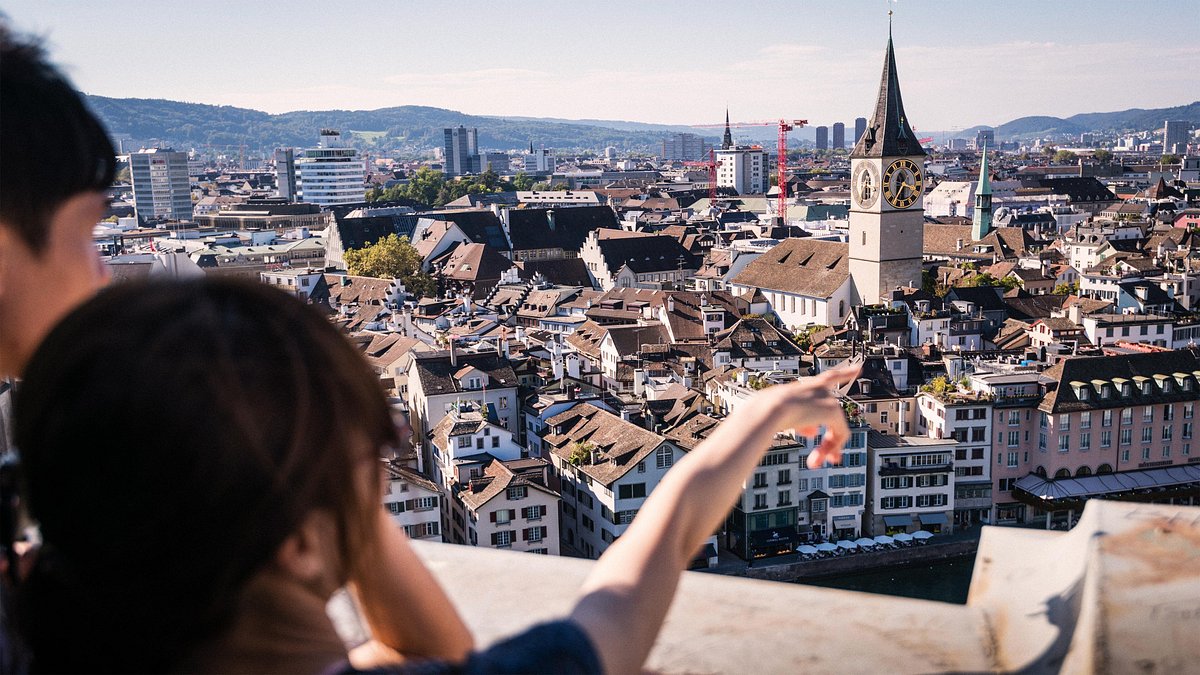

How to Get Around Switzerland: A Guide to Swiss Transportation
Wondering how to get around Switzerland? This guide will help you learn how to use the public transportation system and how to get around by car.
Don’t have time to read a bunch of reviews and blog posts? Here are our top picks for visiting Switzerland:
Wanderlust switzerland guide.
Need a quick day-by-day, open-and-go itinerary for Switzerland? Get my guide and let me do the work for you!
Our favorite Hotels in Switzerland
- Zurich : Baur Au Lac
- Lucerne : Burgenstock Alpine Hotel & Spa
- Zermatt: The Omnia
- Interlaken : Victoria Jungfrau Grand Hotel
- Bern : Hotel Schweiserhof
- Geneva : Swiss Luxury Apartments
- Montreaux : Eurotel Montreaux
Getting Around Switzerland
- Unlimited Train Rides : Swiss Pass
- Renting a Car : Cheap Rental Cars or Expedia Cars
Our favorite activities and tours in Switzerland
- Paragliding
- Lindt Chocolate Tour
- Lake Lucerne Cruise
How do I get around Switzerland?
There are many ways to get around Switzerland , the two main ways are using public transportation and renting a car. I’ll highlight the best way to get to each destination below. This Switzerland itinerary can easily be used with either a car or by train.
If you choose to get a rental car in Switzerland, I always recommend using this site to compare rates and cars.
If you choose to use public transportation in Switzerland, I recommend getting the Swiss Travel Pass to maximize your time and save you money. The Swiss Travel Pass offers unlimited train rides on most lines, free or discounted gondola rides, and discounts to many attractions though Switzerland.
I find that it’s especially worth buying the Swiss Travel Pass if you are planning to visit Zermatt because the expensive Gornergratt train is quite expensive, and it’s half off with the pass. If you’re comfortable riding trains and buses, I think it’s the best way to travel in Switzerland.
Where do I purchase my Swiss Travel Pass?
You can purchase your Swiss Travel Pass here . Just select the correct number of days for your Switzerland itinerary and check out. The pass begins on your selected date and runs continuously. The Swiss Travel Pass comes in. 3, 4, 6, 8, and 15 day increments.
Swiss Half Fare Card
If you’re unsure of your dates or the amount of time your Switzerland itinerary will be, it might be a good idea to purchase a Swiss Half Fare Card instead. This pass is good for one month and will offer 50% off most trains. There seems to be less of a discount on shorter journeys. I prefer to purchase the more expensive Swiss Travel Pass just for ease of use while I am in the country. But the Swiss Half Fare Card may be a better option if you are only planning on taking several long and expensive rail journeys. You can purchase the Swiss Half Fare Card here .
Renting a Car in Switzerland
If you want a little more freedom during your trip, you may want to consider renting a car in Switzerland . You’ll have the ability to reach some more off-the-beaten-path places that trains can’t reach. Driving in Switzerland is easy, especially if you’re from the US because they drive on the right side of the road.
Download the SBB App for Switzerland Transportation
SBB App – Public transportation in Switzerland is shockingly punctual, clean, fast, and efficient. The SBB app will tell you when and where to get your trains and buses to take you where you want to go. This is the most important app you’ll need in Switzerland if you’re only traveling by public transportation.
I hope this guide to Switzerland transportation will help you get around the country with ease. Be sure to check out the most beautiful places in Switzerland and our Switzerland Itinerary.
There are lots of pros and cons to renting a car in Switzerland and using public transportation. Here’s a good list
Here is a list of pros and cons for traveling Switzerland by train vs. by rental car:
Traveling by Train in Switzerland
- More scenic views out the window
- Can relax and enjoy the ride
- No need to focus on driving/navigation
- Environmentally friendly
- Arrive directly in city centers
- Less flexibility with schedule/stops
- Can be more expensive
- Limited luggage space
- More flexibility with schedule and route
- Can stop wherever you want
- Usually cheaper than train
- More privacy
- Can carry more luggage
- Less scenic views
- Have to focus on driving
- More planning required for navigation
- Have to find and pay for parking
- More environmental impact
I hope this helps you plan your trip to Switzerland!
The post How to Get Around Switzerland: A Guide to Swiss Transportation appeared first on Wanderlust Crew .
![Wondering how to get around Switzerland? This guide will help you learn how to use the public transportation system and how to get around by car. How do I get around Switzerland? There are many ways to get around Switzerland, the two main ways are using public transportation and renting a car. I’ll highlight the [...] Wondering how to get around Switzerland? This guide will help you learn how to use the public transportation system and how to get around by car. How do I get around Switzerland? There are many ways to get around Switzerland, the two main ways are using public transportation and renting a car. I’ll highlight the [...]](https://img-s-msn-com.akamaized.net/tenant/amp/entityid/AA17Mj4i.img?w=768&h=512&m=6)

IMAGES
VIDEO
COMMENTS
Flexible booking options. World Travel and Tourism Council's Safe Travels badge endorsed. Explore Switzerland on a well organised itinerary with all the details taken care of.
Save Time & Money with the Lowest Prices & Latest Reviews on TripAdvisor. Search Now!
Ultimate Guide to Train Travel in Switzerland (2024 Update) In Switzerland, train travel is more than a simple mode of transportation. Granted, thanks to the world's most dense public transportation network, the Swiss travel more kilometers by train than any other country. The Swiss trains, trams, buses, and boats are meticulously scheduled ...
A Swiss Travel Pass (continuous or flex) gives you unlimited free travel on all the train, bus & ferry routes shown as solid red, yellow or black lines on the map. Swiss Travel Passes give you a 50% discount (not free travel) on the routes shown as dotted red, yellow or black lines. One thing that confuses people: A solid line becomes a dashed ...
The rail network in Switzerland Switzerland's extensive train network. Switzerland has a fantastic rail network with rail stations in many towns and villages. Rail stations are usually in the town center. Local attractions can mostly be reached on foot. Details can be found on the map of Switzerland. Additional buses and other transport modes
The advantages for you. Unlimited travel by train, bus and boat. Unlimited travel on premium panorama trains (seat reservation fees and/or surcharges apply) Unlimited use of public transport in more than 90 towns & cities. Free admission to more than 500 museums. Link opens in new window. Mountain excursions included: Rigi, Stanserhorn and Stoos.
Mt. Rigi: 50 percent off all trains and lifts above Vitznau/Arth-Goldau/Weggis (full price: $25-40 per leg) Lake boats: 50 percent off most boat trips, but Lake Thun and Lake Brienz boats are fully covered. Free kids: Up to two kids age 4-11 travel free with each adult-rate pass.
The alps and the rail network remain very impressive, even after all these years. How to travel by rail in Switzerland: must-read info about the timetable, finding your way on the station, tickets, 1st and 2nd class, and more.
Wengen to Kleine Scheidegg (mountain train) - 25% covered by Swiss Pass. Interlaken to Murren (either via Lauterbrunnen valley bus or Grutschalp cable car) - 100% covered by Swiss Pass. Interlaken to Grindelwald (train) - 100% covered by Swiss Pass. Grindelwald to First (cable car) - 50% covered by Swiss Pass.
Discover the beauty and diversity of Switzerland with Swiss Travel Passes, the official ticket shop for Swiss rail tickets. Book online and enjoy unlimited travel by train, bus and boat across the country. Compare prices and benefits of different passes and find the best one for your trip.
Taking the Train in Switzerland . If you are only taking a few train trips in Switzerland, you can most likely get by with point-to-point tickets, as opposed to a travel pass. To buy these, you'll use the Swiss Federal Railways (abbreviated SBB) website. SBB runs regional (R, RE, and IR) trains throughout the country, as well as S-Bahn commuter ...
By calling the SBB (Swiss railways) booking center. +41 0848 44 66 88 (open 24/7). You will get a direct connection when calling this booking center. The Swiss SBB booking center can deliver your reservations to all European countries. Delivery costs are CHF8 (approx. €6.50).
For foreign guests, the all-in-one ticket Swiss Travel Pass is the key to Switzerland's public transport network. This single ticket enables visitors to explore Switzerland from end to end by train, bus and boat on 3, 4, 6, 8 or 15 consecutive days. With the Swiss Travel Pass Youth, young people up to their 25th birthday travelling through ...
Step 1: Make a list of travel plans. This step is important, as you can only pick the cheapest pass if you have a detailed idea about all your travels. Make a list of each trip you intend to make and include: transfers from the airport or Swiss border to the (first) town where you stay, and back;
Switzerland Itinerary. Traveling Switzerland by rail gives you a front-row seat to one of the most beautiful countries in the world. Its mountain ranges are ideal for skiing or hiking and provide amazing backdrops to the cities. If the scenery isn't enough, try the country's world-class products. Just think: Swiss cheese, Swiss chocolate, Swiss ...
Scenic - Switzerland would have to be one of the most beautiful places in the world to travel by train - the landscape is absolutely perfect for train travel. The Swiss rail network goes right past the most scenic landscapes including all the stunning lakes, snow capped mountains, flowing streams and quaint little villages.
Monthly info and offers from SBB. Subscribe now. ImprintLegal informationData protectionAccessibilityCookie settings. Half Fare & GA Travelcards, tickets, excursions, city breaks, event tickets & information on stations, disruptions & the timetable.
Travelling through Switzerland by train is very easy and comfortable . Budget - There's no getting around the fact that Switzerland is an expensive country. However, the Swiss Travel Pass is an amazing way of travelling around and keeping costs down. It's actually remarkable value for money. Sustainability - One of the buzz words in Switzerland at the moment is Swisstainability.
The Swiss Travel Pass Flex offers a set number of travel days (3, 4, 8 or 15) in a given time period (1 month). On your travel days, which don't need to be consecutive, you can take as many trains as you want. With the Swiss Travel Pass Flex, you can also get discounts on Swiss attractions and museums. From CHF 267*.
Regular IC ( InterCity) trains between Zurich and Stuttgart, travel time 3 hr. Regular EC ( EuroCity) trains between Zurich and Munich, travel time 4 hr. Regular RJ ( RailJet) trains between Zurich and Innsbruck (3½ hr), Salzburg (5½ hr), Vienna (8 hr) in Austria, and further to the east.
Click on each of the routes in our map below to check journey times and ticket prices. Red routes - High-speed trains. Green routes - Regional trains. Blue routes - Scenic trains. Most Swiss trains are operated by SBB, which provide different types of trains. For example, the 139-mile route from Zurich to Geneva is served by InterCity ...
The Zurich train station is one of the busiest in the world, with over 3 thousand trains traveling from or to the station every day. Switzerland's national railway company is the Swiss Federal Railways. It is the largest railway and transport company in Switzerland, and it covers approximately 3260 km of the railway as of 2020.
Having just returned from a whirlwind binge of Switzerland's most scenic trains, I can say without an ounce of exaggeration that the Swiss train system is a true marvel of magic.. And beyond their surplus of scenic routes, razor-sharp punctuality and Care Bear-friendly service, the crowning jewel of the Swiss rail system is, in my opinion, its glittering roster of scenic, panoramic Swiss ...
Information about the Corona Virus (COVID_19) in Switzerland [0] How to use these Top Questions [1] News & important updates 2022 [2] Introduction & basic information [3] Before you start to planning your trip [4] Public transport in Switzerland [5] Scenic trains & postal bus routes [6] Driving in Switzerland [7] Hiking and sightseeing
3. It's quicker to travel by car. Whether car or train traveling is quicker in Switzerland, depends on the route, day, and time. Trains are often quicker for longer journeys. If you travel from one smaller town to the other, the car is often faster. In all, there's no big difference between car and train time-wise.
The Swiss Travel Pass offers unlimited train rides on most lines, free or discounted gondola rides, and discounts to many attractions though Switzerland. ... Here is a list of pros and cons for ...
The share of commuters who travel to work using public transport (as the main mode of transport) is 30%. The share of rail in goods transport performance by road and rail (modal split) is 39%. ... The Glacier Express (here on the Landwasser Viaduct) is the longest distance train in Switzerland. It runs from Zermatt to St. Moritz, on both MGB ...